
CHALLENGE FOR GRIZZLIES 100 DAYS YELLOWSTONE TO YUKON BONDED BY THE RIVER HEMINGWAY'S Cooke City Revival CONRAD ANKER COMMUNITY WILL SAVE US

2 EST. 1997 Big Sky, MT bigskybuild.com 406.995.3670 REPRESENTING AND BUILDING FOR OUR CLIENTS SINCE 1997
We have dedicated our lives to service. In fact, our brand is more than a story, it's part of American history.



Authentic, All-American and Award winning. It is our legacy in a bottle.
Official Bourbon Sponsor horsesoldierbourbon.com



 San Francisco World Spirits Competition 2022
©2023 American Freedom Distillery. All rights reserved.
San Francisco World Spirits Competition 2022
©2023 American Freedom Distillery. All rights reserved.







4
“O
ering clients a great place to shop as well as a home design showroom.”
Jodee March
Owner/ Interior Designer
Are you ready to Svalinn love?
Svalinn breeds, raises and trains world class protection dogs. Choose a Svalinn dog and you’ll be getting real peace of mind in the package of a loyal, loving companion for you and your family.

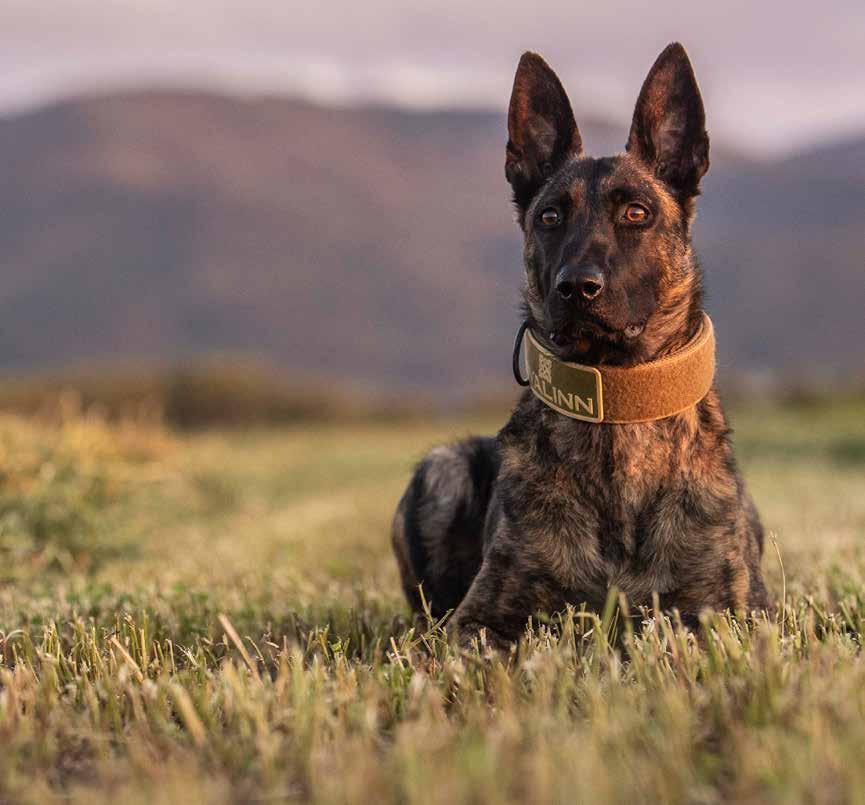
5
svalinn.com 406.539.9029 Livingston, MT



BOZEMAN | BIG SKY | LIVINGSTON | ENNIS | BUTTE © 2023 Engel & Völkers. All rights reserved. Each brokerage is independently owned and operated. All information provided is deemed reliable but is not guaranteed and should be independently verified. Engel & Völkers and its independent License Partners are Equal Opportunity Employers and fully support the principles of the Fair Housing Act. www.montana406.com www.evranchland.com Your Bespoke Montana Real Estate Firm



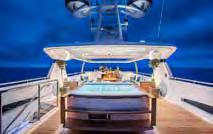





7 FIND Chasing billfish in Costa Rica or Cabo or relaxing along the Emerald Coast of Florida, Jimmy Azzolini, Big Sky resident, is your authority on yacht ownership. Jimmy has been with Galati Yacht Sales, the largest family-owned yacht brokerage firm worldwide, since 2000. During this time, Jimmy has helped countless families match the right yacht to their lifestyles. Find out more about yacht ownership and how Jimmy and Galati Yacht Sales can help you create new memories. JIMMY AZZOLINI LICENSED + BONDED YACHT BROKER 850.259.3246 SCAN HERE TO LEARN MORE FL | AL | TX | CA | WA | MX | CR WWW.GALATI YACHTS .COM
FEATURES
31
COMMUNITY IN CONTEXT
Photos by Hazel Cramer and Christopher Boyer
Two Montana photographers put Community in Context with aerial photos shot from the belly of Chris Boyer’s red 1956 Cessna plane, and Hazel Cramer’s intimate portraits of the same towns from the ground. These visual profiles of Lame Deer, Anaconda and Big Sky invite us to contemplate the meaning of community.

78
THE BIG TWO-HEARTED RETREAT
By Toby Thompson
One of the most recognized American novelists in history, Ernest Hemingway is among literary scholars’ greatest curiosities. At the 2022 Hemingway Society Conference, scholars, writers and other prolific figures gathered in Montana’s rustic Cooke City to examine the writer’s relationship to the wild landscape of Montana and Wyoming, exploring topics from gender and sexuality to Hemingway’s affinity for killing at The Big Two-Hearted Retreat.
102
THE ARENA OF CHALLENGE FOR GRIZZLIES
By Benjamin Alva Polley
Amidst what experts describe as one of the biggest conservation wins in history, grizzly bear recovery in certain ecosystems has officials reevaluating the iconic bruins’ decades-old protection under the Endangered Species Act. In The Arena of Challenge for Grizzlies, stakeholders debate the species’ fate.
152
THE LANGUAGE OF BELAY
By Bella Butler
One of the greatest climbers in history, Conrad Anker has spent decades completing first ascents and notable mountaineering feats around the globe. Now, at age 60, the Bozeman local is translating The Language of Belay to the concept of community.
8
Cowboys at Big Sky PBR take a break from pirouetting off the backs of bulls for a quiet game of hacky sack behind the chutes. The annual summer event, produced by Outlaw Partners, pits the best bulls against the best cowboys and began 13 years ago in a sagebrush field, since growing to win 9x Event of the Year and gathering the community for a week of celebration each July. Photo by Tom Attwater.

9
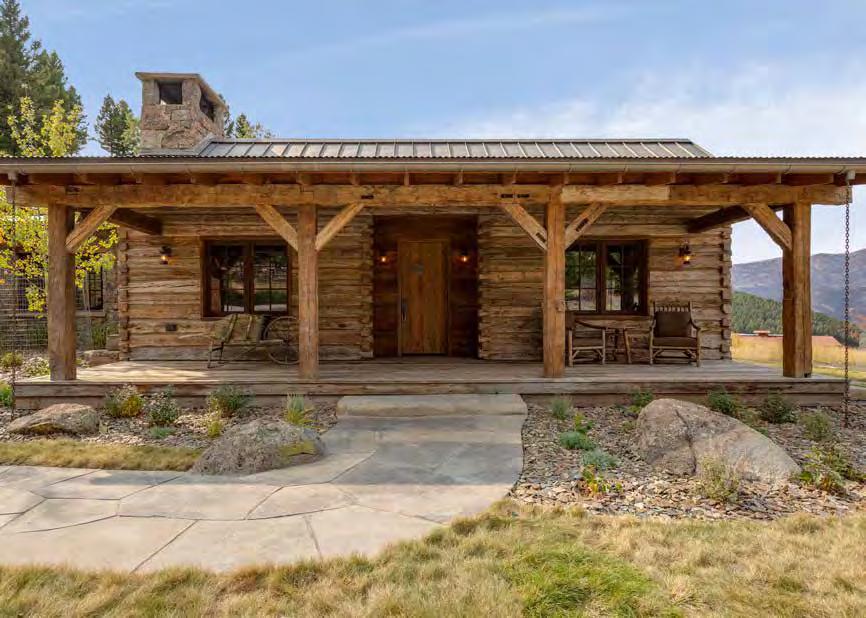
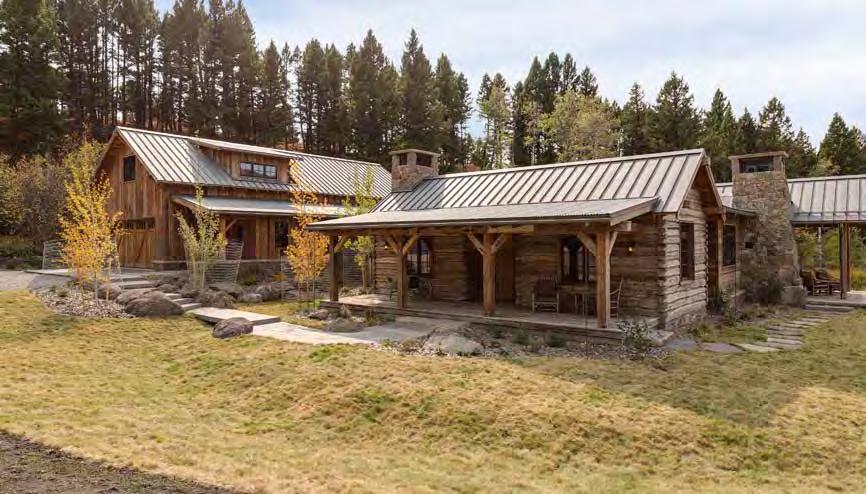
2010 GILKERSON DRIVE, BOZEMAN, MT 59715 | SBCONSTRUCTION.COM | 406.585.0735


GENERAL CONTRACTING FOR LUXURY REMODELING & NEW CONSTRUCTION pjourney@jandsmt.com | 406.209.0991 | www.jandsmt.com WE CARE ABOUT EVERYTHING WE DO
DEPARTMENTS
TRAILHEAD
22 R EAD: Holding Fire reckons with the West’s bedrock of violence
22 R EEL: Wild Life braids love, conservation and culture
23 EVENT: Wildlands brings Grammy-winning artists to the stage of conservation

24 CAUSE: Big Sky’s pay-what-you-can art classes build community
25 V ISIT: Legacy Bike Park is northern Montana’s new playground
OUTBOUND GALLERY
31 Community in Context: Putting three Montana towns in perspective
ADVENTURE
60 A Tale of Two Treks to Montana’s Medicine Point Lookout
66 Running the Grand Canyon, rim to rim to rim
68 Two women (and one dog) embark on an iconic 3,000-kilometer traverse
ROOTS
78 A Cooke City conference revives the rough and rugged Ernest Hemingway
86 Branding in Montana
90 Montana’s Williams family and a legacy of service
ENVIRONMENT & OUTDOORS 102 Grizzlies confront Endangered Species delisting 112 Building connection—and bike trails—in Big Sky 117 Thirty years protecting the Yellowstone to Yukon wildlife corridor 122 A community of river people SOCIETY 135 An outlook on Montana’s news landscape 142 A city boy’s introduction to the West 146 Turning waste into gold FEATURED OUTLAW 152 Conrad Anker reflects on community LAST LIGHT 168 Northern Lights
12
Montana artist Satsang performs in Big Sky, Montana, in June 2022 at Music in the Mountains. The first concert in the free summer series was a celebration of late Big Sky community members Mark Robin and Eric Bertelson, who both passed away from ALS. The annual event, known as Soulshine, gathers visitors and locals alike to remember these impactful people, and to celebrate community.

13
Photo by Gabrielle Gasser.


“WE’LL KNOCK OUT YOUR FLOORS IN 1 DAY” koconcretecoatings.com SCAN HERE FOR MORE INFO



15 406.993.6949 | bigskynaturalhealthmt.com | 87 Lone Peak Dr, Big Sky, MT Owned and operated by Dr. Kaley Burns, ND, Big Sky’s Only Naturopathic Doctor WHAT’S MORE IMPORTANT THAN YOUR HEALTH? Schedule Your Appointment Now! PRIMARY CARE NUTRIENT & REGENERATIVE IV THERAPY WELLNESS & NUTRITION
Owned and published in Big Sky, Montana.
PUBLISHER

Eric Ladd
MANAGING EDITOR
Bella Butler
ART DIRECTOR
Robyn Egloff
PRODUCER
Mira Brody
COPYEDITOR
Carter Walker
ASSISTANT EDITOR
Tucker Harris
ART PRODUCTION
ME Brown
Trista Hillman
Corey Ellbogen Beans
VIDEO DIRECTOR
Michael Ruebusch
CONTRIBUTING WRITERS
SALES & ADVERTISING
Ersin Ozer
Patrick Mahoney
Sophia Breyfogle
ACCOUNTING
Sara Sipe
Taylor Erickson
CHIEF MARKETING OFFICER
Megan Paulson
COO, VP FINANCE
Treston Wold
VP DESIGN & PRODUCTION
Hiller Higman
DISTRIBUTION
Ennion Williams
Mark McMann
Visit outlaw.partners to meet the entire Outlaw team.

featured contributors
Jason Bacaj, Amaya Cherian-Hall, Matt Crossman, Maria Lovely, Jeremy Lurgio, Christine Nichol, Benjamin Alva Polley, Jack Reaney, Bay Stephens, Dennis Swibold, Toby Thompson, Heather Waterous
CONTRIBUTING PHOTOGRAPHERS/ARTISTS
Tom Attwater, Dorothee Brand, Tristan Brand, Jake Burchmore, Chris Boyer, Amaya Cherian-Hall, Hazel Cramer, Frederick Coubert, Seth Dahl, Tom Fries, Gabrielle Gasser, Kyle George, Toni Greisbach, Aerin Jacob, Claire Jarrold, Maria Lovely, Jeremy Lurgio, Jim Peaco, Micah Robin, Stephen Simpson, Bay Stephens, Kent Sullivan, Madeline Thunder, Heather Waterous, Kenny Wilson
Subscribe now at mtoutlaw.com/subscriptions.
Mountain Outlaw magazine is distributed to subscribers in all 50 states, including contracted placement in resorts and hotels across the West. Core distribution in the Northern Rockies includes Big Sky and Bozeman, Montana, as well as Jackson, Wyoming, and the four corners of Yellowstone National Park.
To advertise, contact Ersin Ozer at ersin@outlaw.partners or Patrick Mahoney at patrick@outlaw.partners.
OUTLAW PARTNERS & Mountain Outlaw
P.O. Box 160250, Big Sky, MT 59716 (406) 995-2055 • media@outlaw.partners
© 2023 Mountain Outlaw Unauthorized reproduction prohibited
Check out these other outlaw publications:
ON THE COVER World-renowned alpinist Conrad Anker tops out on a climb in the Gallatin Canyon on May 13, 2023. This issue's Featured Outlaw, Anker reflects on a career in the climbing community and the lessons it has to offer. Read more on p. 152.
Jake Burchmore
The Language of Belay | p. 152
Jake Burchmore is a mountain lover, skier and photographer/ filmmaker based in Bozeman, Montana. He grew up in Telluride, Colorado, where he developed a passion for the outdoors and protecting the environment. As an artist and storyteller, Burchmore aims to captivate and inspire audiences toward positive change. Burchmore is a member of the Protect Our Winters Creative Alliance.
Maria Lovely
Lending a Hand | p. 86
Maria Lovely is a rugged, charismatic sixth-generation Montanan. She grew up in the mountains, attended school in a one-room schoolhouse, and still today spends every moment she can in the outdoors.


Hazel Cramer
Outbound Gallery: Communities in Context | p. 31
Hazel Cramer is entering her career as a documentary photographer and videographer. Passionate about raising awareness for humanitarian issues and underserved communities, she approaches her work with empathy and a critical eye. She was born in Seattle and graduated with a bachelor’s in multimedia journalism from the University of Montana. She lives in Bozeman with her roommates and plays outside as much as possible.
Benjamin Alva Polley
The Arena of Challenge for Grizzlies | p. 102
Benjamin Alva Polley is a placebased storyteller with stories published in Outside, Adventure Journal, Popular Science, Field & Stream, Esquire, Sierra, Audubon, Earth Island Journal, Modern Huntsman, and other publications at his website, benjaminpolley. com/stories. He holds a master’s in environmental science and natural resources journalism from the University of Montana.

16
from the editor
THE THINGS WE HOLD TOGETHER
You may be hearing the word community a lot these days. Especially in this post-pandemic world of new norms, we lean on this word in our adopted vernacular of resilience. But how could nine little letters fully grasp the complexity of such an innate and essential thing? Community is derived from the Latin communis, or “in common.” Certainly, community is about the things that make us alike: where we live, how we spend our time, how we identity ourselves. But it encompasses more than that.
When simple words fail us, I tend to seek the thoughts of our time’s greatest ponderers. I think author Terry Tempest Williams got it right during a 1995 radio interview:
“I think community is a shared history, it's a shared experience,” she said. “It's not always agreement. In fact, I think that often it isn't. It's the commitment, again, to stay with something—to go the duration. You can't walk away. It's like a marriage, only I think it's more difficult to divorce yourself from community than it is to a human being because the strands are interconnected and so various.”
What Tempest Williams’ words illuminate is that community is not the things we hold in common but rather the things we hold together. As she put it, it’s not just what we agree on, and “often isn’t,” but rather the intrinsic threads that join us together to carry the world’s paradox of weight and beauty. We can’t carry this on our own.
I got to witness this when we spent time with world-renowned alpinist and Bozeman local Conrad Anker, who we’re privileged to have as this issue’s Featured Outlaw (p. 152). Tucked back
in a primitive corner of the Gallatin Canyon, Anker spent the day attached by a rope to Manoah Ainuu, an up-andcoming climber from Washington who also lives in Bozeman. Anker is nearly 30 years Ainuu’s senior, and they each came to climbing byway of their own distinct paths. And yet, they are bound by such threads, united in a community that is founded in collaboration and support.
The stories that you hold here in your hand grasp the meaning of community that’s hard to explain, but so knowable in our bones. Benjamin Alva Polley touches on what community demands of us when we do not agree in his examination of a forthcoming decision on removing the iconic grizzly bear from the Endangered Species list (p. 102). Similarly, sixth-generation Montanan Maria Lovely writes about the things that bring us together in her piece on branding in rural Montana (p. 86): ritual, and how “in the act of serving, you lose sight of greed and ego.”
When we take time to feel for them, we are reminded of these interconnected strands that tie us to community. In his story River People (p. 126), our publisher Eric Ladd recounts a lifetime spent on rivers, and how these bodies of water have built his community—and keep him connected.
The stories in this publication do what a simple word can’t; they reflect the fullest expanse of community. They inspire us to engage with it; to build it, to lean on it, to appreciate it. I love story for this reason, and I love this issue for this reason. We hope you do, too.
With humble gratitude to our Mountain Outlaw community, thanks for reading.
Bella Butler Managing Editor
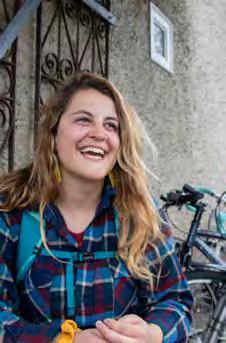
17

18 NATURAL. SUSTAINABLE. HEALTHY. SHOP & EXPLORE MEMBERSHIPS AT REGENMARKET.COM BISON · BEEF · LAMB · PORK · POULTRY DRY GOODS · FROZEN MEALS LOCAL GRASS FINISHED & PASTURE RAISED FRESH MONTANA FOOD, DELIVERED TO YOUR DOOR. Free 30 d ay trial!
ARROW RANCH |

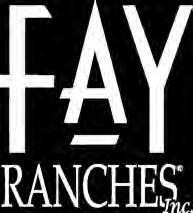
$38,514,500 | 14,982 ± acres
Explore
SHIELDS
$10,995,000 | 283 ± acres
Montana land for sale surrounded by breathtaking scenery, abundant resources, and diverse wildlife.

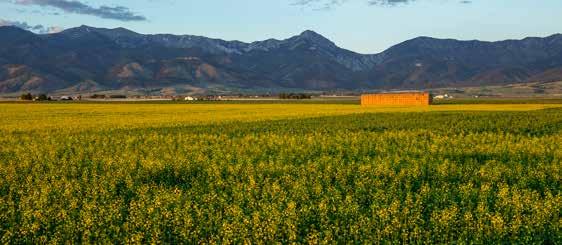

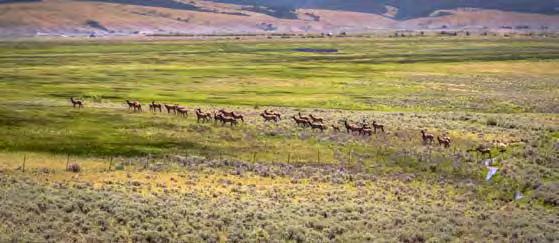
SPRING
$5,300,000 | 313 ± acres
If you are thinking of selling, buying, or just want to get our thoughts on the current real estate market, contact a member from our Bozeman office at your convenience.
$2,675,000 | 20 ± acres
19
the best
WWW.FAYRANCHES.COM | 800.238.8616 | INFO@FAYRANCHES.COM
BIG HOLE RIVER RETREAT | Melrose, MT
FAMILY FARM | Belgrade, MT
RIVER LODGE | Clyde Park, MT
Wisdom, MT


Stay Safe in Bear Country! Your bear awareness resource. Retail store & bear spray rentals. HEYBEAR.COM 11 Lone Peak Drive, Unit 104 Big Sky, MT 5973 LEARN MORE A BOUT OU R MISSION


STRAIGHT UP WHISKEY FROM A STRAIGHT UP PLACE. MontanaWhiskeyCo.com Enjoy responsibly.
TRAILHEAD
This summer we invite you, our readers, to experience community in the Rocky Mountain West through art and life. At this Trailhead, we point you in the direction of various mediums through which to experience our home, from films and books to nationally recognized events. Happy trails. —The Editors
Holding Fire: A Reckoning with the American West

To fully acquaint ourselves with the identity of our communities, we must intimately know their pasts. And to be a true member of these communities, sometimes we must challenge the narrative enforced by those pasts. In his 2023 memoir Holding Fire: A Reckoning with the American West, esteemed Montana author Bryce Andrews writes of his experience doing just that after he inherited his grandfather’s Smith & Wesson revolver, an event that forced him to confront the bedrock of violence which serves as the historical foundation for the iconic American West we know today: violence against wildlife, wilderness and the Indigenous peoples who have called the West home since time immemorial.
In honest prose, Andrews’ silver tongue creates a captivating narrative that is poignant in a time when the nation at large battles an epidemic of gun violence. In tandem with critique, the former Seattleite-turned-Montana-rancher explores how the West’s identity can evolve, and how its legacy doesn’t have to impede our ability to live better with the land and with each other.
Wild Life
As we as a species face the peril we’ve imposed on our planet’s wild spaces and their inhabitants, Oscar-winning filmmakers Jimmy Chin and Elizabeth Chai Vasarhelyi present a story about the fight for such places. An ode to the love story between conservationists Kris and Doug Tompkins, this National Geographic film, released in April, chronicles the former outdoor industry moguls’ departure from brand work to pursue the founding of several national parks in Argentina and Chile.
“On any scorecard, nature is losing,” Kris says in the film. Wild Life is an honest look at the couple’s quest to change that, and Kris’ perseverance in the wake of Doug’s death.
films.nationalgeographic.com/wild-life

22
Wildlands Festival
Community is one of the greatest catalysts we can summon for inspiring change, a truth that exists at the heart of the Wildlands Festival. Produced by Outlaw Partners, which publishes Mountain Outlaw, the festival joins people from near and far around Montana’s precious Gallatin River for three nights of live entertainment that will invigorate the Wildlands community with a passion to preserve the wild places outside that make us feel alive inside. This year it aims to serve as the largest-ever conservation effort for our life-giving rivers. The Wildlands Festival presents a lineup that supersedes anything else offered in the region. This summer, in its third year, the festival presents headliners Foo Fighters, Lord Huron and The Breeders, on stage on Aug. 5-6, and a charity dinner featuring actor Tom Skerritt, and comedians Orlando Leyba and Forrest Shaw on Aug. 4.
At the intersection of the 30th anniversary of Academy Award-winning film A River Runs Through It and the 50th anniversary of the highly influential river conservation organization American Rivers, Wildlands benefits American Rivers and the Gallatin River Task Force in their collective fight to save the Gallatin.
Produced in partnership with actor Tom Skerritt, Wildlands will by and large be the event of the summer, with an impact far transcending the three-day festival.
wildlandsfestival.com

23
TRAILHEAD
The Arts Council of Big Sky: Pay-what-you can art program


Amid sprawling development and high-tech chairlifts and recreation, resort towns are adding components to their communities that address liveability for the people working day and night to make the wheels turn. Among second homes and new hotels, affordable housing begins to pop up, and social services like food banks and behavioral health support are smattered between après parties and 12-hour shifts. In the community of Big Sky, one nonprofit is taking such offerings beyond basic needs, providing experiences that spark joy and inspire creativity.
The Arts Council of Big Sky last year launched the only pay-what-you-can art education program, which in its first year saw 1,000 registrations for classes spanning from pottery to woodburning. According to Arts Council Art Education and Public Director Megan Buecking, the program takes advantage of the unique economic structure of Big Sky that includes both people and funding mechanisms with deep resources as well as a population of people that benefits from supported opportunities. The program’s classes all advertise a suggested fee that covers operating costs for the class, but students have the option to pay more if they can—or less if they can’t. Because the class is available to everyone, not just the workforce, Buecking says it also builds community by introducing folks that otherwise might not interact in a peer-to-peer way outside of the studio.
Though the program is young, Buecking believes it has the opportunity to be scaled to other similar communities.
The Arts Council’s art education program is largely supported through donors and awards. Visit bigskyarts.com/give to learn more or support the effort.
24
Legacy Bike Park

A true homegrown dream come to life, Legacy Bike Park opened in 2021 on 175 acres near Lakeside in northwest Montana. The first of its kind in that region, the downhill bike park is gaining popularity, but daily capped ticket sales allow for a personal experience in a stunning landscape. With trails by Terraflow Designs that span all skill levels, the bike park is as much art as it is playground. Cut through a rustic evergreen basin, the flowy trails are designed with intention, built on the north side to keep the dirt cool and damp.
Legacy’s owners describe the young venture as being “in its infancy,” with more trails and offerings to come as the park continues to grow. Located in Montana’s beautiful Flathead County, the park also offers camping.
On any given day during the season, the park embodies community around sport, with riders high-fiving and swapping trail stories on the shuttle back up the hill. Legacy also epitomizes the sweet spot that captures recreation in Montana: five-star terrain with a personal, small-town feel.
legacybikepark.com
25
BLUE RIBBON LIVING





Introducing e Dri at North Forty. Twenty four residences in the storied town of Ennis, Montana— just minutes from the best shing and recreation opportunities that Montana has to o er.
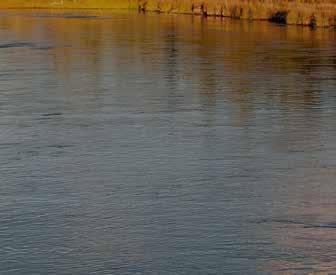

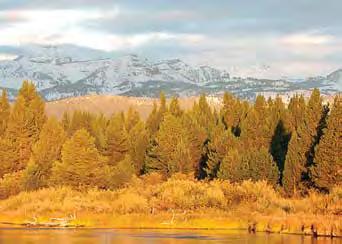




26
THEDRIFTRESIDENCES.COM
NEW LUXURY RESIDENCES


Cortina perfects the shared culture of pasta making, Italian craft, heritage chops and worldly wines around the warm hearth of an Italian steakhouse. Open daily, visit us at Montage Big Sky. For reservations, call 406-993-8142. MontageHotels.com/BigSky | 995 Settlement Trail | Big Sky, Montana Exceptional Epicurean Experiences, Warm Montana Hospitality.







28
LETS TALK.. Make the most of your summer with a relaxing getaway at our resort. A Montana vacation unlike any other, the Rainbow Ranch Lodge combines the rustic Wild West with classic elegant sophistication; a place where exceptional food, wine, and accommodations are our passion, and hospitality is instinctive. Welcome to our little paradise on the banks of the Gallatin River in Big Sky, Montana. www.RainbowRanchBigSky.com 42950 Gallatin Rd Gallatin Gateway MT 59730 406.995.4132 EXPLORE THE QUIET SIDE OF BIG SKY
RAINBOW RANCH LODGE


29 Devotion to your experience Precision in craft Design Build Project Management Client Representation bindinteriors.com 406.813.8381
Mastering The Art of 3 MPH
BE ADVENTUROUS | BE PRESENT | BE INSPIRED
5 Night + 6 Day
Premier Rafting Trips

Middle Fork Salmon River, Idaho
boundaryexpeditions.com

OUTBOUND GALLERY
LAME DEER // 32
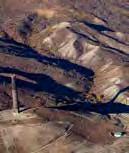
ANACONDA // 38 BIG SKY // 44
Like people, communities are characters. They are defined by identity, history, adversity and place. And like people, we acquaint ourselves with communities through reputation, a brief meeting or meaningful time spent together. In this gallery, Bozeman-based pilot and photographer Christopher Boyer introduces us to three distinctly unique Montana communities through an aerial view captured from his 1956 red Cessna plane. Upon first glance, we gain information about these places; we put them in context: What natural features surround them? What relics of history are they built around? How do the built communities interact with the landscape they exist within?


Through photojournalist Hazel Cramer’s work, we’re then afforded a more intimate experience in these communities. Who are their members? What are their challenges? What does their resilience look like? What are their identities?
This issue, we invite you to explore these portraits of Lame Deer, Anaconda and Big Sky and acquaint yourself with a visual take on community.
 –The Editors
–The Editors
31

32
LAME DEER
The Northern Cheyenne Reservation, one of the seven in the state of Montana, was established in 1884. Nestled in its hills on the edge of Montana’s eastern plains sits Lame Deer. Evidence of systemic racism and cultural genocide is planted throughout the community, which continues to deal with daily hardship as a result. And yet, this place is a generational home that breeds community, connection and a love for the land.

33
Photo by Christopher Boyer
Above: Teanna Limpy, Northern Cheyenne’s culture and resource preservation officer, sits at her desk in Lame Deer, Montana. “There’s a saying that the land we have today was fought for. The literal blood of our people,” Limpy said. “This land has provided everything for us, it’s always been a cherished part of our homeland.”

Left: This U.S. Federal Government building is on the north side of Lame Deer. “Lame Deer is our biggest district,” Limpy said. “It’s the economic hub of the reservation.”

34


35
Above: Lynette Two Bulls stands in the early spring educational garden of the Yellow Bird Lifeways Center (YBLC). The YBLC, founded in part by Two Bulls, is a nonprofit organization focused on reciprocity for its community. The educational garden is a part of their food sovereignty program.
Right: Two Bulls holds sacred Northern Cheyenne heirloom corn in the YBLC greenhouse. “I think it’s really important for our community to come together to heal, and now science is catching up with what our people always knew- that the land heals us,” Two Bulls said.
Above: Arlene Rogers (front) and her daughter, Danielle Shotgunn, lost their son and brother, Shane Shotgunn, to alcohol abuse. The wall of photos behind them is to remember him. "He was so friendly,” Rogers said. “He would strike up a conversation with anyone, even strangers.”
Above right: Trash and other debris surround a burnt vehicle alongside a residential street in Lame Deer, Montana. "The Majority of us who live here live in poverty," Rogers said on April 18, 2023.

36


37
Right: Vikki and Troy Cady own the Flower Grinder, the only coffee or flower shop in a 25-mile radius. During the pandemic, Vikki kept a record of all the events she prepared flowers for. "I ended up doing about 120 funerals that year," she said.

38
ANACONDA
A child of the Anaconda Copper Mining Company of the late 1800s, Anaconda, Montana, is both a place petrified in its history and fertile with new opportunity. The community is a patchwork of a predominantly older demographic with young entrepreneurs and families woven in. While relics like “The Stack” (top left) remain as a museum of the town’s past, new shop fronts and new faces indicate the community is undergoing an identity shift.
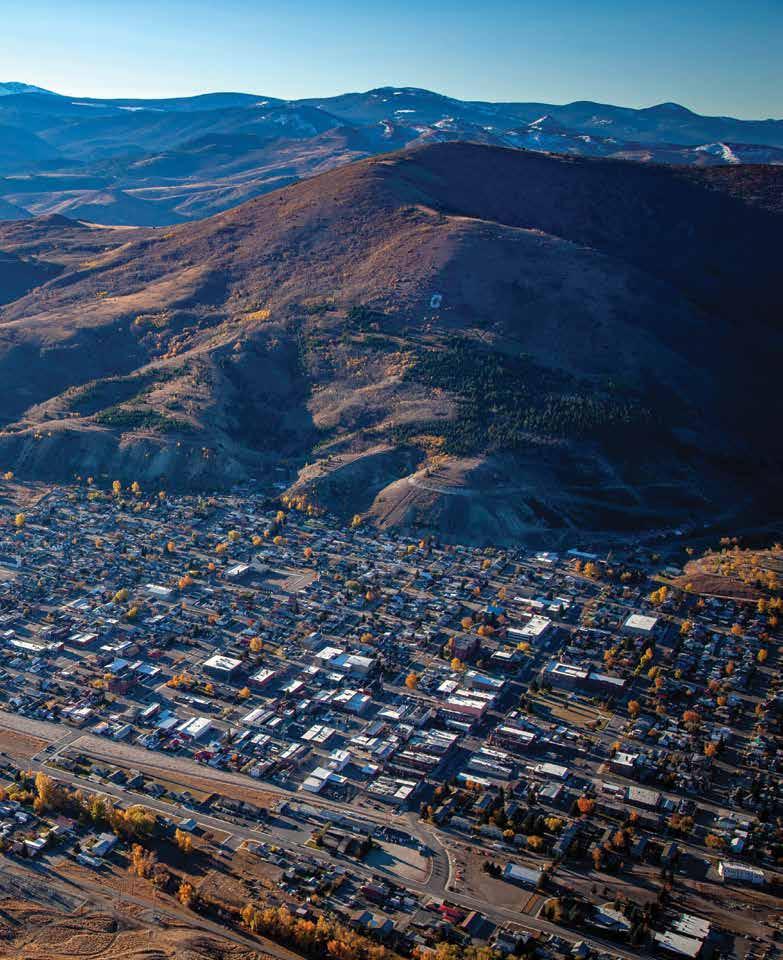
39
Photo by Christopher Boyer
Smelter City Brewing, Anaconda’s only brewery, opened in 2017. “It was one of the first new ‘Happenin’ Businesses’,” said Matt Johnson (featured on the following page). “It gave us, the newer folks, somewhere to go.”

40
Straight streets and homogeneous housing characterize the town. Anaconda was a pre-planned city, built in the early 20th century with the purpose of running the smelter, so the houses east of Main Street look like this to accommodate more workers.

41


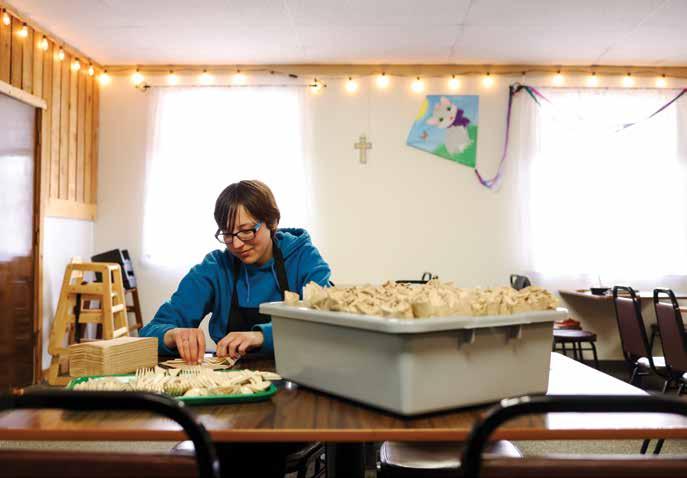

42
Far left: Born and raised in Anaconda, Nicole McDonald, 29, rolls silverware at Firefly Cafe, a place where customers and employees know each other on a first-name basis. “I would stop to chat some more, but I get paid to work, so I gotta keep working,” McDonald joked. “I have to get my money if I want to get out of this town someday.”

Left: Kim Magnusson, who has lived in Anaconda for 20 years, stands in the kitchen of her bar, Carmel’s Sports Bar & Grill. “Our community is mostly older people since the smelter closed,” Magnusson said. “The younger people move away when they get old enough because there’s nothing to offer them.”
Far left: Matt Johnson and his wife, Emily Adams (not pictured), moved to Anaconda in 2019 and opened their bike shop in April 2022. “The community is changing from when I first recognized it 10 years ago,” Johnson said. “The town seemed sleepier and quieter… just not like the outdoor recreation place that it’s turning into.”
Left: Logan Dublin is starting a new life in Anaconda. She just completed her second job interview since moving from Colorado last week. “It’s definitely small-town vibes,” she said on April 19, 2023. “At first, I was a little nervous, but everyone has been really welcoming.”

43
BIG SKY
Founded by famous newscaster Chet Huntley in 1974, Big Sky, Montana, was established with the intention of creating opportunities for people to enjoy wide open spaces and experience the mountains. Today, Big Sky is an increasingly popular tourist destination and second (or third) home location. And yet, the town is also a community, home to longtime locals, eager newcomers and seasonal workers. As the demand for a piece of this paradise climbs, so does the cost of living, and striking the balance between economic growth and livability becomes somewhat of a white whale.

44

45
Photo by Christopher Boyer
when we were growing up here, and now that’s not necessarily the case.”
Right:
a complex of high-end condominiums and penthouses, is being built in Town Center, one of Big Sky’s distinct areas. According to the development’s website, short-term rentals will be allowed in the building, and the average unit price is $2.76 million.


46
Above: Ethan Schumacher (left) and Holden Samuels are geared up for some spring turns at the Beehive Basin trailhead. “Big Sky has changed a lot,” Samuels said. “Literally everyone knew everyone
The Franklin Residences,
Ben Bonesho stands in the back room of East Slope Outdoors, a gear and rental shop where he works. “The main issue here is housing,” Bonesho said. “I know people, like our other manager, that drive an hour and a half to come work here.” According to the Big Sky Chamber of Commerce, 50% of the workforce commutes from other towns.

47
Right: David O’Connor is the executive director of the Big Sky Community Housing Trust (BSCHT), a nonprofit that identifies community housing challenges and seeks to address them. Big Sky is unincorporated, meaning there is no organized local government to fulfill such services. Instead, it is run by a network of special districts and nonprofits, like BSCHT. “We’re such a young community, there was no mining town here first,” O’Connor said. “So we have a great opportunity to decide our values and identify what it means to be from Big Sky.”

Below: Daniel Bierschwale, executive director of the Big Sky Resort Area District, addresses a crowd at the groundbreaking event for a new long-term rental workforce housing development. The construction of Riverview Place started on May 3, 2023.

48

49
Hazel Cramer is a documentary photographer and videographer based in Bozeman, Montana. She acknowledges her previous status as a guest on Northern Cheyenne land, and says a special thank you to Ȟokšilá Šahíyelá íčíčaǧá Mesteth for his help with this story.
Christopher Boyer is a commercial pilot and photographer flying survey, mapping and photography projects throughout the Northern Rockies and Great Plains.
Signs of Montana employees Micah Harvey (top left) and Wyatt French install the official sign on Cowboy Coffee’s new Big Sky location. The business, which started in Jackson, Wyoming, opened its second walk-in coffee shop in 2023 and is among many new businesses to move into Town Center.
Analytical cannabis testing that you can trust.

Montana family, and female, owned and operated. Fidelity Diagnostics specializes in advanced THC, Terpene and Contaminant compliance testing. Consistent and reliable sampling services from our exceptional Field Technician team. Laboratory integrity that you can trust.


50
GROW WITH FIDELITY | fidimt.com

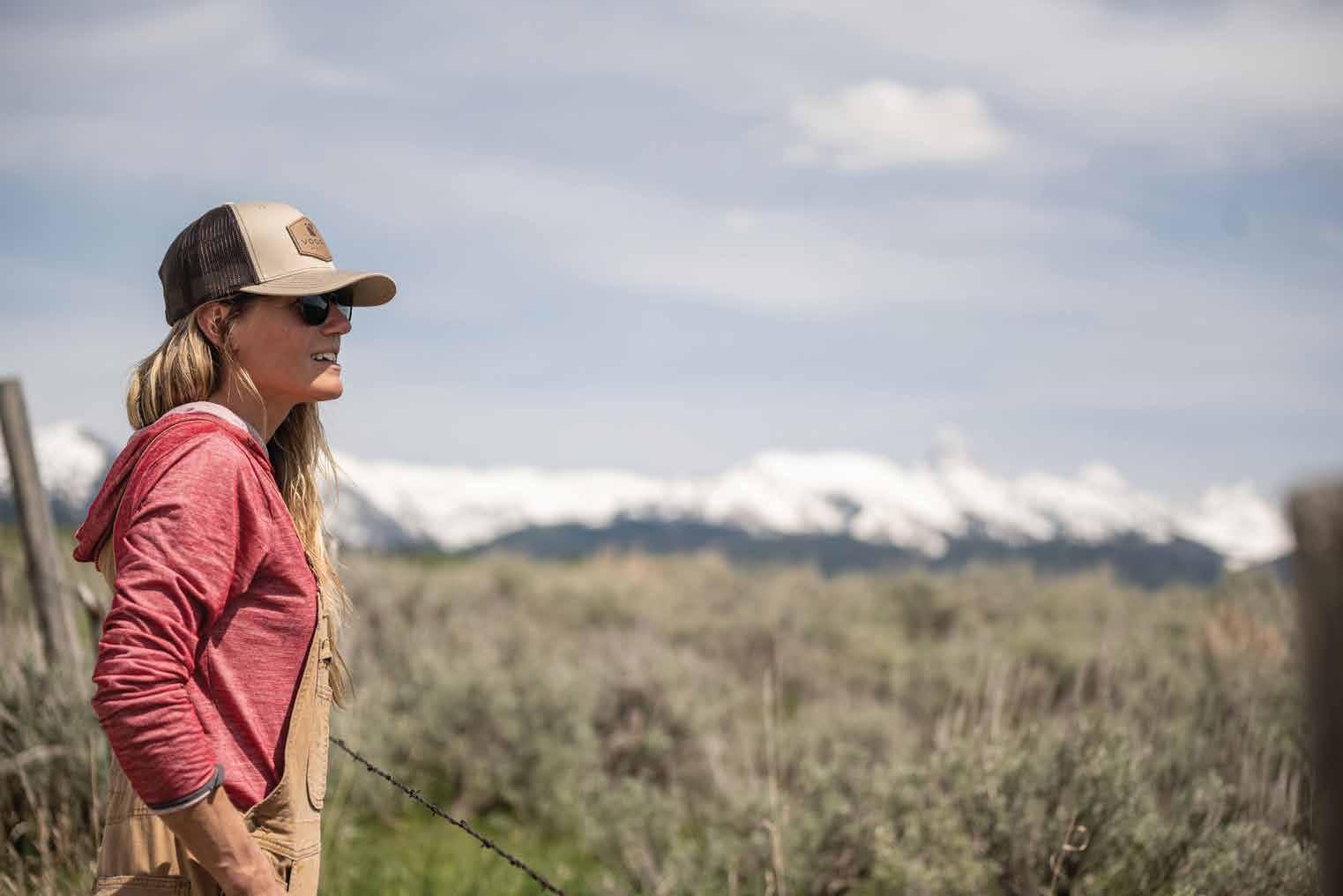










Season-spanning, all-conditions gear built to outperform and outlast. FLAGSHIP STORES Bozeman, MT Pagosa Springs, CO SHOP VOORMI.COM EMBRACE THE ELEMENT™ Sun Protection Moisture Wicking Quick Drying Water Resistant CHALET PULLOVER
RIVER RUN HOODIE
THE FUTURE OF CLOTHING
V1 RAIN JACKET
From High Desert, high altitude and the coast,
Voormi’s tech-textiles Embrace the Element
Words by
It’s a Yosemite spring like the park rarely sees. Record snowpack in the Sierra Nevada and warming temps have released a torrent of water. The runoff gushes from the valley’s rim down both its famous waterfalls and new unnamed ones, pushed down crevasses and over cliff edges by the unrelenting force of gravity. The infamous Yosemite Falls sounds like a semi trailer lumbering down an interstate, the water eager to plunge into the Merced River below.
The anomalous snow year in the West is giving way to an intensely wet season of rebirth—one my partner Kenny and I have been fortunate to witness as we pass through the lower Rocky Mountains, red rock deserts, High Sierra and lush green and redwood-specked coast. From the 111 degrees we felt in Death Valley, to snowfall in Yosemite, to the dry 85 in the Grand Canyon and dense fog of the Mendocino Coast, we’ve both shivered and sweated, sometimes in the span of two hours and 200 miles.
On a trip of extremes, you wonder what kind of gear to pack without bringing a caravan to it. Truth is, I’ve been wearing Voormi® clothing for most of it. Between driving from Alabama Hills outside of Lone Pine, California, where high-desert temps and flowers were in full swing, to reaching the High Sierra and arriving during a late-season snowstorm in Yosemite Valley, I was comfortable with my minimal repertoire of their Easy Tank paired with the Chalet Pullover and knit beanie to stave the chill the dense coastal range clouds brought in.
That’s because Voormi as a company was founded on similar principles. Not only rooted in the region that contains the highest concentration of 14ers in the Lower 48, Voormi’s founders are outdoors people, guides and


mountaineers. In fact, the idea for minimal but heavy-lifting clothing was inspired by a guide trip through Alaska.
Their River Run Hoodie base layer kept me warm when wind chills in Moab, Utah, dipped below 30 degrees, but also kept me cool when the sun rose above the red monoliths of Zion National Park to kiss the morning with warmth. Their Short Sleeve Tech Tee dried me when, in my haste to take my first shower in after five days, I had forgotten a towel. In all cases, it’s a t-shirt that goes beyond simply covering my body in moderate temperatures and has instead pulled its weight on trail runs filled with sunshine and red rock dust and even to that post-run beer by the fire.
Voormi’s home base is in a remote, rugged town nestled in the San Juan Mountains of Colorado just over Wolf Creek Pass, where mountain pursuits are a little more extreme and the people tougher. With stores in Pagosa Springs, Colorado, and Bozeman, Montana, Voormi takes pride in producing a lifestyle-backed brand of clothing that is tough, tactical and looks great doing it all.
Voormi’s team thrives on the foundation of an
52
Sponsored Content
Mira Brody | Photos by Mira Brody & Kenny Wilson
industry-unique ethos: textiles are a technology that needs to progress like any other. The truth is, not much has changed since humans put a couple hides together to produce clothing over 10,000 years ago, something they’re working to change with the creation of Voormi’s proprietary CORE CONSTRUCTION® and other patented textile technologies. Uniquely, Voormi's CORE CONSTRUCTION® allows the ability to insert advanced functional materials into the center of fabric - from integrated weather protection to printed electronic circuitry. This patented process changes the game when it comes to breakthrough performance in textiles, and when worn, remains comfortable and excels in extreme conditions.
Take the High-E Hoodie for example—it includes Voormi’s Surface-Hardened™ technology and is made with a durable 21.5 micron wool reinforced by an array of outer-facing nylon fibers. Finished off with a durable water repellent coating, it becomes a multi-use backcountry staple built to work on its own, or layered with your favorite shell. Another great textile advancement in Voormi's fleet is its PHASE S.C.™ concealment technology. Phase S.C. is achieved by coloring the textile down to the yarn level instead of using surface-printed camo. This eliminates the “synthetic glow” common to hunting in sunrise and sunset conditions with traditional synthetic camo. With virtually unlimited uses, Voormi garments are cross functional in every sport, lifestyle and recreation type. These textiles work hard, are moisturewicking when you start to sweat, insulating when the temps drop, and water repelling when it starts to precipitate — meaning there’s no need to change layers when the weather does. Voormi’s clothing is the first and last pieces you’ll buy for every single type of element.
Kenny and I end our trip on California’s Pacific Coast before heading home to Montana and are greeted once again by an abnormal but healthy wet spring. The fog is dense and the ocean waves along the beautiful Sonoma Coast crash into the sand, sending sea spray into the already-humid air. Although it’s chilly, my Chalet Pullover is impenetrable, making this and each adventure before it feel less biting, and instead more refreshing than anything.

53


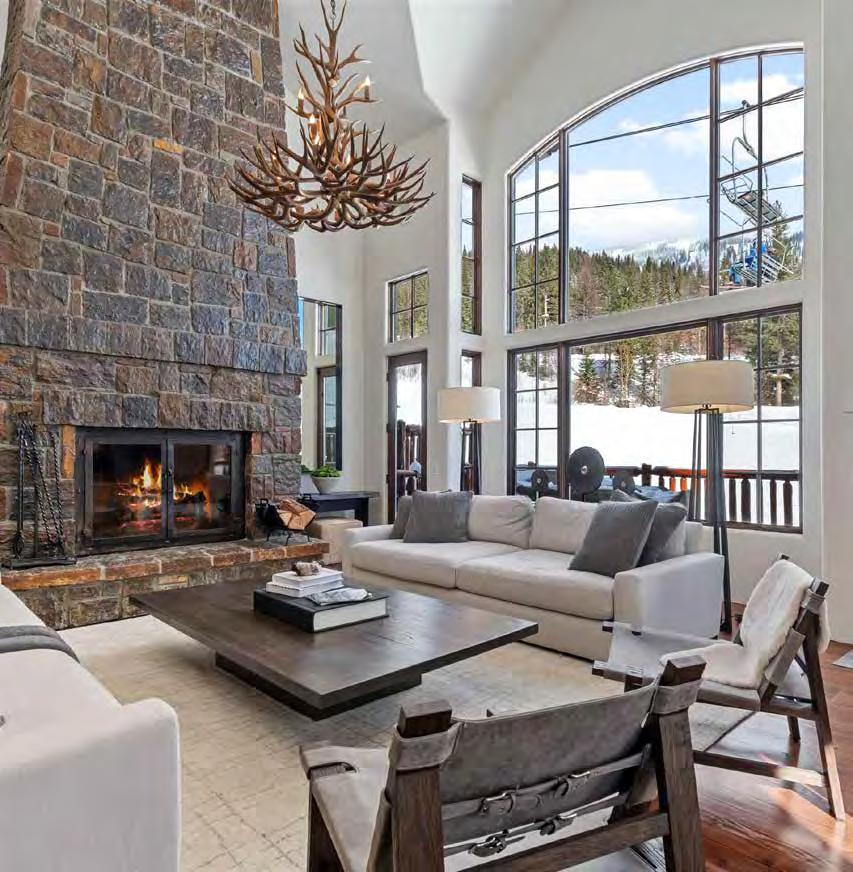


55 Tell your Montana story with PureWest. PUREWESTREALESTATE.COM Behind every move is a story. We’ll help you with the next chapter. Behind every move is a story. We’ll help you write yours. 88 Ousel Falls Road, Suite B | Big Sky, MT 59716 406.995.4009 | www.BigSkyPureWest.com






56 eralandmark.com Robyn
Each office independently owned and operated.
Erlenbush, CRB, Broker/Owner.
3 BEDS | 2.5 BATHS | 22.5 ACRES | BOZEMAN | $1,950,000 MLS# 380760 | Chelsea Stewart 406-579-0740
3 BEDS | 3.5 BATHS | 2,482 SQ FT | BOZEMAN | $1,495,000 MLS# 380757 | Hannah Comaratta 406-589-2732
3 BEDS | 2.5 BATHS | 1,653 SQ FT | LIVINGSTON | $479,000 MLS# 380763 | Gillian Swanson 406-220-4340 & Sarah Swanson 406-220-2045
Bozeman, Big Sky, Livingston & Ennis, Montana
Specializing in making Montana dreams come true since 1976. Ready to follow your dream?
5 BEDS | 5 BATHS | 3,878 SQ FT | BIG SKY | $2,990,000 MLS# 380923 | Dan Delzer 406-580-4326
ESCAPE TO

PARADISE
We’re not sure a more perfect combination exists – adventures by day across Paradise Valley, followed by the comforts of Sage Lodge by night. With Sage Lodge as your basecamp, you can enjoy fly fishing on the Yellowstone River, private spring creeks, or in nearby Yellowstone National Park. And while Paradise Valley is known for its abundant, blue-ribbon waters, there’s also more to enjoy at Sage Lodge. Grab a hearty Montana-inspired meal in the Fireside Room or The Grill, pamper yourself at The Spa, and kick back with a cocktail on the patio while taking in breathtaking views of Emigrant Peak.
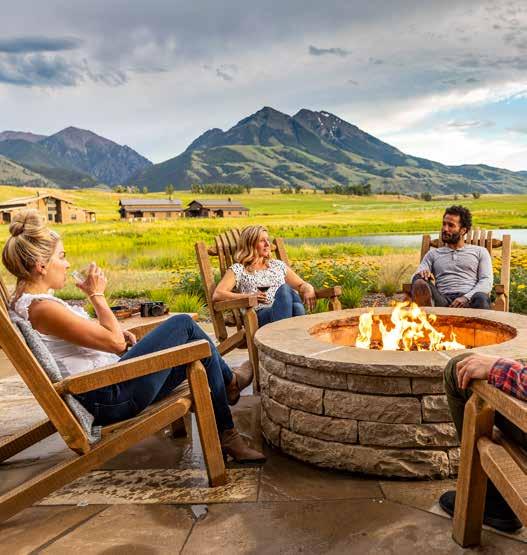
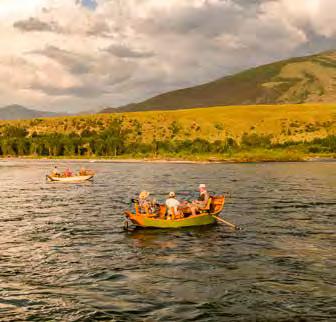
VISIT SAGELODGE.COM OR CALL 855.400.0505.




Sage Lodge Drive, Pray, MT 59065
55

58
 Jeremy Lurgio and his family trekked to the historic Medicine Point Lookout in the Bitterroot Mountains two years in a row during the lookout’s opening summer week. The photo essay on page 60 juxtaposes the family’s two adventures through drastically different landscapes due to the fickle nature of Montana mountain weather.
Jeremy Lurgio and his family trekked to the historic Medicine Point Lookout in the Bitterroot Mountains two years in a row during the lookout’s opening summer week. The photo essay on page 60 juxtaposes the family’s two adventures through drastically different landscapes due to the fickle nature of Montana mountain weather.
ADVENTURE A TALE OF TWO TREKS // 60 DOWN IS OPTIONAL UP IS MANDATORY // 66 100 DAYS FROM YELLOWSTONE TO THE YUKON // 68 59
Photo by Jeremy Lurgio.
A Tale of Two Treks
A lesson in Montana adventures, from one summer to the next
 Words
Words
and Photos by Jeremy Lurgio
She wanted to wear her snow boots.
She insisted. She didn’t care it was the last day of June. She didn’t care the climb to the fire lookout was 2,000 vertical feet over 3.5 miles. She was steadfast about the snow boots.
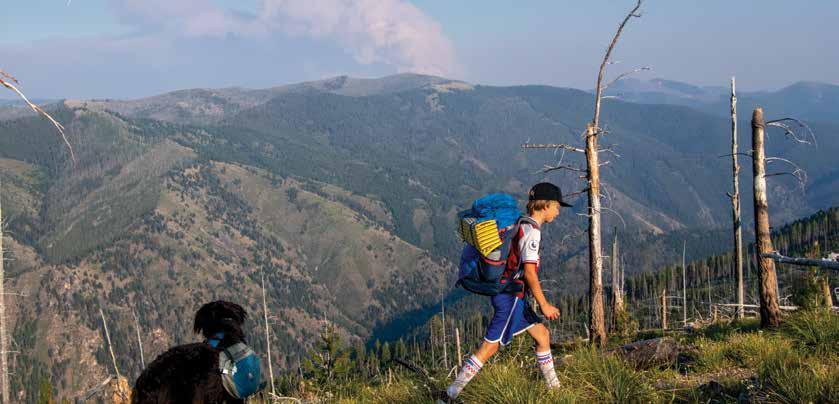

If you know anything about 7-year-olds, they can be particular and stubborn about attire. Our Amelia was no different. Gold cape with colorful ski socks on Monday, sure. Michael Jackson-style red leather jacket with striped socks and polka dot shorts on Tuesday, okay. Shorts for every sub-freezing day of the year, fine. As parents we try our best to teach our kids to be prepared, but we also kind of pride ourselves on our kids being Montana tough.
Yet against Amelia’s best judgment, as we prepared for our journey to the Medicine Point Lookout in the southern Bitterroot Mountains, my wife and I convinced our free-spirited daughter that comfortable sneakers were indeed the proper shoes for the hike.
The night before we left, a summer cold front blew through western Montana, bringing freezing temperatures and possible snow to the high country. With our backpacks geared up for an overnight adventure, we drove from Missoula to the trailhead near Sula, Montana. Based on the dusted snow line adorning the high peaks of the Bitterroots from Lolo Peak all the way to the range’s highest point at Trapper Peak, the weathermen had nailed it.
Three months into the pandemic, we were excited to have the first available night booked at the lookout, which is available from June 30 through early September. We pulled off Highway 93 and started up the dirt Forest Service road. As we drove higher, we could see the silhouette of the lookout perched on the 8,409-foot Medicine Point, which was blanketed in white. We knew there’d be some snow up top.
Packs on and dogs in tow, we started up the first third of the hike through a forest of Douglas fir and purple lupine. Our daughter and our 10-year-old son, Lachlan, had never stayed in a lookout, so excitement fueled the first leg. The sun was out and things were good.
Left: After hiking 3.5 miles through dirt, mud and snow, Amelia Lurgio slogs through 10 inches of snow on her way up the final ridge to the Medicine Point Lookout on June 30, 2020, the first day the lookout is available for overnight stays. Above: A year later, Lachlan and his dog, Awa, gaze toward a wildfire in the Sapphire Mountains while hiking Medicine Point. Topo maps courtesy of U.S. Geological Survey.
Right: During their first ever trip to a fire lookout, Amelia, left, and Lachlan, right, still shine smiles despite the adventurous 2,000 vertical feet climb to the lookout.


Below: A year later, Lachlan, left, and Amelia, right, don similar smiles during their second trip to the lookout. They carried a bit more weight in their backpacks and the weather was drastically different the second time around.
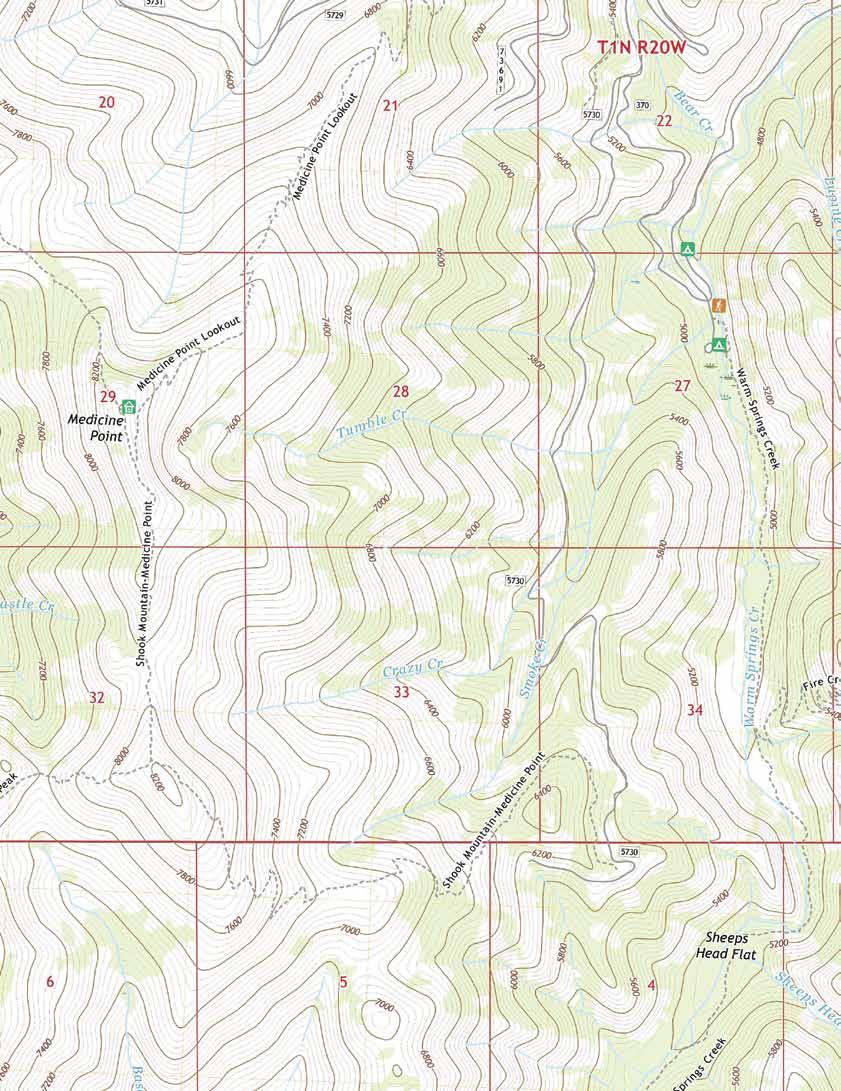


 Top: Amelia trudges through deep snow in a final push to the 14-foot by 14-foot Medicine Point Lookout, which is perched on a 10-foot-tall tower at the top of Medicine Point at 8,409 feet. Bottom: Lachlan Lurgio looks out toward a smoky sunset as he hikes to the historic lookout, which has been restored to reflect a lookout of the 1940s.
Top: Amelia trudges through deep snow in a final push to the 14-foot by 14-foot Medicine Point Lookout, which is perched on a 10-foot-tall tower at the top of Medicine Point at 8,409 feet. Bottom: Lachlan Lurgio looks out toward a smoky sunset as he hikes to the historic lookout, which has been restored to reflect a lookout of the 1940s.


 Top: After a wet, cold climb to Medicine Point, Lachlan, left, and his sister, Amelia, curl up in a sleeping bag together, happy for the shelter and warmth at the lookout. Bottom: A year later, Lachlan, left, and Amelia, play a game of Pass the Pigs after a sunny summer hike to the lookout. The lookout provides a vast 360-degree view of the surrounding mountains and wilderness.
Top: After a wet, cold climb to Medicine Point, Lachlan, left, and his sister, Amelia, curl up in a sleeping bag together, happy for the shelter and warmth at the lookout. Bottom: A year later, Lachlan, left, and Amelia, play a game of Pass the Pigs after a sunny summer hike to the lookout. The lookout provides a vast 360-degree view of the surrounding mountains and wilderness.
The second leg of the journey got slick and a bit muddy from the melting snow. By the time we reached the saddle below the last third of the climb, we could see the snow we had thought might be a dusting was indeed something heavier. Clouds shrouded the peak.
As we started up the last 500 vertical feet, 1 inch of wet snow became 3, and then pretty quickly, 6. Feet were wet. Feet were cold.
Amelia erupted with tears. “I told you I wanted to wear my snow boots,” she wailed. “My feet are so cold.”
“Yup, you were right, we were wrong,” I replied. “Let’s take a break and figure out a plan.”
I moved onward taking really small, 7-year-old stride length steps to pack down the snow so it didn’t get above her shoe cuffs. I joked that I’d rub her cold digits and I’d blow hot air on her stinky feet to keep them warm. And I did. Then we played the animal game where one person picks an animal and the others have to ask yes and no questions to solve the riddle.
Bolstered by gummies, energy bars, reassurance and the excitement for the warmth of the lookout, we managed to keep moving. In some places, the snow was 10 inches deep. My wife and I have spent a lot of time backpacking, backcountry skiing and mountain biking and have endured countless events of that oddly treasured Type Two Fun, but there was something special about sharing this misery with our family of four. As we built a fire in the stove, the kids nestled in a sleeping bag together. They gazed through the lookout’s windows with a 360-degree view for miles. In minutes, the siblings were laughing and giggling, the recent postholing forgotten.
We looked at maps, read about the history of the lookout and perused journal entries from past guests. The kids were in awe of this 14-foot by 14-foot shelter perched atop Medicine Point. There’s something primal, something instinctual, that happens when setting up camp in a remote place; I feel deeply grounded as the exhilaration of wild places blends with the calmness of sanctuary.

By nightfall we all joked that we had to do this again next year, and we did. But true to the fickle nature of weather in Montana, a year later we hiked to the lookout on a 70-degree day; the distant ridges weren’t blanked in white snow, but instead shrouded in early wildfire smoke. Despite this classic Northern Rockies juxtaposition, the wildness remained, as did the beautiful rustic sanctuary.
This photo essay is a comparison of two trips, nearly a year apart, to the remarkable Medicine Point Lookout.
Jeremy Lurgio is a freelance photographer and filmmaker based in Missoula, Montana. He is also a professor of photojournalism and multimedia storytelling at the University of Montana School of Journalism. In his downtime he enjoys skiing, mountain biking, cyclocross racing, fly fishing and exploring the wilds of Montana with his family and dogs.
Top: The fire in the lookout’s woodstove provides heat to dry wet socks, boots and sneakers, but it also provides some muchneeded warmth for Lucky, one of the family’s two dogs.

Middle: Caroline, Lachlan, Amelia and Jeremy pose for a selfie halfway between the trailhead and the Medicine Point Lookout.
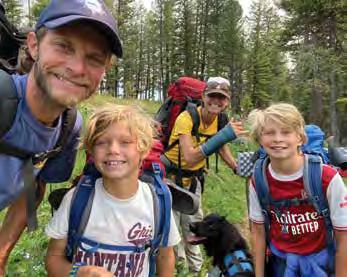
Bottom: Jeremy, Amelia, Caroline and Lachlan pose for another selfie a year later. This time not in winter gear, but in t-shirts and shorts.

Words and Photos by Mira Brody
The color of the trail beneath our fast-moving feet changes according to where we are on this mile-deep map of geologic time that dates as far back as 1.84 billion years. A cross-section of this kind of history can only exist here, in the Grand Canyon. With each step, we gain distance but lose time—the push and pull of submitting yourself to a vast landscape. Currently, we’re somewhere in Redwall Limestone, a 500-foot band formed during the Mississippian age more than 300 million years ago. Blood-red dusty proof stains my shoes. A canyon hiker steps aside as our crew of three women run by, the first rays of the morning sun warming our skin on an otherwise chilly November morning.
as it is succinctly referred to, is a not-so-succinct undertaking. From our chosen route—starting at South Kaibab trailhead, summiting at North Kaibab trailhead and concluding at Bright Angel trailhead— we cover 48 miles and over 11,000 feet in elevation gain.

The experience is as much individual as it is communal. R3 is a globally revered bucket list accomplishment for thru hikers and runners and while we’ll spend many miles of the day alone, there’s a small migratory community inside the labyrinth of the canyon all striving for the same goal in the same giant hole in the ground. We see each other only for brief moments in time, exchange a nod, greeting or intel about the last few hours of our lives. And then, never again.
“Are you doing all three rims?” the hiker asks us, the first of many times we’d be asked that question on our long journey. “Today?” he asks. Time is relative down here. Distance however, is not.
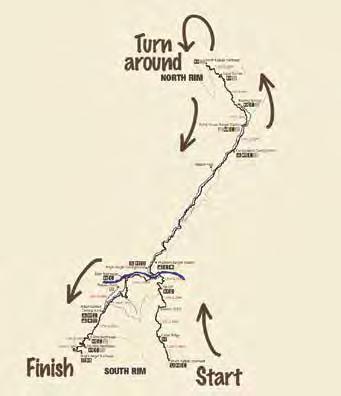
We tell him yes between short breaths and the hiker exudes a sound somewhere between admiration and disgust. I feel the same.
Grand Canyon National Park sees more than 6 million annual visitors. Ninety-nine percent of them view it from the visitor center, taking in the great chasm from above; and some hike portions of it from nearby trailheads. A lucky few snag coveted backcountry campgrounds along the canyon’s base and backpack at a leisurely pace.
Fewer still choose to run its entire breadth twice in a single day—my friends and I among these indulgers of Type 2 fun.
We cross paths with a woman in her 50s just shy of the North Rim who has run the Grand Canyon every single year for 15 years. This year she invited a friend, a first-timer, to the sufferfest and asked us to pass along words of encouragement to her a few switchbacks down. Then, while refilling water at the Manzanita water spigot, we meet a man from Oregon and gleefully compare bagged goo flavors, a delicacy on the trail.
The day wanes and we exit the snow patches on the canyon’s chillier north side, accidentally startling an older gentleman as he slowly and steadily works his way back to Phantom Ranch where he’ll stay the night. We had seen him hours previous when he was climbing the North Rim, boasting that he had just turned 70.
With three rims to summit and descend, Rim to Rim to Rim, or R3
Deep in the lower gorge, the ground is a light yellow-
66
Traversing the Grand Canyon is no small feat—the trail system summits and descends the canyon’s rim three times, covering 48 miles and over 11,000 feet of elevation gain. The canyon is also home to layers of rock from bygone eras showing a near perfect cross-section of North America’s geologic history.
brown as our feet pound the Vishnu Schist layer, more than 600 million years old. Bright Angel Creek, which we’ve followed for most of the afternoon, fills the otherwise quiet trail before flowing back into the Colorado River. Lights from a passing campground flicker on as darkness descends. Campers are preparing dinner and I almost wish I could stay down here with them, in this alternate layer of time. Instead, we’re pulling clothes out of our packs as the otherwise warm fall day fades in time for our third rim, and final climb.
There is no sunset 6,000 feet underground. One minute there’s a faint light glowing from the edge of the rim above us, and the next we’re crossing the Colorado River in complete darkness.

Our company dwindles down to a few headlamps twinkling in the void that swallows us. Without any indication of distance, these bobbing lights appear to be either 10 or 1,000 feet away, indistinguishable from the galaxy that has appeared above our heads. Unless we pause to look up, our world is limited to the 2-foot halo cast by our own headlamps for the entire 9-mile ascent from the river. Even the colors of the rock layers are invisible, our sense of deep time erased.
Suddenly, a change in pressure and a 25-degree drop in temperature hits us with a chilly headwind. We are out of the inner gorge, referred to as “the box,” and walking along the Tonto Platform, a 500-million-year-old layer of impermeable shale that divides the upper canyon from the lower.

We pass another trickling creek and greet two young
women we had seen earlier that morning. They are dressed in vibrant Native ribbon skirts that glisten and sway by the light of our headlamps. We plunge back into the darkness for what will be the longest 2-mile so-called run of my life, following a series of meticulous switchbacks that hug the side of the upper canyon wall.
The Kaibab Limestone layer was formed 270 million years ago, which is approximately how old we feel as we crest the final rim of the stuff and hobble through the parking lot. Forty-eight miles on the body and soul is an intimate feeling, a mixture of pride and pain. Part of you wants to curl up and never walk again; but there’s another, smaller part of you that wonders how much more you might be capable of.
It’s 10 p.m., exactly 15 hours and 17 minutes from our start. The parking lot is as sparsely filled as when we left it, the sky just as dark. The three of us girls get into our car and eagerly pass around a Ziploc bag of cold pizza as we unceremoniously ponder what we’ve done.
We share a collective sigh: a mixture of relief, exhaustion and accomplishment and somehow embodies that entire span of time—a span that included millions of years of geology, a community of people and an entire landscape.

67
Mira Brody is an avid runner and writer in Bozeman, Montana. She is the producer of Mountain Outlaw and content production director at Outlaw Partners.
Taking on our final stretch up Bright Angel Trail just after 6 p.m., the concluding 9 miles of our day is not only stacked on top of 40 miles behind us, but also made in complete darkness.
Days from Yellowstone to the Yukon

ever-changing,
By Heather Waterous and Amaya Cherian-Hall
✖ ✖
Two women (and one dog) embark on an
human-powered journey across one of North America’s most iconic wildlife corridors
Amaya Cherian-Hall (left) and Heather Waterous (right) take a shady break to refuel and smell the wildflowers on June 17, 2022. The two women completed a nearly 3,000-kilometer journey from Yellowstone National Park to the Yukon over 100 days. Photo by Hazel Cramer.
Editor’s Note: This is the story of two women who set out to complete a 5,000-kilometer human-powered traverse of the Yellowstone to Yukon wildlife corridor. After experiencing such a massive feat together, it was only right to have them tell their story in the same sort of parallel they journeyed in for five months. Their transitions are signaled by their names.
It takes a special kind of friend to say yes to a five-month backcountry trip after a 10-minute phone call. But Heather is that kind of friend.
By the end of that 10-minute call in March of 2020, we had committed to a 5,000-kilometer human-powered expedition that would traverse the Yellowstone to Yukon (Y2Y) wildlife corridor. The plan: start in Yellowstone in May and finish in Dawson City, Yukon, by early October. We would begin by hiking the Continental Divide Trail to the Canadian border, then connect to the Great Divide Trail. After four months of hiking, we would switch to bikes and cycle the Alaska Highway to Northern Canada. Our trip would finish with a 700-kilometer canoe. That was the plan. Here’s what happened.

AMAYA: Heather and I are both drawn to expeditionstyle trips because we understand the relationship that is built when you take time to travel over land. There is an intimacy and understanding that is missed from inside a car or plane.
Following in the footsteps of bears and wolverines who rely on the Y2Y wildlife corridor, we would be building a connection to the land that links both of our homes: Heather’s in the mountains of British Columbia and mine in the Yukon.
HEATHER: That out-of-the-blue call changed many things for Amaya and me over the next two years. During that long period of preparation, we each reflected on why this trip was such a special undertaking for us. We’ve both worked in outdoor education and have had many of our own adventures. Through these experiences, we’ve learned the importance of having female role models and communities of women in the outdoors.
An adventurous woman doesn’t simply burst into being. She grows through nurturing, mistakes, hilarity, heartbreak, moments of wonder, physical pain, determination and love. Adventurous women come into being through access, support and community, not in isolation. In pursuing our dream expedition, we were following in the footsteps of many other strong, adventurous women.
Our final weeks of preparation sped by in April of 2022, food and gear purchases made possible in part due to a Women's Expedition Grant from the Royal Canadian Geographical Society. And then, quite suddenly, we were on our way. Just the two of us and Jasper the trail dog at Raynolds Pass, Montana,
69
Waterous (left) and Cherian-Hall (right) plan the next day’s route after a well-deserved dinner. Both women had just finished biking up MacDonald Pass near Helena, Montana, in 90-degree heat on June 16, 2022. Photo by Hazel Cramer.
facing the immense prospect of the next 5,000 kilometers.
AMAYA: At the start of our trek we took stock of our belongings: Regretfully heavy backpacks— check. Hiking poles—check. Jasper the trail dog—check. With butterflies in our stomachs and snowshoes on our feet, it took us about 300 meters of walking to realize we had left one of our bear sprays on the roof of the car. Oops.
Energized by the excitement of finally being en-route, we trudged through forest and cow pastures and settled into a snow-covered camp for our first night. We went to bed content but apprehensive of the distance ahead.
HEATHER: The early days of the trip were a reality check featuring extensive side-hilling, massive snowy wolf prints, hangry tears, teamwork piggy-backs across creeks, and ultimately a difficult decision point in a winter-wonderland meadow.
We made our distance goal easily on day one, but days two and three (which were longer pushes) were another story. While we were using snowshoes, we hadn’t counted on the sheer quantity of snow. That, paired with warm temperatures, meant we were often slogging through knee-deep mush.
That afternoon found us contemplating the reality of meeting our timeline in these conditions. Wanting the expedition to be a success, we channeled our inner flexibility and changed our plans on the fly.
Our decision to reroute was immediately affirmed when Amaya woke up the next morning to swollen and painful Achilles tendons. We headed for the nearest road, stuck out our thumbs and hitched a ride.
AMAYA: And so it was that Heather and I found ourselves in Lima, Montana, three days early.
Lima is a small, quintessential roadstop town. Over the trip, Heather and I passed through Lima three different times and became sentimental toward the place. We booked a motel room and began replanning the first two months of our trip. Re-hashing an expedition of this magnitude— which required
booking popular campsites half a year in advance—was no small feat, logistically or emotionally. Thankfully, my flexible nature and Heather’s attention to detail allowed us to come up with a great new plan.
After a brief flirtation with potentially road-walking, we decided to bike. Our new plan involved biking back to Yellowstone, exploring the park, then roughly following the Continental Divide Mountain Bike Route to the U.S.-Canadian border where we hoped to rejoin our hiking itinerary. Heather’s parents very generously drove down and traded us our bikes and panniers for Jasper, and we were off again.
HEATHER: Our revised route and mode of travel proved successful. Though injuries would continue to accompany us both (Amaya’s Achilles remained stubborn, and I developed a persistently grumpy knee), we cycled onward. Throughout the rest of our trip, we were able to continue supporting each other in difficult physical and emotional moments, and ultimately made our trip work for both of us—because this trip was for both of us. The whole experience is now made up of a tapestry of memories, ones we will always look back upon fondly. And it truly began with us backtracking into Yellowstone National Park.
Our first night in Yellowstone found us quietly sitting by the edge of the Madison River, engrossed in capturing the magic of the evening glow in watercolors. We were surprised by some bison splashing through the river in front of us; a sight that had us both grinning as we gathered up our paints and notebooks.
Bison are ubiquitous in Yellowstone, though this hasn’t always been the case. Exploring Yellowstone by bike was surprisingly intimidating when it came to navigating both tourist traffic and herds of these thousand-pound animals. Throughout the park, the picture beyond our handlebars was painted with the jewel tones of geysers, while our hearts were full of the Tracy Chapman songs I belted out nonstop on a number of long descents while Amaya drafted me and giggled at my ecstatic singing.
AMAYA: At home, I often feel tired in the middle of the day for no reason. When tired on a trip, though, I know I have earned it. One day, outside Yellowstone, we were biking in freezing sideways sleet and there

Waterous enjoys rest in a field of flowers in the national forest near Helena, Montana. During this heat wave, the adventurers had to stop their bike ride at noon this day when temperatures climbed to 95 degrees F. They found reprieve in a creek and meadow.

70
Cherian-Hall cheeses through the snow on the pair’s first day on bikes a few hours after leaving Lima, Montana. Photo by Heather Waterous.
Photo by Amaya Cherian-Hall.
was nothing we could do but ride faster. The power of the storm thrummed in our numb legs. Unable to decide between laughing, crying or screaming as water streamed up our sleeves and down our collars, we scream-laughed our way down the highway. I’m not sure I’ve ever been so cold, and it’s rare that I’ve felt so strong.
HEATHER: Not all days were a battle against the elements. We spent a glorious week exploring the Pioneer Mountains Scenic Byway. Book-ended by idyllic hot springs on one end and a 15-kilometer downhill on-bike dance party on the other, the byway stands out as both a relaxing respite and raucously hilarious time.
AMAYA: Northern Montana in June graced us with cold, clear lakes, freshly blooming flowers on the bones of old forest fires and friendly fellow bikers heading in all directions. Many towns in that area and their residents have embraced cycling culture. Ovando, Montana, offered us a plethora of free accommodation options including a tent, the basement of
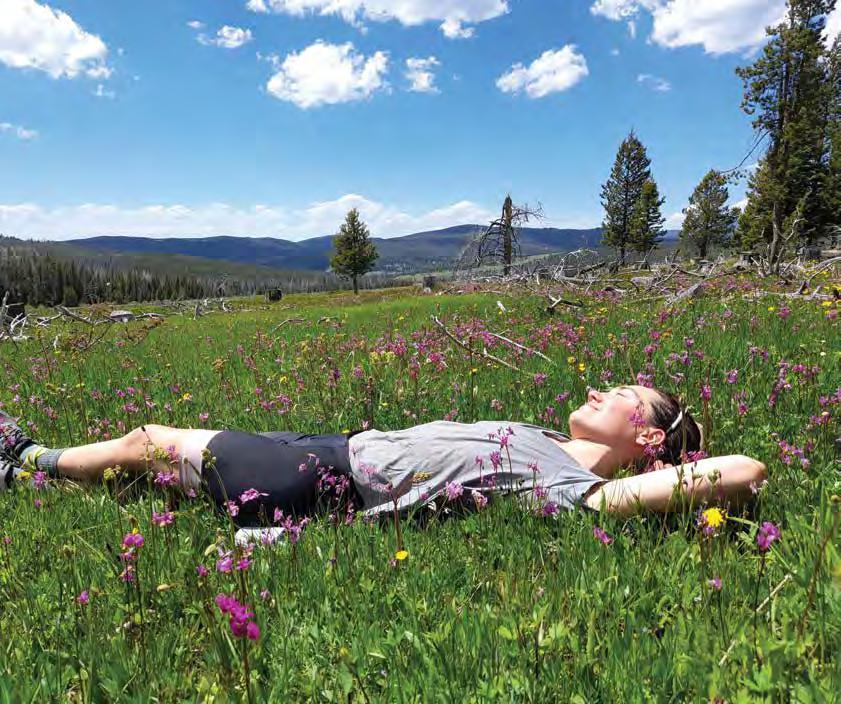
a church and an old jail. Elsewhere, homeowners shared their guest rooms and dinner tables. The owners of a little Alpaca farm treated us to lunch and we let ourselves be convinced to spend the night. We were often invited to camp, even when campgrounds were full. One campground host shared his fire and showed us the beautiful fairy houses he was carving. Surprising us, this unassuming man also told us of the murder mystery novel he was writing and of his former life as a detective and forensic artist.
HEATHER: While there was comfort in the communities we found along the way, we also enjoyed peaceful quiet. We each did a solo hike to Morrell Falls in the Swan Mountain Range of Montana. Pre-dawn, I sang to myself as I walked, feeling an immense level of gratitude for all the beautiful places we’d been. I rounded a corner to the misty falls and walked right into the spray, basking in the feeling of a million tiny cool kisses.
We also rode separately up the Going to the Sun Road
in Glacier National Park; each reveling in our own special moments of mountain solitude. We had left at the crack of dawn and were the first and only ones at the top as the sun rose over the park’s iconic peaks.
AMAYA: Each day was its own experience; occasionally one contrasting completely with the next.
On June 15, we went to bed early, too cold to enjoy sitting outside. The following day, we biked in 90-degree heat while climbing a 600-meter pass as the sun baked into the black asphalt. Somehow, between one short shady stop and Kendrick Lamar’s new album pumping through my headphones, we made it to the top of the pass, one sweat-inducing pedal stroke at a time. Overjoyed by the cool breeze on our way down, we blew right past our campsite.
It seemed juxtapositions were everywhere, from the “wild” of protected park lands butting up against towns, cities and ranch lands, to prairies meeting the Rocky Mountains.
HEATHER: While we passed through the ever-changing landscapes, we fell into a routine made up of the vital constants that marked each passing day.
We began each morning with a session of core work, pushups and stretching; listening to the birds and our bodies. Even now, we try to keep each other accountable to this routine from afar—though it’s not quite the same feeling in my living room as on a grassy hill under a pink dawn above the Yukon
River, having finished our crossing of Lake Laberge the previous evening.
We finished each day curled in our sleeping bags, writing in our daily journals and listening to an audiobook. Our “story time” became a way to unwind, aided by the trade of nightly massages. We helped each other soothe sore muscles as books soothed our tired minds.
The consistency in our routines and our companionship created a sense of a traveling, two-person community that was briefly immersed in many other community bubbles along the way. Upon reaching Canada, this feeling was both amplified and challenged as we left our bikes behind and began the hiking section of our trip.

At this point Amaya took a two-week break to rest her Achilles tendons, and I began hiking the Great Divide Trail without her; a foreign feeling after her constant presence the previous two months.
I reveled in the utter solitude of my hiking days, grateful to have so many special moments for just myself and simultaneously desperately wishing I could be sharing other moments with Amaya.
One particular night, the wildest storm I’ve ever experienced thrashed around me in my tent. I cried and wished to share the sleeplessness of the night with a friend before eventually drifting off. The following morning, I woke to an eerie sunrise. The storm, refusing to move on, was whipping the tent
72
Waterous crosses a creel on a single-track alternate route along the Pioneer Scenic Byway where a bridge had been removed.
Photo by Amaya Cherian-Hall
around. I knew I would soon be racing the same storm along the castle-like ridge. Despite the absurdity of the night before, and knowing that the coming day would be challenging, I laughed at the sun-painted sky and sealed the memory of the moment away.
The next day, my knee became a serious problem and I was once again thrown into the turmoil of the unknown and the necessity to re-plan a section of our trip. This involved Amaya taking on some solo hiking time while I sought medical attention and let my body heal as best I could.
AMAYA: Heather and I met up before I began hiking. She passed off some gear and we talked about what our trip could look like going forward. At different points we had both come to terms with one of us carrying on and finishing the trip alone. We were one another’s cheerleaders, and I felt Heather rooting for me as I set off.
I always thought the world-famous parks of the Rockies were overrated. Now, having spent a few weeks linking one spectacular trail to another, running into bears, moose, marmots and more, I understand why Heather had chosen to build herself a life in this part of the world.
I wasn’t sure how my Achilles were going to hold up so I started slow, progressing from traveling 10 kilometers in a day to 30. Each day brought new mountain ridges, Jasper’s constantly wagging tail, and a feeling of euphoria. The peaceful walking also allowed plenty of time for reflection and I realized that the best way to finish this trip would be with my friend. Heather picked me up from Yoho National Park and we roadtripped through Northern British Columbia up to the Yukon.
HEATHER: Arriving in Whitehorse, surrounded by Amaya’s welcoming family, was a milestone. For so long, the Yukon had felt out of reach.

The rawness of the late summer Yukon landscape followed us into our canoes onto the Yukon River, across Lake Laberge, and onward downstream. Our pebble-beach camps, the late summer mosquitoes, a hint of fall in the air and unexpected wildlife around each bend all breathed a sense of aliveness back into me that had been missing after my three-week hiatus from the expedition. Falling asleep to the sounds of the river calmed my ever-busy mind.
We woke early on our final morning, poised to make it to Dawson City and off the river in time for the Annual Outhouse Race. This weird and wonderful race, with teams of absurdly dressed participants pulling outhouses on wheels, embodies the eclectic northern town. Dawson is a
melting pot of gold-rush history, defined by its quirky traditions and equally quirky people. The day unfolded to include a reunion with Amaya’s mum, a failed attempt at the Sour-Toe cocktail (they were closed!), and a David Bowie tribute band. It was a night of dancing past when our feet hurt; the grins never leaving our faces and the laughter pouring from our lips. As a last, surreal way to say goodbye to a wild, challenging and wonderful expedition, we made the paddle back to our camp across the river in the dark at 3 a.m., just as we had started: as a team.
Late August found us parting ways, the expedition at a close, after exactly 100 days of moving our bodies across expanses of landscape.
Eight months post-trip, we reflect on the more than 3,000 kilometers we traveled by bike, foot, and boat, and why this experience had such an impact on us. I will leave you with this:
There is something about the mountains, specifically soaring rock-and-snow peaks at dawn, that cracks open our hearts and fills them with a glowing giddiness and simultaneous feeling of timelessness and insignificance. There is something about the endless plains and the constant movement of rivers that embodies the infinite and makes it tangible. And there is something about the love and companionship of a friend who truly sees all sides of you, day-in and day-out, that holds space for the wildness, tenderness and vulnerability that lives inside of each of us. I have rarely felt all this at any other point, in any other place.
Heather Waterous lives and works in Invermere, BC. In her free time, she can be found mountain biking, skiing, playing crib, dancing in the kitchen, or cuddling her two cats (Miro & Nebs) or her partner’s pup (Otto). Actually, your best bet for finding her is cuddling with one or more of the animals.
Amaya Cherian-Hall lives in a cabin with her dog in the woods of northern Canada. She loves spending time outside, playing board games, and eating. "I have never seen Amaya not eating" - quote from a friend
Waterous and Jasper the trail dog enjoy the view across the Yukon River as the adventurers approach Lake Laberge on their first day paddling. While the lake is technically a widening of the river rather, Waterous says this 50-kilometer section feels like a lake with no sense of helpful river currents to move their boat along. Photo by Amaya Cherian-Hall

74 Thinking about living in Big Sky, Montana? Perhaps now’s the time. The Big Sky Real Estate Company is the Exclusive Brokerage for Moonlight Basin and Spanish Peaks Mountain Club. BIG SKY IS CALLING. YOU MIGHT WANT TO ANSWER THAT. BIGSKYREALESTATE.COM MOONLIGHTBASIN.COM SPANISHPEAKS.COM MONTAGERESIDENCESBIGSKY.COM 406.995.6333


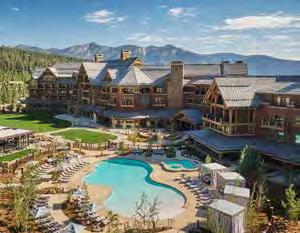
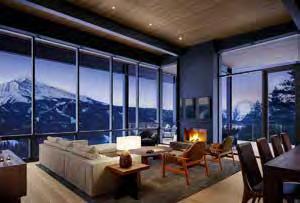

76
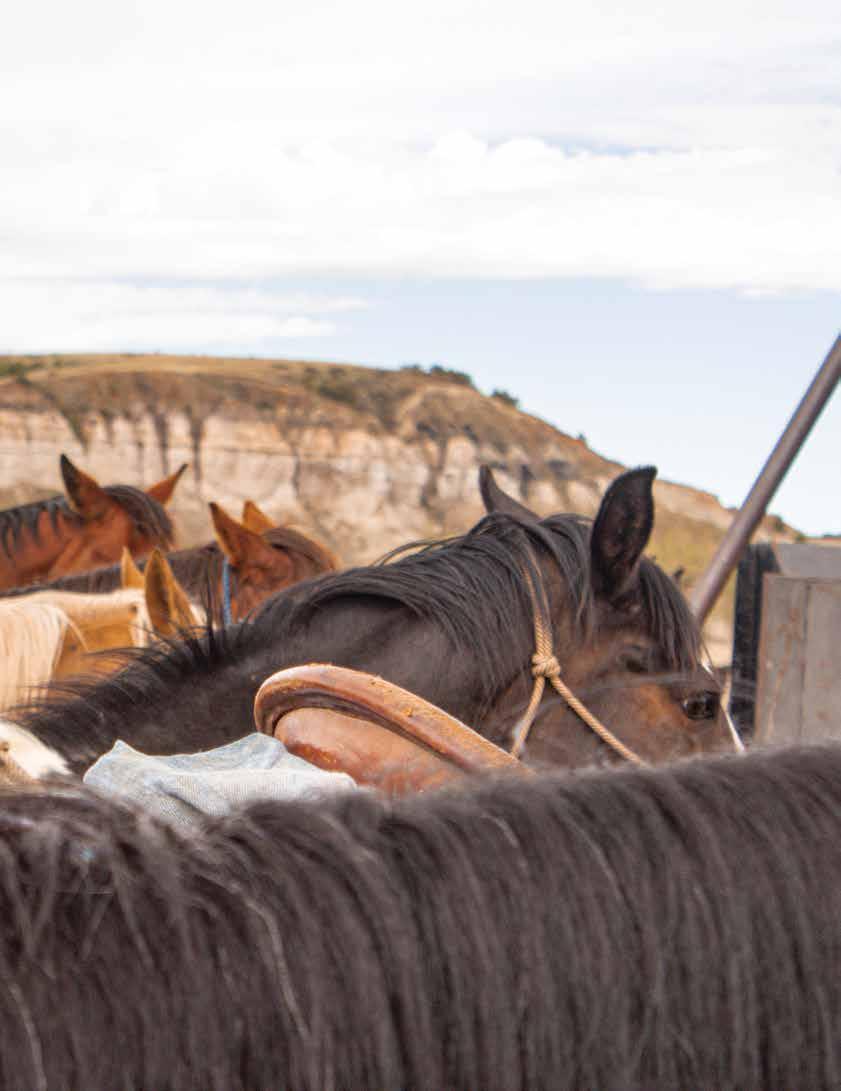 Horses stand at the ready during a spring branding event. The epitome of community, sixth-generation Montanan Maria Lovely writes about the tradition of brandings in Lending a Hand on p. 86.
Horses stand at the ready during a spring branding event. The epitome of community, sixth-generation Montanan Maria Lovely writes about the tradition of brandings in Lending a Hand on p. 86.
THE BIG TWO-HEARTED RETREAT // 78 LENDING A HAND // 86 THE DNA OF WHO WE ARE // 90 77
Photo by Maria Lovely.
ROOTS
THE BIG TWO-HEARTED RETREAT
A modern-day exploration of Ernest Hemingway's relationship to wild Montana and Wyoming

 By Toby Thompson
By Toby Thompson
The scholars are dancing. It’s the last night of the 2022 Hemingway Society Conference and aficionados of the American novelist from as far distant as Japan boogie feverishly. They hustle, jitterbug, sashay and two-step beneath a ceiling of hand-hewn logs and sturdy beams canopying the Range Rider Lodge in Silver Gate, Montana. The conference goers have sampled a bevy of Hemingway cocktails distributed gratis: Papa Dobles, Old Fashioneds, Jack Roses and Pauline’s Preferences. Within this cathedral to masculinity hangs an exhibit of photographs of Ernest Hemingway fishing, hunting and posturing manfully. To the scholars’ left, a display of Hemingway-era rifles and pistols, a grizzly hide and tie-flying gear further connect to lore of the writer’s virility and this rustic Montana setting. Dancers gyrate to a band that roars as loudly as might the mountain beasts that surround them—the bears and wolves of Yellowstone National Park and the Absaroka-Beartooth Wilderness.
Amid celebrants at the conference is Chris Warren, author of the 2019 book “Hemingway in the Yellowstone High Country,” a work which changed much in Hemingway scholarship. Warren is the director of this leg of the 2022 Sheridan/ Cooke City/Silver Gate conference and is a compact man of 50, with a dark crewcut and stubble beard, wearing loose khakis and black sneakers.
“It was a handful,” Warren says of organizing the fete. “First it was the pandemic, which canceled the 2020 and 2021 conferences, then the floods,” which closed access via the Beartooth Highway and the northeast entrance to YNP, thereby isolating Cooke City/Silver Gate from the world. As conference director Larry Grimes has quipped, “We’re waiting for the locusts.”
Previous scholarship has downplayed Hemingway’s time near Cooke City, but as Warren has written, “Hemingway stayed at the L-Bar-T ranch, 13 miles from Cooke, in 1930, ’32, ’36, ’38 and ’39,” for long summers and falls. “He wrote significant parts of [the novels] Death in the Afternoon, To Have and Have Not, For Whom the Bell Tolls, and [the stories] “Light of the World, A Natural History of the Dead, and the preface to The First 49 Stories here.” The region also appears in [the books] Green Hills of Africa, True at First Light, For Whom the Bell Tolls, Across the River and into the Trees, Islands in the Stream, [the stories] The Gambler, the Nun and the Radio, A Man of the World, Fathers and Sons, and The Clarks Fork Valley, Wyoming

It seems to have been, in numerous ways, Hemingway’s last good country. “But the

79
Range Rider Hotel, Silver Gate, Montana. Circa 1945. Photo courtesy: WaterArchives.org
2021 Ken Burns film on Hemingway gave one sentence to Wyoming and Montana,” Warren says.
What the Pulitzer-and-Nobel-Prizewinning Hemingway loved about the Cooke City area, with its trout-heavy Clarks Fork of the Yellowstone River and rugged Beartooth Mountains, was its isolation. With 200-400 inches of snow a year, an 80-person population and limited access, the town was cut off, even in summer, from the outside world. Hemingway could write in the mornings and fish or hunt in the afternoons. He spoke of being “cockeyed happy” there. His second wife, Pauline, and their two sons camped with him in the L-Bar-T’s rustic log cabins, and friends regularly visited. But as scholars at this conference reminded, the writer’s infamous demons nagged.
There was his trophy hunting of grizzlies, mountain sheep and elk, and his larder-stuffing pursuit of trout; all a manifestation of his extravagant interest in killing wed to compulsive risk-taking and an obsession with suicide. As he later told an acquaintance, “I’ve spent a lot of time killing animals and fish so I won’t kill myself.”

On Friday morning of the conference in Silver Gate, and again that afternoon, Stephen Gilbert Brown, of the University of Nevada, Las Vegas, spoke of Hemingway’s deep psychological wounds. Even the most casual devotee of the Hemingway saga knows that at age 19, as a Red Cross ambulance driver on WWI’s Italian Front, he was hit by machine gun and mortar fire and spent half of the next year in treatment for extreme lacerations of his legs. The PTSD he suffered from that wounding manifested itself as sleeplessness, a near life-long dependence on alcohol, and possibly his suicide in 1962.

But he was the victim of psychological trauma that occurred before his service, scholars argue, ones inflicted by his mother, who twinned him with his older sister, Marcelline, and dressed him as a girl until he was almost 7. Gender confusion resulted, as did the suppression of his feminine side and the hyper-expression of his masculine one. He fist-fought, fished, philandered and killed, yet was androgynous in
bed. These contradictions are discussed in Brown’s 2019 book, Hemingway, Trauma and Masculinity: In the Garden of the Uncanny.
“The critical assumption,” Brown notes, “is that these two wounds (war and androgyny) are in reality the same wound: a wound of emasculation— suffered in infancy, sustained through childhood, boyhood and adulthood, and compounded by the wounds not only of war, but love.”
Gender and sexuality weren’t the only contexts in which Hemingway presented duality. On the first morning of the Cooke City conference, the burly but reticent Brown stood before scholars and delivered a paper titled “Hemingway in Wolf Country,” in which he posed the question: “If Hemingway were living in this wolf country today, what would be his relationship to the wolf?’
Brown’s answer was contradictory. “If Hemingway was living in this country today, it is easy to imagine him systemically tracking down and killing wolves,” Brown said. “And yet, as seemingly warranted as this judgment is, it is a simplistic and reductive one, for it tells only half the story of his relationship to nature and its big game. For side by side with the predator lived the naturalist; side by side with the big game hunter dwelt the ‘animal whisperer,’ who harbored a deep, spiritual, if not pagan, reverence for select big game.”
Brown related tales of Hemingway consoling the corpse of a lion he’d shot in Kenya by softly speaking to it, and of calming a bear threatening tourists in Yellowstone by doing the same.
Doug Peacock, an authority on grizzlies, listened to Brown attentively. “That’s exactly what I do,” he said before rising to present his own keynote address.
Balding and muscular, the 81-yearold activist Peacock had been the model for Edward Abbey’s radical saboteur, George Washington Hayduke, in 1975’s The Monkey Wrench Gang, as well as a Green Beret medic during the Vietnam war and the author of two stunning memoirs about his postwar experiences in wilderness: The Grizzly Years and Walking It Off. Much of what Peacock shared at the conference dealt with Hemingway’s story, The
80
There was his trophy hunting of grizzlies, mountain sheep and elk, and his larder-stuffing pursuit of trout; all a manifestation of his extravagant interest in killing wed to compulsive risk-taking and an obsession with suicide.
As he later told an acquaintance, “I’ve spent a lot of time killing animals and fish so I won’t kill myself.”
Big Two-Hearted River, a fishing and backpacking tale that, as Hemingway recalled in A Moveable Feast is bare bones in its described emotions and is “about coming back from the war,” but with “no mention of the war in it.” The story concerns postwar trauma and the soothing powers of camping in a minutely detailed wilderness.
“I read that story before Vietnam, then after,” Peacock said. “The wounds were there.” He hesitated. “These are the kind of wounds that, after a while, they’re not going to mend and you learn to accommodate them. Because you know they’re not going away.”
Early in the conference, I had given an introductory talk about Montana writers. I explained how Livingston had been a Vietnam-era and postwar enclave for a contingent of these writers, and that authors like Thomas McGuane, William Hjortsberg, Richard Brautigan and Jim Harrison had gathered to write and tell stories in Paradise Valley, much as Hemingway’s expats had gathered in Paris. Though Peacock settled later in the Paradise Valley, he was of that group.
“When I came back from Vietnam,” he said, “like many other veterans, I was way out of sorts. Couldn’t be around people. Couldn’t be around my family. So I went to the one place where I had always been comfortable, which was
the wilderness.”
Eventually, Hemingway would do the same. He split his time between Key West, where he explored the vastness of ocean, and beginning in 1928, that of Wyoming and Montana. He lodged at the Sheridan Inn, the Folly Ranch near Sheridan, Wyoming, and the SpearO-Wigwam Ranch in the Bighorn Mountains, before in 1930 finding the L-Bar-T Ranch near Cooke City. Its valley was “a cockeyed wonderful country,” he wrote to a pal, and it filled his need for “someplace where there is a good stream and I can fish ½ day and work the other half.” And it soothed his demons. As his Paris friend, Gerald Murphy, wrote after a visit to the ranch, “I find him more mellowed, amenable, and far more charitable and philosophical than before—more patient also.”



But the killing proceeded. To fellow novelist John Dos Passos in the fall of ’32, Hemingway wrote: “Was on the way back to Timber Creek—killed two fine [elk]—one a seven pointer—hell of a big bear—8 foot spread—shot eagle on wing—trapped a coyote where we killed elk—2 magpies. Grouse every day for a week. Country just as lousy with game as it was empty when you were up.”

Stephen Brown remarked at the conference, “At first, one is left to
 The view of Amphitheater Mountain from Soda Butte in Yellowstone National Park. Ernest Hemingway Collection, John F Kennedy Presidential Library and Museum, Boston.
Top: Ernest Hemingway with hunting trophies from 1932. Ernest Hemingway Collection, John F Kennedy Presidential Library and Museum, Boston. Middle: Hemingway’s second wife, Pauline, leans against a cabin at the L Bar T Ranch in Wyoming circa 1932. Below: Hemingway with his loot of fish at Nordquist's Ranch in Wyoming. Ernest Hemingway Collection, John F Kennedy Presidential Library and Museum, Boston.
The view of Amphitheater Mountain from Soda Butte in Yellowstone National Park. Ernest Hemingway Collection, John F Kennedy Presidential Library and Museum, Boston.
Top: Ernest Hemingway with hunting trophies from 1932. Ernest Hemingway Collection, John F Kennedy Presidential Library and Museum, Boston. Middle: Hemingway’s second wife, Pauline, leans against a cabin at the L Bar T Ranch in Wyoming circa 1932. Below: Hemingway with his loot of fish at Nordquist's Ranch in Wyoming. Ernest Hemingway Collection, John F Kennedy Presidential Library and Museum, Boston.
conclude that Hemingway’s compulsive blood lust (honed through 1,000 hunts across two oceans, three continents, and five decades) has devolved into the realms of the pathological.”
A half-dozen papers or panels presented at the conference related to Hemingway’s trauma. This seemed not unusual for the study of a suicidal storyteller whose grandfather, father, brother, and granddaughter all committed suicide. Consensus was that as a young adventurer, Hemingway headed West not just for fun, but to heal; to find “the safe place.” In my remarks to the conference about Montana writers— particularly those I’d known during the 1970s—I’d posited that as a postwar movement, they also had migrated West to heal. “The culture had come apart like a frag grenade,” I remembered Tom McGuane saying. They were hearty expats, but damaged.
On Saturday at the Range Rider Lodge, Ernest’s daughter-in-law, Valerie Hemingway, spoke on a panel titled “Nonfiction about a Fictionalized Life.” A memoirist who’d written of her years, first as Hemingway’s secretary and then as the wife of his third son, Gregory (who would later identify as transgender), Valerie said the wounded Hemingway was one she did not recognize.
“He loved to kid and joke,” she said. “I
can’t see this person who was broken.”
But concerning Ernest’s alcoholism, another Hemingway son, Patrick, had told me in 2003 that early on Hemingway had begun drinking all day, a fact verified by a bartender at Hoosiers Bar in Cooke City that Warren had interviewed: “She remembered Hemingway coming in the morning or early afternoon,” Warren wrote, “sitting at the end of the bar writing, and pushing his glass forward when he wanted another drink.”
Valerie denied that he imbibed while working. “He didn’t want his drinking to interfere with his writing, or his writing to interfere with his drinking,” she said.
After Ernest’s death, Valerie worked with his widow, Mary, organizing his letters. Gregory had stolen a batch that was never recovered. During a break, I pressed Valerie on the letters’ contents, but she wouldn’t reveal them. This was history, I argued. “Families have secrets,” she countered. She had pledged to Ernest that she’d not reveal personal information about him or his family (“It was a handshake agreement”), and certainly not anything in those letters. This irked Stephen Brown. “They were probably about incest,” he said.

Questions about Hemingway’s sexuality beguiled the young gender and sexuality scholars at the conference. Panelist Verna Kale, editor of 2016’s
Teaching Hemingway and Gender and associate editor of the Hemingway Letters Project, explained to me that “Every generation that reads Hemingway finds new things to talk about ... now people are finding a lot of interesting depictions of gender and sexuality in Hemingway’s work that were always there.”
To wit, Ernest’s posthumously published novel, The Garden of Eden, concerned a honeymooning couple in Le Grau-du-Roi, France, that experimented with alternating sex roles and brought a second woman to their bed. In sex play, the husband became female, the wife male, and their friend, bisexually amorphous. The novel’s descriptions, when overlayed with passages in Mary Hemingway’s 1976 memoir, How It Was—about her and Ernest’s role switching and his predilection for sodomy—had intrigued scholars since the novel’s appearance.
“Hemingway’s life,” Brown wrote (quoting panelist Debra Moddelmog), “far from being ‘outdated,’ remains at the ‘updated crux of gender and sexuality debates.’” Hemingway’s garden, Brown added, was “a haunted forest: a fallen Eden in which the wounds of nature bleed into those of the self.” Nature was for Ernest, “a post-traumatic landscape of the self.” This dovetailed with Brown’s thesis that Hemingway’s primary wounding had been that of emasculation—incurred by his mother’s twinning him to Marcelline and dressing him as a girl. •
All this required a drink. At 10:30 Saturday morning, following a persuasive request from mixologist Philip Greene, Warren, Valerie and Greene knocked back shots of dark rum, a Hemingway favorite. Greene is a cocktail historian and co-founder of the Museum of the American Cocktail in New Orleans. “Ernest started drinking about noon,” Greene said. “It’s 12:30 in Key West, so we’re fine.”
Brown laughed. “This is the loosest conference I’ve been to.”
Scholars dispersed that afternoon to hikes around Cooke City, drives to Ernest’s favorite hunting and fishing sites, horseback excursions into

82
•
A shot looking up the Clark’s Fork River at Pilot and Index peaks from Hemingway’s personal collection. Ernest Hemingway Collection, John F Kennedy Presidential Library and Museum, Boston.
wilderness, and biking into the ravaged Yellowstone Park.
I hiked Silver Gate’s Bannock Trail with Steve Paul, author of the 2018 biography, Hemingway at Eighteen, until flooding turned us back. We retreated for a stroll along Soda Butte Creek. “I don’t buy it,” Paul said of Brown’s and others’ trauma theories. “I get a little glassy-eyed when confronted with that strain of Hemingway psychoanalysis.” I didn’t argue and instead basked in Paul’s conversation, the perfect weather and the pleasure of watching a young family fly fish in Soda Butte Creek.
During a podcast recorded live at the conference, Chris Warren spoke eloquently of Hemingway’s last published story, 1957’s A Man of the World, set in a Cooke City surrogate called Jessup. It was a violent tale of a man blinded, emasculated and vocally impaired in a bar fight. Jessup is a small town, and the character, Blindy, knows his assailant. At the 2018 Paris conference, Warren had presented a paper about the story that sowed seeds of interest for this Cooke City conference.

“What makes Blindy a ‘man of the world’ is his stoicism in the face of adversity,” Warren wrote. “Blindy’s only complaint about [his attacker] is that he has no sense of humor ... [Blindy] has accepted his new role in the world and the limits the altercation has put upon him.” The story, Warren added, addresses “how men deal with injury.” He included a Heart of Darkness reference during the podcast. Having ventured to this part of Montana, Hemingway went “further up the river and deeper into the mountains.” He came to see the region “almost like a Valhalla or a Shangri-La.” But also as a place that offered tough lessons.

“Blindy leaves the world blind, impotent, and voiceless,” Warren said. “And there you have Hemingway’s body of work.”
•
In the end, there isn’t left a debate or theory that will cease the scholars’ jubilee. They have waited through Greene’s lecture on Hemingway cocktails—
Greene’s books are To Have and Have Another and A Drinkable Feast—and have sampled a few. They’ve listened to this farewell and that, and now they are dancing. Some make youthful turns, but as most conference-goers are middleaged, there is awkward galumphing. The banquet of rare roast beef, steamed trout, baked beans, potatoes, and watermelon
and to have Doug Peacock here. It’s like a lifelong dream.”
At last call, I take in the exchange of ideas and ponder Steve Paul’s musings on the validity of the theories about Hemingway’s many traumas. I recall an excerpt from a story that Paul had shared in a recent Hemingway Society newsletter:
“Then you remembered coming on the three grizzlies in the high country at the head of Crandall Creek. You heard a crash of timber and thought it was a cow elk bolting, and then there they were, in the broken shadow, running with an easy, lurching smoothness, the afternoon sun making their coats a soft, bristling silver.”
In the end it was the writing that mattered. And the courage it had taken to produce it.

salad (catered by Missoula’s Second Set Bistro) hasn’t slowed them, nor has a modicum of post-conference imbibing. Indeed, the scholars in their pleasure resemble William Holbrook Beard’s celebrated painting, The Bear Dance. I consider the end of Peacock’s keynote address: “Once, taking [a comrade] to the Grizzly Hilton [in Glacier] and the two of us watching a circle of friends tightly gather around a small water hole: four swaying adult mother grizzlies, four bear cubs, a yearling, and two sub-adult grizzly bears, a prime litter of one of the moms. Science doesn’t admit this separation of behavior—the bears were dancing.”
Steven Brown and Valerie Hemingway swing-step together. Is it wilderness that has gladdened them? Or perhaps Peacock’s words, which have moved everyone.
“Thirty years ago,” Warren says, “friends and myself were ripping around the desert, reading Edward Abbey. And worshiping Hayduke. To have us all here
The scholars boogie down. Toby Thompson is the author of six books of nonfiction, including Positively Main Street, his biography of Bob Dylan, and Riding the Rough String: Reflections on the American West. He has written for publications as varied as Esquire, Vanity Fair, The New York Times, Outside, and Men's Journal. He is a part-time resident of Livingston, Montana, and teaches nonfiction writing at Penn State. Special thanks for imagery support to Chris Warren and the Royal Wulff Bar at Yellowstone's Northeast Entrance, which contains a permanent world-class Hemingway exhibit.
In the end it was the writing that mattered. And the courage it had taken to produce it.
October – November 1928 Ernest Hemingway stands wearing a hat and basket and holding a fishing pole in Wyoming. Photographer Unknow. Papers of Ernest Hemingway. Photograph Collection. John F Kennedy Presidential Library and Museum, Boston.



Visit wildmontana.org to learn about how we’re uniting and mobilizing people to keep Montana, especially the Gallatin Range, wild. We’re protecting what makes Montana special Support your community. Change the lives of teens. BYEP helps 7th-12th graders navigate the difficulties of teenage life through group mentorship and outdoor adventures. Get Outside. Grow Inside. Learn more about Big Sky Youth Empowerment at www.byep.org
Teton Valley Rewards the Curious
Book your stay now!
There is so much to explore and enjoy in Teton Valley this summer. Our remote, rural valley may take a little extra effort to navigate, but the rewards are great.

Summer is a busy time in Teton Valley. Here are a few tips for navigating the valley, while being a great visitor:


• Be early, for everything. Whether it’s hitting the slopes at the resort or going out to eat, get there early and you’ll be amply rewarded.
• Be self-sufficient. Carry water, snacks, extra warm clothing, and first aid supplies on your adventures.
• Be prepared. Start at the Geo Center, Forest Service office, and local outdoor shops and load up on local intel for your winter adventure.
• Be patient, kind, and respectful of the people, animals, and ecosystem.
• Drive slowly. As we like to say, you didn’t come here to be in a hurry.
LINDA SWOPE
• Seek out local goods and be generous to the hardworking staff. Enjoy your visit.



86
North Dakota Gov. Doug Burgum ropes at a branding atop Maria Lovely’s horse, Rowdy.
Branding season in rural Montana epitomizes communal Western spirit

Words and Photos by Maria Lovely

87
You see, they’re giving hands, always stretched out in offering to the animals, to the land and to one another. It takes many hands to make a strong community and in rural Montana, that is exactly what you’ll find. Perhaps one of the best demonstrations of this way of life is in the spring, where everyone comes together to lend a hand.
As one rancher’s wife tells it, “Spring is the best; the change of seasons is the change of life on the ranch. The smell of the rain signifies the earth coming to life. The trees are budding, the grass is coming up, the cows are nurturing this year’s crop, and the cycle of life on the ranch has begun.”
If you have experienced a Montana winter, you know they can be long and brutally cold. Add to that the responsibility
of your livestock’s well being; fighting against blizzards, wind, and ice; having ample hay so the animals maintain weight and are able to combat the negative temps; and then the ups and downs that come along with calving season. As winter finally fades, spring feels like a sigh of relief and brings a “We made it!” feeling with it. As branding season rolls around, the joy is palpable.
Branding, a spring ritual, is an essential part of raising cattle and a very big job to accomplish. Most brandings start at the crack of dawn. A village of friends, family, ranchers and ranch hands (hired help that tend to livestock) all meet to gather the cattle on horseback. While the cattle get sorted by a few cowboys, everyone else falls into their role. There are ropers, wrestlers, note keepers, branders, and vaccinators. These roles are not just made up of cowboys and cowgirls, but even young kids, pregnant women and older folks. Everyone rotates through the jobs, tagging each other out for breaks as needed. It is often hot, dusty and loud, but the camaraderie makes up for it. As much as it is a task, branding is a celebration of making it through winter and another calving season.
Growing up in a town with more cattle than people, I was always excited when friends reached out to ask my family to help out at their brandings. I was 11 or 12 when a rancher first handed me the branding iron and let me brand his cattle; it felt like a really big deal and I remember being nervous I’d place the brand upside down. It meant a lot that he trusted
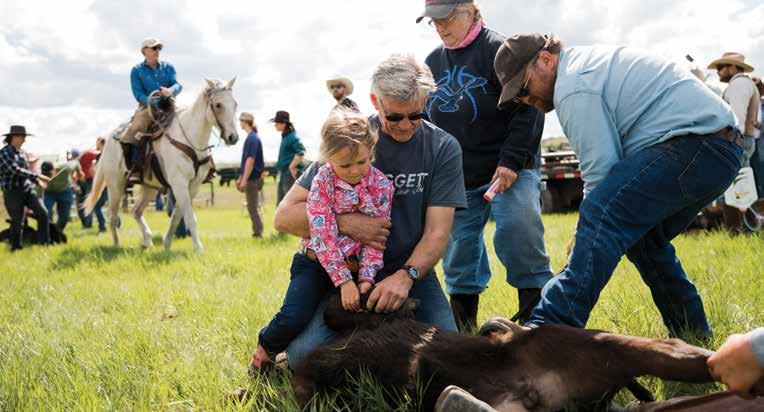

88
You can tell a lot by a person’s hands. Around here, most are rough and worn with dirt, cracks and calluses. They are hands that grip leather reins; clasp nippers, hammers and rasps; hands that carry buckets of chicken scraps; pound fence posts into rocky soil; pull calves; irrigate fields; rock babies to sleep; and cook for families.
Fred Daggett holds 5-year-old Hadley Hanson as she helps Mark Downing (right) hold down a calf.
me with such an important role. To this day, brandings are something I look forward to every spring. Being atop a horse, giving my go at throwing a rope, or just getting dirty wrestling calves always leaves me with a feeling of accomplishment and gratitude.
When the hard work is over, the cattle are let out to graze and the crew gathers for food and drinks. I can confirm that the meal that comes after a branding is extremely hard to beat. It’s almost as if each ranch’s branding becomes known for something delicious, and oftentimes you find yourself looking forward to it all year. For example, a few of my favorites: Lisa’s peanut butter monster cookies, Lori’s cinnamon twists, Jennifer’s roast beef sandwiches and baked beans. The family hosting the branding knows that they would not be able to accomplish such work without everyone showing up to help, and with each bite of the homemade meal you can feel the love and appreciation that went into making it.

“My job is the cooking, which I do enjoy,” Lori Kinsey says. “Branders always have good appetites. I like to have fresh cinnamon twists ready before they start because most of them hurry to get their own chores done so they can get to the branding, so they skip breakfast. Last year, I even had hot sausage egg muffin sandwiches ready. The hardest part is knowing when they will be done and ready to eat—because it is never when you think it will be! But I love to watch them and they always enjoy being together, doing what they love.”
Now at branding, you also get the chance to try the freshest Rocky Mountain oysters you will ever find, hot off the branding fire. Day-olds get fried in butter and scrambled in eggs. For you city folks who have no idea what I’m talking about: We are a long way from the ocean—these oysters are balls. Yep, straight off the bull calves. Sounds delicious, right?
Ranchers go to more brandings than they host; For the majority of the spring many leave their ranch at least once a week to help a neighboring one. And it doesn’t end with just showing up. No matter the time of year, it’s not rare for fresh baked bread, pies or farm-fresh eggs to show up on your doorstep. If someone is sick or going through a hard time, the community will come together and deliver full meals, aid in grocery runs, help wrangle kids and jump in at the spur of the moment when anything else comes up. If you are a
regular and miss Sunday church or aren’t at the local diner as usual, someone you know is sure to call and check in. If the cows get out or your truck breaks down, it doesn’t make you a burden to ask for help—it’s simply your turn.

Some may think this is a step back in time, and to an extent it is. There’s no DoorDash, Amazon same-day delivery, or Triple A to depend on, so we depend on each other. I might argue that a dependable, kind and giving community (which is commonplace in these small ranching towns) is far ahead of the times. We put our differences aside and come together. In the act of serving, you lose sight of greed and ego. I feel lucky to have grown up in this culture, surrounded by people who set such a great example of doing the right thing. Life in small town Montana runs on kind, generous, neighbors who are willing to lend a hand; the epitome of treating others as you want to be treated.

89
A sixth-generation Montanan, Maria Lovely embodies the spirit of the West. With her two border collies by her side, she spends her free time enjoying all that the mountains have to offer.
Top: Ry Groshens (left) and Ty Plaggemeyer enjoy well-earned drinks after a long day of branding.Bottom: Mark Downing (left) and John Hanson (right) hold down a calf while Mark Burke (center) does the branding.
The DNA of Who We Are
With their legacy of service, Montana’s Williams family makes community their business

 By Jack Reaney
By Jack Reaney
90
Carol, Whitney and Pat Williams reminiscing in the Williams family home, taken during Whitney’s campaign for Governor of Montana. Photo by Dorothee Brand.
April’s mild sun casts shadows across a blanket of evergreens on the steep hill outside Whitney Williams’ Missoula home. The bright reflection— golden-green forest and big blue sky—does better than lightbulbs could, as Whitney and her parents gather by daylight around her coffee table.
Whitney’s father, Pat Williams, points toward the hill. It’s part of the Rattlesnake Wilderness, which he earned federal protection for during his 18-year tenure on Capitol Hill.
“There’s not a rattlesnake in that land, that we know of,” he says, laughing. “It’s got a creek that runs through it [and] from the air it looks like a rattlesnake, curving back and forth.”
Pat’s not alone in his political clout: both Whitney and Pat’s wife, Carol, hold their own resumes of public service to the state their family has called home for six generations. Service runs in the Williams family like the gushing rivers that are the lifeblood of Montana.

It’s true for Whitney and her two siblings. “There was never a moment of choosing whether you were going to make a difference in the world... It was just the DNA of who we are, and where we come from,” Whitney says.
‘IT IS YOUR SKIN’
For Pat and Carol, they trace their political roots back to their upbringing in Butte, Montana, where they said one’s politics were woven into their personal fabric, not just a coat you can put on and take off.
“It is your skin,” Pat says. “You have to live with it all the time.”
“Everything was political, and everyone in Butte had an opinion about something going on,” Carol adds.
A three-term member of the Montana Legislature, Carol was first inspired by politics as a 10-year-old in Butte.
“I was out campaigning for a guy running for constable,” she recalls. “And I don’t even know what a constable does, but he was a next-door neighbor and a friend of ours, and so I thought he’d be a good constable.”
Growing up in Butte, Pat’s interest in public policy was a guiding hand that eventually nudged him all the way to Washington D.C. where he became Montana’s longest-consecutive-serving congressman.
“It wasn’t family, it was community,” he says.
Here in Whitney’s apartment in Missoula’s Rattlesnake neighborhood, just 2 miles from their own home, Pat and
Carol present just as much as a married couple of 58 years as they do legends of Montana politics.
Pat speaks in baseball metaphors and Carol answers questions with stories while Whitney plays the part of daughter, nudging along and filling in their wise, drifting narratives. She recalls growing up on the campaign trail, eventually moving from Montana to Virginia and Maryland.
“We had papercuts from stuffing mailings, licking envelopes,” Whitney starts, but Pat interjects.
“Well, I might have had you do a little campaign work,” he admits.
“Oh my gosh, knocking on doors, talking to people about voting for Dad,” Whitney continues. “Parades, holy smokes— every Fourth of July parade ever—I was in with some board weighing me down that said ‘Pat Williams’ on it.”
Pat laughs.
“We all show up for each other too,” Whitney says. “That’s a thing in our family.”
BUILDING THE LEGACY
Pat was a sixth-grade teacher in Butte for seven years before he ran for Butte’s District 23 in the Montana House of Representatives. As a state legislator, he was inspired to fight for education.
“There’s little in life that’s more important than education,” Pat says. “Whether you get it only from your parents—this happens in many nations—or you get it from this sparkling array of brilliant institutions in America that have provided [some] Americans with the best education in the world.”
After a successful transition into politics, he says he wanted to win again.
“And serve,” Pat adds. “Do what you ran to do, see some of the changes you want to make—make ’em. It’s a
“There was never a moment of choosing whether you were going to make a difference in the world... It was just the DNA of who we are, and where we come from.”
91
-Whitney Williams
powerful feeling.”
He spent 18 years working in Helena before reaching Capitol Hill, where he translated his passion for education into federal legislation. He supported the College Middle Income Assistance Act and served as chairman of the Post-Secondary Education Committee. He led the effort to create Tribal Community Colleges across the country and advocated for children with disabilities.

Also an advocate for the arts, Pat fought hard in the late ’80s for—and helped save—the National Endowment for the Arts, in perhaps his most recognizable achievement in Congress.
“Arts are about creativity,” Pat says in slow, careful measure. “America’s creativeness, its ability to explore and expand and understand, is in large measure a key to our greatness as a country.”
Pat took federal office on the heels of the Wilderness Act of 1964 and in the midst of a rising environmental movement, momentum that favored his environmental agenda: to “protect and freeze into place” Montana’s wild places that he grew up around. Pat hunted for “wilderness with a big ‘W’” as a member of the House Committee on Interior and Insular Affairs, now called the Natural Resources Committee.
He earned Wilderness designation, Congress’ strongest protection, across Eastern Montana’s “fragile, wonderful” ecosystems, southwest Montana’s Lee Metcalf Wilderness and the Rattlesnake Wilderness outside Missoula. He also led a campaign to designate a total of nearly one million acres of Wilderness across Montana, which

passed through Congress before being vetoed by President Ronald Reagan.
Carol moved to D.C. with Pat in 1979, where she became active in the nation’s current affairs. With Cold War tensions boiling, Carol founded an initiative called Peace Links to bring women into the conversation of national security.
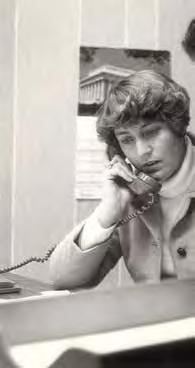
“You’d turn on the TV at night, and you’d have some issue coming up before the Congress and you’d have six men telling you what the deal was,” Carol says. “You’d never have a woman’s opinion on it.”
With co-founder Betty Bumpers, another activist and wife of former Arkansas governor and U.S. Senator Dale Bumpers, Carol recruited congressional wives and women leaders from across the country. By 1985, Peace Links launched an exchange program with Soviet women. They focused on speaking face-to-face and finding common ground—and they didn’t talk politics.
“We toured them all around the country,” Carol says. “Small towns like Primghar, Iowa, to Minneapolis, to Las Vegas—we took some to Kansas City when the World Series was going on.”
“Do what you ran to do, see some of the changes you want to make—make ’em. It’s a powerful feeling.”
-Pat Williams
Pat retired from office in 1997 and the Williams returned home to Montana. One year later, Carol ran into a friend at a bakery. The friend said he was going to quit the legislature, and he wanted Carol to run.
Pat told her, “I thought we came home to get away from all that.”
Carol respondes, “No, you went home to get away from all that.”
In 1999, Carol was elected as a state representative for Montana’s 69th House District. After one term, she joined Democrat Mark O’Keefe’s campaign for governor as his running mate.
During that campaign, Carol spent significant time in both urban and rural centers of Indian country, helping residents register to vote and educating them on voting. She and O’Keefe printed buttons with each tribe’s name, “Mark O’Keefe and Carol Williams,” and “vote” in that tribe’s native language. The Williams remember it is as a symbolic and unprecedented act.
O’Keefe and Carol lost the election, but the defeat didn’t overshadow the impact of their campaign, Whitney recalls.
“The next day, after we lost, Mom came in ... and says, ‘Do you know what happened last night? We elected more Native Americans into our state legislature than have ever been elected in Montana or anywhere in the country,’” Whitney says.

The campaign drove new voters to the polls, and while it wasn’t enough for Carol and O’Keefe’s win, it was enough to get Native American
representatives elected.
Carol waited a term before running again for the Legislature, this time the senate. She served a pair of four-year terms from 2005 to 2012, laying the groundwork for her activism around female leadership, as she became Montana’s first female minority leader. She eventually became majority leader, another first for Montana women.
“It was exciting, and an honor for sure,” Carol says. “But it was also a big responsibility, and you had a heavy load to carry. You couldn’t make a mistake. They were just looking for you to make a mistake.”
Carol believes she earned respect from both sides of the aisle. Chief among her notable accomplishments are the completion of her 20-year effort to establish full-day kindergarten in Montana, and with help from fellow senator Carol Juneau, the renaming of all geographic sites in the state called ‘Squaw.’ Carol and Juneau worked with tribal groups for 12 years, choosing names that had meaning in Indigenous culture.
Her resume doesn’t mean those wins came with ease. Carol says that all her life, she’s known it’s twice as hard for a woman to do the same thing that a man does. She flashes back to 1964.
Carol was a college student hoping to attend law school at the University of Montana. Her father set up a meeting with the longtime dean. She remembers it being a nice visit, until the dean insisted on walking her back to her car.
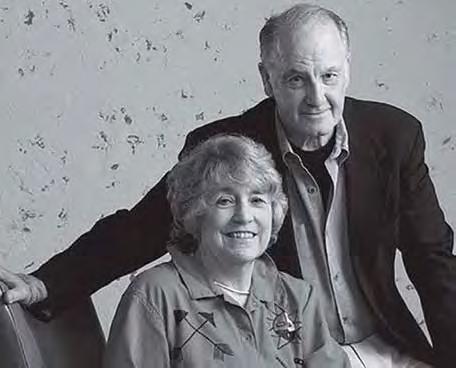
“When we got to my car, he said, ‘you know dear, women want to marry lawyers. They don’t want to
 Left: Pat Williams teaching an elementary class in Butte, Montana.
Photo courtesy of Williams family.
Middle: Carol and Pat campaign in 1978. Photo courtesy of Williams family.
Right: Pat and Carol pose for a portrait for ACLU Montana. Photo courtesy of Williams family.
Left: Pat Williams teaching an elementary class in Butte, Montana.
Photo courtesy of Williams family.
Middle: Carol and Pat campaign in 1978. Photo courtesy of Williams family.
Right: Pat and Carol pose for a portrait for ACLU Montana. Photo courtesy of Williams family.
be lawyers,’” Carol recalls.
Carol told the dean she was going to marry a teacher in a few weeks.
“When I got in the car and started home, I realized I wasn’t going to get into law school,” she says. “That year, only one woman was accepted into law school ... That was an eye opener for me.”
Carol’s service paved the way for many more women—including her daughter.
CARRYING THE TORCH
Whitney nods along at the coffee table as her parents recount their careers, even though she’s heard the stories a hundred times, and lived through many of them.
Born of these two catalysts of change, Whitney says she’s inspired by optimists, people “who [believe] that things are gonna get better and that we just have to do everything we can to fight for that future we believe can be true,” she says.
That attitude inspired Whitney to run for governor in Montana, a state where only one other woman has ever served in that office.
Whitney put in her bid for the state’s highest office during the 2020 election, running on platforms reminiscent of her parents’ values: Whitney pushed universal pre-K education, public school funding, reproductive freedom and healthcare funding for women.
As she campaigned, Whitney recalls kids thinking it was a normal thing for a woman to run for governor of Montana. Unfortunately, she says, it


wasn’t. “There’s only been a few who have ever run, and one who’s ever won,” she said.

Whitney lost the primary election by 10 points to established Montana Democrat Mike Cooney, who went on to lose the race to now-Governor Greg Gianforte. Whitney said she ran because she felt she was the right leader for a moment when democracy was at risk. She believes the Montana Legislature needs to reflect the state’s diversity. She says it has been improving—Montana has more Native American representatives than any state, and more women earn seats with every election—but the needle must continue to move, she says, “until we start to reflect who we actually are, like, moderate folks who just want the best for our community. That means we listen to people, that means we engage people,” she says.
She argues that Montanans are “more alike than we are unalike,” a sentiment she repeated all along her 56-county tour of the state during her campaign (her statewide journey was cut short due to the pandemic).
“I think even here in Montana we really do agree with each other much more than we disagree,” she says now. “I wish political people would point that out a little more often.”
Whitney doesn’t say whether she’ll run again, but offers: “You don’t know your future self.” She's got plenty on her plate, for what it’s worth.
Whitney is the founder and CEO of williamsworks, a social impact consultancy which advises Fortune 500 companies and private citizens on addressing global challenges through
94
94
activism, philanthropy, public policy and social entrepreneurship.
In 20 years, Whitney and her clients have launched the Eastern Congo Initiative to support Congolese-led community organizations, revitalized Puerto Rico’s coffee industry in the wake of Hurricane Maria and built skate parks around Montana—the fruit of a partnership with Jeff Ament, co-founding bass guitarist of Pearl Jam and native of Big Sandy, Montana.


Not long after founding the band 33 years ago, Ament decided to start building world-class skate parks across rural and isolated places in the West, mostly in Montana. He recently opened two skate parks on the reservation of the Crow Nation.
“Those kids down there have a new safe and fun outdoor activity,” Whitney says. “You talk to those young skaters across the state, particularly in those more rural places ... They will tell you how centrally important these places have become for community—making friends, learning life lessons, taking care of one another.”
Through williamsworks, Whitney is doing work that parallels Pat and Carol’s, just in a different venue.
~
Though retired from office, both Pat and Carol remain active. Carol co-founded an organization called the Montana Majority Pact—since renamed “Carol’s List”—to inspire Democratic, pro-choice women to run for public office in Montana. The nonprofit continues to help candidates on Carol’s List fundraise and campaign.
“We’re excited [that] for the last three sessions, the majority of Democrats in the Montana Legislature are women. That was just a total turnaround,” Carol says.
Since his own retirement, Pat has written for 20 newspapers, taught at the University of Montana, and still gives speeches. Carol jokes that some of those speeches are now held impromptu in coffee shops.
Four of the five Williams live in Missoula— Whitney’s sister Erin serves on the Montana State Board of Behavioral Health and spent 27 years with a Missoula nonprofit providing shelter and care for children facing abuse, neglect, trauma and substance use risks.
Here's an American family that sticks together in Montana, fighting for their vision of the last best place where they trace multi-generational roots, and serving those communities. If their names and titles are forgotten, their leadership and un-bargaining service will have blazed a trail for Montanans to follow.

Integrity, Whitney says, is willingness to fight for your beliefs, despite the consequences. Pat and Carol agree that integrity is honesty and staying true to your word.
Here's an American family that knows what they’re made of. Service is no façade for the Williams—unlike a jacket that can be removed, it is their skin.
Left to
Griff Williams, Erin Williams, Christine Treadway, Whitney Williams, Carol Williams, Fiona Easton, Pat Williams, Keelan Williams, Aidan Williams.
95
95
Jack Reaney is an Outlaw Partners staff writer and news reporter based in Big Sky, Montana.
Below left: The Williams family gathers in Missoula’s Upper Rattlesnake neighborhood.
right:
Photo courtesy of Williams family.
Below middle: Whitney walks along Lake Kivu in Goma, a city in Africa’s Eastern Congo where Williams’ company does philanthropy work. Photo by Fredrick Coubert.
Below: Whitney in the Democratic Republic of the Congo, on a hearing mission with Starkey Hearing Technologies.
Photo courtesy of Whitney Williams.
Escape to this summer. Montage Big Sky

Experience a bespoke Montana mountain escape brimming with the incomparable spirit of the American West, at Montage Big Sky. Here, guests and locals alike can delight in Big Sky’s wild side while also basking in the creature comforts that make Montana’s pure mountain nature more accessible to modern travelers. Featuring six dining options, from bowling & darts with craft brews and wood-fired pizzas to elevated traditional Italian and extensive wine list, Montage Big Sky has culinary experiences to satisfy all tastes.
Whether staying with us or simply enjoying one of our many experiences, we are delighted to welcome you. Make sure you make a stop for our nightly complimentary s'mores from 6-7p.m.



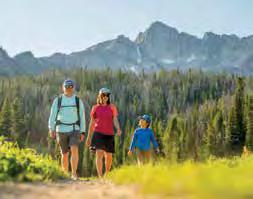
97
Settlement Trail | Big Sky, Montana
MontageHotels.com/BigSky 995
Fly Fishing in Montana can be a rugged, sometimes-tiring adventure—that’s why Madison Double R will be a welcome respite at the end of each day.


Located on the world-renowned Madison River south of Ennis, Madison Double R offers first-quality accommodations, outstanding cuisine, expert guides, and a fly fishing lodge experience second to none. Contact us today to book your stay at the West’s premier year-round destination lodges.



98
MADISONRR.COM • 406-682-5555 • office@madisonrr.com
Keep Montana, Montana

IF WE DON’T ACT NOW, Montana’s beloved wild places could be lost to development. Learn how you can help Trust for Public Land protect your access to the great outdoors. ForeverMontana.org


100

ENVIRONMENT THE ARENA OF CHALLENGE FOR GRIZZLIES // 102 ONE TRAIL AT A TIME // 112 CONNECT & PROTECT // 117 RIVER PEOPLE // 122
101
Scientists conduct biodiversity research in the Hart ranges of northern British Columbia. Read about the significance of this land--and much around it--in Connect & Protect on page 117. Photo: Tristan Brand.
THE ARENA OF CHALLENGE

102
FOR GRIZZLIES
Along Montana’s Rockies, an age-old battle plays out between humans and an iconic species
 By Benjamin Alva Polley
By Benjamin Alva Polley
103
Cows graze on the Rocky Mount Front west of Augusta, Montana, with Haystack Butte rising from the prairie in the background.
Photo Courtesy Andrew Bardwell.
West of Augusta, Montana, along the Rocky Mountain Front, Haystack Butte rises prominently from the undulating prairies and basket-of-eggs topography sculpted by glaciers. On the east side of the Bob Marshall Wilderness, the mountain’s limestone cliffs crash into a sea of rolling prairies. Winds roar off the mountains, stunting trees and massaging the tops of wheat fields. This biologically rich region is home to all the species that Lewis and Clark encountered on their expedition, save for big herds of wild bison; among them one of the state’s largest elk herds and bighorn sheep populations. Some people have referred to the area as the “American Serengeti.” It’s also one of the few places where grizzlies roam onto the prairie, something the region’s many cattle ranchers have mixed opinions about.
Andrew Bardwell and his wife manage three ranches here, encapsulating 30,000 acres of private and state land, with 1,200 head of cattle under the LF Ranch brand. Last year, Bardwell said they counted eight confirmed bear kills of their calves in a mere two weeks. On a given day in the spring, Bardwell said he might see up to a dozen grizzlies on a casual ride through his property. These “explorer bears,” as they’re called, travel
between grizzly ecosystems, becoming increasingly more frequent as brown bear numbers grow and reach carrying capacity in the Northern Continental Divide and Greater Yellowstone grizzly populations.
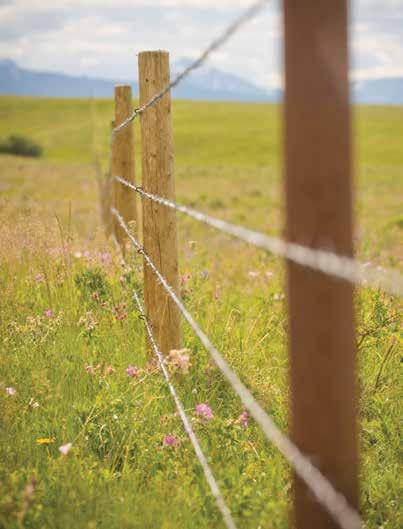
Some call this a conservation win. Others, like Bardwell, see it as a threat. When his calves are killed, Bardwell says he calls Montana Fish, Wildlife and Parks for help determining which predator is responsible. If they can determine the killer, the predator will be removed, and the government will compensate Bardwell for his loss. But when officials can’t prove that a bear or wolf killed the calf, Bardwell isn’t compensated, and the predators remain on the hunt. Bardwell wants to go after the predators, but because grizzlies are federally protected under the Endangered Species Act, he could face a $50,000 fine and a year in jail. “I’m all for delisting,” he told me one morning in March this year. “There’s got to be a better way to deal with some of these bears. I’m not talking about trapping and moving them. I’m talking lethal removal.”
Soon, Bardwell may get his way. The U.S. Fish and Wildlife Service plans to decide on whether or not to delist grizzlies within the year. If affirmed, the federal government would turn over management of the populations to the states in which they reside. After petitioning for such action over the last two years, Montana, Idaho and Wyoming are poised for the transition, with draft management plans that radically shift how humans would interact with the bruins when conflict arises. In Montana, stakeholders present anecdotal and scientific arguments on either side of the decision.
According to estimated historical populations, as many as 50,000 bruins once strutted from the West Coast to the Mississippi River and from Alaska to central Mexico. But during widespread Westward Expansion driven by a dominant settler mindset, settlers nearly wiped out the species between 1850 and 1950, eliminating 98 percent of grizzlies’ original range. What bears survived after this period of slaughter inhabited only remote wilderness areas, like Glacier and Yellowstone national parks.
But even then, grizzlies faced extermination with numerous bear-human conflicts resulting from park features like open-pit dumps where people could view the bears. From 1968 to 1973, a minimum of 229 known bears were killed in Yellowstone after the dumps were closed.
In 1973, the Department of the Interior sought help managing grizzlies. The Department of the Interior formed the Interagency Grizzly Bear Study Team (IGBST), a committee of biologists responsible for long-term grizzly monitoring and research in Greater Yellowstone. The group is the first of its kind, including members from the U.S. Geological Survey, National Park Service, U.S. Fish and Wildlife Service, U.S. Forest Service, the Eastern Shoshone and Northern Arapaho Tribal Fish and Game Department, and state wildlife agencies of Idaho, Montana and Wyoming. This interagency team shares data collection throughout Greater Yellowstone with the mission of producing reliable science to inform the management of the species.
By this time, grizzlies were in severe danger from several threats, including reduced habitat from the growing human
104
A fence cuts through a field on the Blackfeet Indian Reservation.
Photo by Stephen Simpson, Inc.
 A grizzly bear crosses the road in Yellowstone National Park.
Photo by Jim Peaco/NPS
A grizzly bear crosses the road in Yellowstone National Park.
Photo by Jim Peaco/NPS
“We’ve always believed that bears and humans must live in separate places and can’t co-exist. I think we can.”
–Cecily Costello
population, livestock grazing, logging, road construction, sport hunting, and a laundry list of other human-spurred events. In 1975, Yellowstone had fewer than 250 grizzlies left, triggering an investment in long-term research. That same year, grizzlies were placed on the Endangered Species List.
Because brown bears have slow reproductive rates, it wasn’t until the late ’90s that biologists saw grizzly numbers increase by 4 to 7 percent. In its 1993 recovery plan, the U.S. Fish and Wildlife Service identified six recovery zones in the Lower 48 States with sufficient habitat to support grizzly populations. Today, they boast estimated numbers that point toward a conservation success in several ecosystems: Greater Yellowstone (approx. 1,000), Northern Continental Divide (approx. more than 1,100), Cabinet-Yaak (approx. 55-60), Selkirks (around 80, including the Canadian portion). However, the BitterrootSelway and the North Cascades have no known populations, although there have been occasional sightings in the BitterrootSelway in recent years, likely originating from one of the occupied ecosystems.
The IGBST and other science teams have studied the potential connectivity between these isolated populations for genetic diversity, which hasn’t happened yet, though some metrics predict progress. The Northern Continental Divide and Greater Yellowstone populations are now less than 50 miles apart with the help of “explorer bears.” Biological islands like Yellowstone could connect soon if these bears remain allowed to wander. Now, just two years shy of their 50th anniversary under federal protection, the teeth of the Endangered Species Act have brought grizzlies back from the brink.
Many consider this one of the greatest wide-ranging conservation stories in the world. “It’s amazing we still have a healthy population of grizzlies recovered from almostextinction,” said Frank van Manen, IGBST team leader. “We
have the most southern population of brown bears in North America. It’s an iconic population, a real conservation success story. As a nation, we should be proud of what we accomplished in a landscape with this many people.”
For the USFWS to delist a species, they are required to determine if threats have been eliminated or mitigated. They also look to see if populations are stable and if there is plenty of quality habitat. They can “downlist” a species by reclassifying it from endangered to threatened if the agency deems it viable without ESA protections. Authorities call grizzlies “recovered” once they reach carrying capacity and spread from core areas. In 2007 and 2017, the Yellowstone grizzlies were delisted, but the latter decision was reversed after hunts were planned in Wyoming and Idaho outside park boundaries, essentially targeting “explorer bears” and thus preventing connectivity between populations.
On December 7, 2021, Montana's most recent petition for delisting was advanced by Republican lawmakers and signed by Gov. Greg Gianforte. “After decades of work, the grizzly bear has more than recovered in the NCDE, representing a conservation success,” Gianforte said in a press release. “As part of that conservation success, the federal government has accepted our petition to delist the grizzly in the [Northern Continental Divide Ecosystem], opening the door to state management of this iconic American species.”
Wyoming petitioned the federal government on January 10, 2022, and Idaho filed the petition on March 9, 2022. Idaho’s petition was denied.
After considering the states’ petitions to delist grizzlies from the ESA, the USFWS said the information presented in Wyoming and Montana’s petitions may indicate that grizzlies in both the Northern Continental Divide and Greater Yellowstone ecosystems may qualify for delisting. “The Service
 A rancher examines a dead calf killed by a predator on Andrew Bardwell’s ranch near Augusta, Montana.
Photo Courtesy Andrew Bardwell.
A rancher examines a dead calf killed by a predator on Andrew Bardwell’s ranch near Augusta, Montana.
Photo Courtesy Andrew Bardwell.
“There’s got to be a better way to deal with some of these bears. I’m not talking about trapping and moving them. I’m talking lethal removal.”
–Andrew Bardwell
appreciates the states’ historical commitments and partnerships to recover bears, particularly through conflict prevention efforts that have effectively reduced human-caused mortality,” reads a USFWS statement issued on Feb. 3, 2023. “However, the impact of recently enacted state law and regulations affecting these two grizzly bear populations is of concern and needs to be evaluated. We will fully evaluate these and all other potential threats, and associated state regulatory mechanisms, in detail when we conduct the status assessments and make the 12-month findings.”
While ranchers like Bardwell and other regional stakeholders seek relief from their grizzly woes, FWP grizzly
biologist
think it will be. “One of my fears about delisting is that many people think it will solve all our problems and lessen their conflicts,” she said. “Nothing much will change. State agencies, national parks and tribes do most managing now.” She says conflicts will always exist with growing human populations and grizzlies expanding their range.
“Seeing Montana being developed, and all the big valleys just covered with people makes me the saddest for the future of bears,” Costello said. And yet, she sees a future where coexistence is possible. “Working with grizzlies is fascinating because they’re constantly showing us more and more what they’re capable of doing,” she said. “We’ve always believed that bears and humans must live in separate places and can’t co-exist. I think we can.”
In this win-win scenario, though, Costello stresses that some of the onus must be on citizens, especially regarding scenarios that often produce human-bear conflicts—scenarios instigated mainly by humans. “It requires some level of commitment from the public to reduce attractants,” she said. “We can’t do all the work ourselves. The state cannot make the world perfect for bears.”
Indeed, the collision of humans and wild landscapes almost forces conflict, and those confronting grizzlies regularly want solutions. Among those collision points is the Blackfeet Reservation in northwest Montana, says Tribal member and State Representative Tyson Running Wolf. He says he respects other tribal outlooks regarding grizzly safety and survival, but says many other tribes don’t live with them. “[Grizzlies] have sufficiently recovered in isolated pockets and should be managed
accordingly,” Running Wolf said. “It’s hard when a law to save grizzlies is in place because many people don’t have grizzlies in their backyard daily.”
Folks like Bardwell and Running Wolf are witnessing increased grizzly movement spurred by expanding populations and environmental changes. In the alpine, blister rust and pine beetles, which are growing as temperatures warm, decimate whitebark pines, which provide nuts that are a primary food source for grizzlies. Fire may destroy what the fungus doesn’t, transforming forests into grasslands. Other food for the ursines, like army cut-worm moths, are increasingly less reliable, forcing grizzlies from the high country to neighboring ranches and towns in search of sustenance. Scientists question whether these events are static in time or are they climactic signatures that will magnify with a warming planet.
Twenty miles northwest as the raven flies from Bardwell’s ranch along Deep Creek, rancher Chris Bechtold also has a front-row seat to the bears’ evolving patterns. As the bears recover along the Rocky Mountain Front, he says he sees bears in places he never saw them before, moving up and down creek bottoms.
Bechtold manages 500 bison on a 34,500-acre ranch underneath the shadows of Castle Reef Mountain. Below the sharp relief, Douglas firs and limber pines grow stunted from the wind’s constant pressure. Sprawling golden pastures with winding coulees extend east toward rippling plains.
Bechtold lost one animal last year to grizzlies, but as he sees it, that’s just part of ranching in this setting.
“If you want a ranch with no grizzly bears, I hear ground's going cheap in Kansas,” he joked. His approach focuses on how he can manage his livestock rather than how he can manage
Map of the overall current condition for the six grizzly bear ecosystems in the lower-48 States, in terms of resiliency, redundancy, and representation. Colors represent the current resiliency for each ecosystem, based on the current condition of two habitat factors and six demographic factors for each ecosystem. Ecosystems with higher levels of resiliency are at less risk from environmental and demographic stochasticity. Caption and map adapted from USFWS.
107
bear research
Cecily Costello purports that delisting won’t be the silver bullet many
Current Condition High Moderate Low Very Low Extirpated North Cascades Selkirk Northern Continental Divide CabinetYaak Greater Yellowstone Bitterroot WASHINGTON MONTANA IDAHO WYOMING

“We all need to be grounded in our approach to bears. They’re neither good nor bad. They’re bears with bear behaviors."
–Chris Bechtold
A grizzly bear traverses below Sperry Glacier in Glacier National Park. Photo Courtesy Glacier National Park
the bears. He suggests ranchers could calve in the late summer when bears are typically up high, rather than in the spring when bears are starving and hungry after hibernation. Locating the “dead pile,” or deceased livestock, and hauling it away from the herd is also a proactive step, he offers.
“Most of ranching is common sense,” Bechtold said. “It's where you are calving and putting your dead pile. Most wildlife management is people management.”
He thinks aggressive grizzly management is based on fear rather than science.

“There’s a vocal minority constantly beating the drum that bears are everywhere and destroying our livelihood. Oh, my God, it’s the end of the world, and they will pull the kids off the front porch. I don’t subscribe to that,” Bechtold said.
“We all need to be grounded in our approach to bears. They’re neither good nor bad. They’re bears with bear behaviors,” he said. “We’ve become politicized in our general wildlife management and approach to wildlife. We have to decide how we want to live with them. They’re not the bloodthirsty animals that everybody makes them out to be. Ninety-nine percent of the bears people see are standing on the edge of meadows eating grass. Let’s not make them good or bad. They are what they are. They’re not hard to live with.”
Twenty-five miles due east of Bechtold’s ranch, Mark Fellows, a second-generation rancher, grew up where Spring Creek feeds into the Teton River south of Choteau. He and his brother manage 500 cattle on 6,500 acres of their parent’s ranch, which primarily deals in cattle and hay. His family deliberately calves in August and September to reduce bear conflict. Come spring, when bears come out of hibernation hungry and looking for easy meals, Fellows says the calves are bigger and can take better care of themselves. He frequently sees bears on the ranch but says he doesn’t have depredation and avoids bears rooting around garbage and pet food because of proper storage. Rather than push them out, Fellows wants to create a conservation area where bears can come on his property. “I have a soft spot in my heart for the bear,” he said. “What are the bears going to do? Habitat is constantly shrinking.” Fellows’ ranch is also in part locked in a conservation easement. He feels it would be hypocritical to take the conservation easement money from the Nature Conservancy for the ranch but not accept the bear.
Beyond the expanse of ranches, and in federal offices, the USFWS faces a weighty decision that the state’s proposed management plans will greatly inform. Though state officials author the plans, they have their critics.
“I used to be for grizzly delisting until a few years ago,” said
Chris Servheen, former recovery coordinator with the U.S. Fish and Wildlife Service for 35 years. “Montana’s proposed plan does not emphasize conflict reduction or coexistence.” The plan talks about reducing grizzly numbers and their range by killing bears outside their recovery areas deemed “threatening,” a term which is never defined in the plan.
“Montana’s draft management plan provides a ruthless approach to grizzlies outside recovery zones,” Servheen said. “It allows the killing of non-conflict bears just because they exist on public and private lands outside the recovery zones. This is such a departure from how Montana Fish, Wildlife and Parks used to do things in the past.”
In the last few years, Montana state’s legislature passed several bills allowing wolf snaring, expanding wolf trapping seasons into the period when grizzlies are out of the den, and using hounds for hunting black bears. All of these acts also infringe upon grizzly safety, according to Servheen. “In the past, there were good regulatory mechanisms that are now being eroded by legislation and politicians getting into wildlife management,” Servheen said. “Now, we got these new politicians in office who are pandering to the most extreme anti-grizzly bear elements, like we’re back in the 1800s. I don’t think it reflects the population of Montana. We don’t live here to exterminate all the predators, wolves and grizzlies and drive them into small pockets. Politicians shouldn’t be making wildlife policy.”
In this arena of challenge for grizzlies over the next year and beyond, citizens, state officials, scientists, and politicians must consider a world in which humans aren’t going anywhere, and many hope neither will grizzlies.
Benjamin Alva Polley is a place-based storyteller with stories published in Outside, Adventure Journal, Popular Science, Field & Stream, Esquire, Sierra, Audubon, Earth Island Journal, Modern Huntsman, and other publications at his website benjaminpolley.com/stories. He holds a master’s in environmental science and natural resource journalism from the University of Montana.
109
•
A grizzly sow hangs near Roaring Mountain in Yellowstone National Park with her yearling.
Photo by Neal Herbert/NPS





110 1565 Lone Mountain Trail, Big Sky, Montana www.acehardware.com | www.acebigskytools.com | (406) 995-4500 The helpful place in Big Sky with the T ls you need and the T s you want.







111 THE BEST MONTANA MADE JERKY & TREATS ysfoods.com ORORDER O SHOP L O C
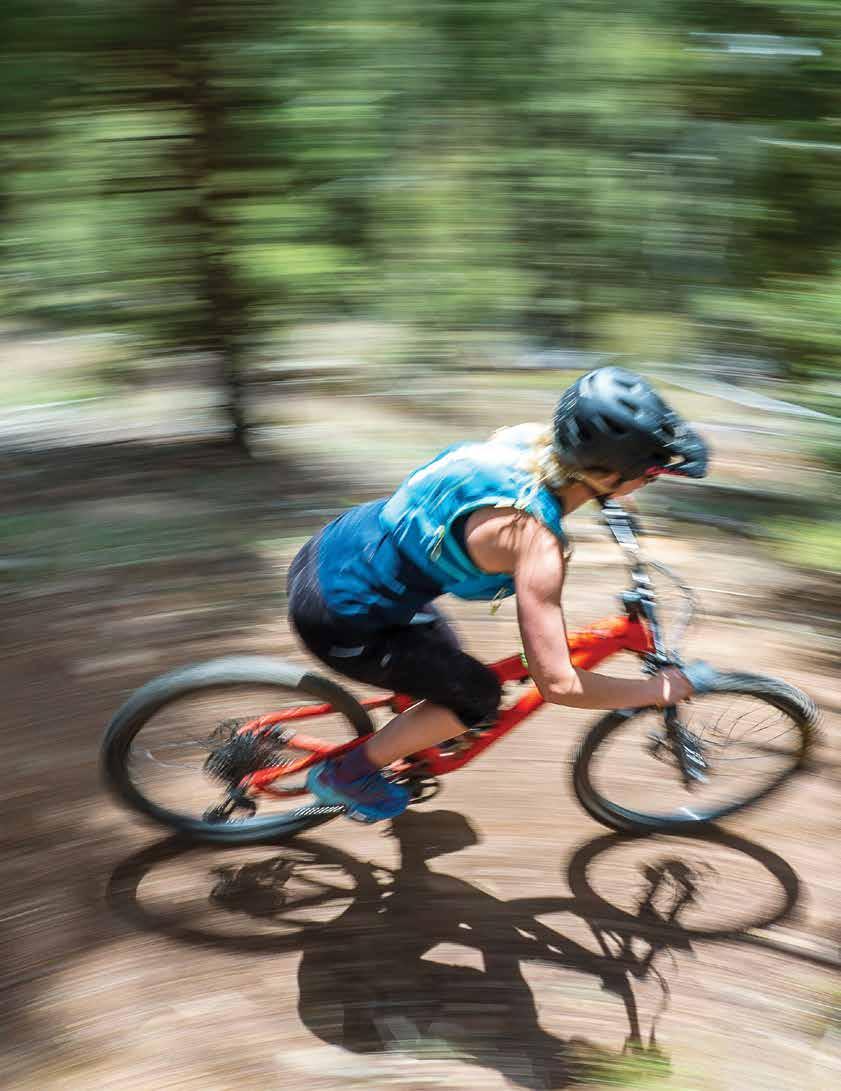 Anna Middleton rides on a Big Sky trail.
Anna Middleton rides on a Big Sky trail.
112
Photo by Micah Robin
One Trail aT a Time
Southwest Montana Mountain Bike Association is building connectivity in Big Sky—literally
By Jason Bacaj
among the Big Sky biking community in the late 1990s and early 2000s there used to be a joke about how heading off to ride singletrack was like going to work in a mine. The climbing was steep, the descents spicy and technically demanding.
Riders would sing to one another “heigh-ho, heigh-ho it’s off to work we go,” said Melissa Cronin, a fifth-generation Montanan who lived in Big Sky for about 25 years and helped lead early efforts to develop recreational trails around the area. While the Disney Snow White song is perhaps hyperbole, it underscores the challenge of mountain biking in the area back then.
“I was always super amazed looking back that we did what we did on the bikes that we had available,” said Cronin, who now serves on the Southwest Montana Mountain Biking Association’s executive board.

Not only were the trails difficult and bikes unforgiving, but riders also frequently confronted private property, dipping in and out of legal trails. That rogue era of mountain biking in southwest Montana almost sounds like fiction when contrasted with the sport today: Big Sky Resort rakes in summer business with more than 50 miles of downhill bike trails serviced by three chairlifts; bike shops are as common as ski shops in town; and a sprawling network of local trails are painting Big Sky as an up-and-coming bike town.
Trail connectivity is a huge part of not only making the area more bikeable, but in linking the community with its outdoor spaces and public land. One local organization in particular has made it its mission to advance trail connectivity in Big Sky, and it’s already got miles of trails to show for it. Southwest Montana Mountain Bike Association (SWMMBA) is a Bozeman-based nonprofit which builds community around biking through trail building, advocacy, events and education. The organization was founded in 2015 as a spin-off of the Dirt Concern of Gallatin Valley Bicycle Club and has been growing exponentially ever since, especially as interest in biking and the population of southwest Montana continue to swell post-pandemic. As proof, in August 2022 SWMMBA hired its first executive director, Josh Fairchilds, a longtime local who had worked with Oboz and Simms Fishing
113
Products. The chapter-based organization is expanding into territories beyond Bozeman, including a very active Big Sky chapter and the 2023 launch of the Madison County chapter in Ennis.
SWMMBA’s Big Sky chapter started during the summer of 2020, said Max Erpenbach, the chapter’s trails director. He and a few others around the area had been talking about how they could create a community trail work organization. The idea was to get people together for “dig days” to maintain trails, maybe host races, ride bikes together, run—really anything that had to do with improving access to trails and public land, Erpenbach said. Before long, the local effort met SWMMBA. The nonprofit provided a foundation of fundraising know-how and many years of experience organizing volunteer-based trail work. That first year, Erpenbach said the chapter hosted one trail day in September where folks worked on the regionally popular Mountain to Meadow trail, which connects Big Sky Resort to Big Sky’s Meadow Village with a 1.5-mile climb and flowy 6-mile descent. The following summer, the chapter gained momentum, offering 10 trail days.
Then, in the summer of 2022, an opportunity to build a brand new trail cemented the chapter’s mission of establishing more trail connectivity in the Big Sky area. The concept for the new trail, Tanner’s Way, arose back in 2019 when the Big Sky Community Organization, a nonprofit focused on year-round recreation and community partnerships, surveyed the community to inform its developing Master Trails Plan. Results revealed community interest in a trail connecting the Meadow Village area to the popular North Fork trail, which provides access to the Custer-Gallatin National Forest and the Lee Metcalf Wilderness.

There was just one problem: like much of the land around Big Sky, the public U.S. Forest Service land around North Fork abutted large swaths of private property, which would have to be crossed in order to make the connector trail possible. Luckily, the property owners’ values were in line with SWMMBA. The two families—the Kirchers and Nobles—worked with the BSCO to provide permanent public easements on their
properties to make the trail possible. Kim and John Kircher, former owners of Big Sky Resort, told the local newspaper upon the trail’s completion that they saw the project as a way to help ensure open access to the community. Their neighbors, the Nobles, mountain bikers themselves, jumped at the chance to provide access to the local community. The trail, Tanner’s Way, is named for the Nobles’ son, who died of a heart condition while biking in Big Sky in the summer of 2017.
“I feel like most of the private landowners here, they moved to Big Sky because of the outdoor recreation,” said Ashley Wilson, BSCO controller and SWMMBA Big Sky chapter president. “And I feel like the community members and the private landowners here in Big Sky are really open and want to help in any way that they can.”
Though the common interest is there, having an organization like SWMMBA is critical to transforming community interests and landowners’ buy-in to rideable trails.
Working with private landowners helped the trail project move quickly, said Patrick Rooney, SWMMBA trails manager. Once the easements and trail corridor were settled and agreed upon, Rooney and others cleared the trail with chainsaws and eventually with SWMMBA’s new tool, the mini excavator. The initial clearing was followed by six days of volunteers digging up roots, clearing branches and buffing out the trail. All told, the process of building out the 1.7-mile trail spanned a single summer.
While Tanner’s Way is a huge stride toward connecting the town of Big Sky with the National Forest trails, a short, trailless gap still remains between the Meadow Village and the end of Tanner’s Way. Wilson said she’s working with a local HOA to get the trail across some of the association’s open space and more fully connect town to the trail and, ultimately, public land.
“A connected community through trails is definitely a goal,” Wilson said. “Big Sky’s trail system has rapidly evolved just in years. And because Big Sky’s kind of a valley/island, if you will, that’s surrounded by private land or national forest, we the BSCO and SWMMBA have formed really good relationships with not only the U.S. Forest Service but also the
114
Volunteers help build the Tanner’s Way trail in Big Sky during the summer in 2022. Photo by Kent Sullivan
private landowners.
Wilson added that a major local development group, Lone Mountain Land Company, has been an integral partner of SWMMBA’s, with a shared passion for connecting trails motivating support for ongoing projects, one of which is expected next summer.
LMLC and funds from local resort tax will help SWMMBA foot the bill for an asphalt pump track that’s integrated with a skate park near Meadow Village, Rooney said, adding that tentative plans for the park also include a shade shelter, bathroom and landscaping. It’s a multi-phase project, but Rooney said the nonprofit hopes to have a dirt outline and track in place by summer 2024.
LMLC—which last year bought one of Big Sky’s most distinct areas, called Town Center— announced last October that the company plans to add more trail connections between town and trails near Michener and Mud creek toward the Gallatin Canyon, potentially as early as summer 2023.
“Where we’ve been trying to get involved is there’s so many great bike trails in Big Sky and a lot of them don’t go all the way into town,” Erpenbach said. “I hope that as Big Sky changes, [developers] continue to think about how these trail networks can connect in terms of in between the buildings and the concrete.”
Erpenbach moved to Montana 11 years ago and has since worked for Big Sky Resort. He’s witnessed Big Sky’s built environment expand, as well as the trails around it. A decade ago, he said mountain biking around Big Sky was mostly limited to lift-accessed riding and big backcountry adventures without much in between. Now, he enjoys after work rides, whether it be a flowy, shuttled ride down the Mountain to Meadow trail or a loop around the Hummocks and Uplands trails near Town Center.
After recalling the unestablished early days of mountain biking in Big Sky, Cronin says steady development of accessible trails around Big Sky “speaks highly of the people” in the community who’ve had the vision and been able to puzzle together the various pieces over time. “The community of Big

Sky has been phenomenal,” she said.
And yet, plenty of work remains. Wilson said trail connectivity between the four main areas of Big Sky— neighborhoods in Gallatin Canyon, Meadow Village, Town Center and Mountain Village—is crucial to addressing the community’s more pressing issues of traffic congestion and shrinking its carbon footprint.
“Everybody has been stuck [at the resort] or stuck because there’s an accident,” she said. “If we could work to reduce traffic, it would not only be safer for pedestrians and cyclists, it would be better for the environment just overall.” Such remediation is among BSCO’s top priorities.
Alongside practical considerations, improved trails and connectivity provide other benefits to the community. Cronin, whose own two kids grew up in Big Sky in the 2000s, said kids living in Big Sky nowadays have expanded ways to enjoy their surroundings that earlier generations dreamed of. Cronin credited this growth in opportunity in large part to the vision of local nonprofits, businesses eager to improve outdoor access and the willingness of community members to get their hands dirty—literally.
“If you look at all those components as a spoke on a wheel for community building, there’s a lot of things that have come together to make those trails as important as they are,” Cronin said.
The old days of “heigh-ho, heigh-ho” are a humble past for Big Sky’s cycling community, one that marks the expansive progress of the present. The future is full of opportunity, a flow trail of excitement and possibility.
“… If we realize, for the most part, people are good and that the concept of freedom of movement—especially on a trail system—is a really good thing; it’s good for the community, for the businesses, the people, the kids,” Cronin said. “That would be my wish for the future.”
Jason Bacaj is the managing editor of Explore Big Sky at Outlaw Partners.
115
“ i h O p e T h aT as Big s k y changes, [ devel O pe rs ]
c O n T in ue T O T h ink a B O u T h O w T h ese T r ail ne T w O r ks can c O n nec T in T e rms O f in B e T w een T h e B u ildings and T h e c O n cre T e.”
- m ax e rpen B a ch
Riders test out the new pump track at a dig day on May 12, 2023—SWMMBA’s first of the season.
Photo by Kent Sullivan









Montana ’ s LARGEST SELECTION OF BRANDS UNDER ONE ROOF Order Online Join our rewards program to unlock exclusive offers! JOIN LPCLUB!
Connect & protect
By Christine Nichol

117
A passionate group pushes conservation at scale for one of North America’s most critical wildlife corridors
One of several wildlife overpasses on the Trans-Canada Highway between Banff and Lake Louise, Alberta. Photo by WikiPedant at Wikimedia Commons.
Jodi Hilty grew up horseback riding with her mother in the Rocky Mountain foothills near Boulder, Colorado. In that hilly margin of grassland to forest, and the rise of plains to foothills to mountains, she was awakened to the sweep of long distances, big skies and connected landscapes. She vividly recalls one day she discovered a mountain lion's den, one of many lessons she would have in understanding that people, grazing animals and wild hunters all share the same habitat and call the same places home.
Since 2015, Dr. Hilty has been the president and chief scientist for the Yellowstone to Yukon Conservation Initiative (Y2Y), an organization that celebrates 30 years of support for conservation initiatives, scientific research and public policy advocacy for a region that stretches from the Greater
As generations pass, we forget the landscape as it was, and give ourselves permission to degrade our environment incrementally over time. To protect large landscapes involves memory, and an effort to re-establish earlier conditions.
Yellowstone Ecosystem in Montana to the Peace River drainage in Alberta, and the Rockies and Interior Mountains of British Columbia then north to the Yukon Territory. It’s an area that is home to at least 75 Indigenous territories. Hilty’s own research in ecological corridors and large landscapes has contributed to building this network, and notable work she oversaw was the foundation for the 2009 expansion of Nahanni National Park in the Northwest Territories from 1,840 square miles to 11,600, and the establishment of the Path of the Pronghorn protected migration route in Wyoming, among other landscape-level conservation initiatives.
Y2Y was established in 1993 with a base in Canmore, Alberta, within Treaty 7 Territory to conserve the world’s most wild large mountain region. It was founded on the growing understanding that large carnivores require a matrix of connected wild lands and parks, and that islands of protected habitat alone could not support the necessary breeding interactions and food availability with minimal human conflict. Research at that time indicated keystone species traveled much greater distances than had previously been understood, and without connectivity those populations faced poorer outcomes for individuals, and weaker populations over time.
For millennia, people have traveled across mountain landscapes too, but the footpaths of our ancestors posed no barrier to the movement of hunting animals and prey. As we settled and evolved as a society in the Mountain West, rail lines and highways have dramatically increased our mobility but have had a devastating impact on the survival of big predators. Some animals like wolverines will avoid crossing roads at all costs, remaining locked in zones with limited opportunities, while others like grizzly bears will forage in open rail corridors but suffer fatal collisions with passing trains. People carry new species of plants and animals as they travel and settle, and these newcomers can become invasive or outcompete native residents. We harvest forests and dig great open mines; we set fences and sprawl outward from towns. Our activity fragments swaths of habitat, leaving a patchwork of natural islands. Even the big Rocky Mountain parks like Yellowstone, Glacier, Banff and Jasper are not large enough on their own to protect viable populations of indicator species like grizzly bears, wolverines, gray wolves, mountain lions, lynx and fishers.
Y2Y is working to overcome this fragmentation in the Mountain West by funding ecosystem-based research and working to identify, protect and restore core habitat and corridors in a mix of public, private and conservation lands. On several projects, Y2Y has raised millions of dollars to support the purchase of properties from willing landowners, including along the Elk River in BC and at the confluence of the Yaak and Kootenai rivers in Montana, lands which are now held in trust by partner organizations for grizzly habitat conservation. The vision of landscape-level connectivity in part inspired the Montana Legacy Project, one of the largest mixed-use conservancy projects in the U.S. On a smaller scale, Y2Y works with private landowners too, to help them voluntarily protect land in key wildlife corridors. These parcels can facilitate passage of keystone species into areas where they have not been seen in decades.
Recent funded research projects include efforts to minimize conflict between ranchers and grizzly bears in the High Divide,
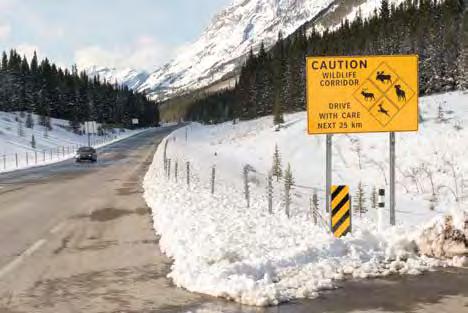
118
A wildlife crossing sign warns drivers in Kananaskis Country in Alberta. Photo by Aerin Jacob/Yellowstone to Yukon Conservation Initiative.
support for a crowd sourced ungulate data collection project on southern B.C. highways, and cumulative effects research in Alberta’s Bow River Valley. Y2Y is also working with partners to press for more wildlife highway crossings. Overpasses, open span bridges and underpasses with protective fencing to guide wildlife have been shown to reduce wildlife impacts by 90 percent and dramatically improve safety for the traveling public. Y2Y now works with highway departments in both the U.S. and Canada to establish more effective crossing structures.
Overpasses, open span bridges and underpasses with protective fencing to guide wildlife have been shown to reduce wildlife impacts by 90 percent and dramatically improve safety for the traveling public.
Internationally, Hilty led the writing of Guidelines for Conserving Connectivity through Ecological Networks, for the International Union for the Conservation of Nature; this outreach means the Y2Y model of conserving ecological connectivity can be shared around the world, and Y2Y can learn from work in other landscapes. By supporting scientific research, Y2Y has the information and the credibility as an organization to shape policy and action, and today connectivity is a growing aspect of conservation planning.
Across the region, more than a quarter of the protected area is managed or co-managed by Indigenous peoples, totaling some 14 million acres of land. Y2Y works closely with tribal leadership to advance shared conservation visions— such as the Nez Percé Camas to Condors whole-systems restoration
project—that weave traditional ecological knowledge with landscape-scale climate adaptation planning. And recently, Y2Y developed an Ethical Space series of educational materials to explore how Indigenous and non-Indigenous people can collaborate to build sustainable communities in healthy landscapes.
While the direct impact of the work could be difficult to measure due to the vast size of the corridor and the variety of ways connectivity can be protected and measured, in 2021 a paper in Conservation Science and Practice measured more than 80 percent growth in protected areas through the 2,100 mile corridor and counted 116 wildlife highway-crossing structures. The rate of protected area growth in the Y2Y region was more than double the rate across North America, and with new Indigenous-led protected areas being recently announced, protected area growth is on track to continue.
A region called Crown of the Continent, which links wilderness and Glacier National Park in Montana to neighbouring Alberta and British Columbia parks and public lands, represents the world’s first international peace park; Hilty oversaw some of the science that supported this conservation alliance. This “Backbone of the World,” with its mix of forest, grassland and crowning glaciers, has been home to the ancestors of the Blackfeet, Ktunaxa, Kainaiwa, Salish and Kootenai peoples since long before the times of highways, parks and national boundaries. Despite the growing pressure of development in these lands, a core understanding of connected landscapes long since held by Indigenous people is re-emerging.
Robert Sanford is a resident of Canmore who has devoted his life to passionate advocacy for interconnected landscapes, with a focus on the critical role of water. Sanford is the Global Water Futures Chair in the United Nations University Institute for Water, Environment and Health. He reflected on the path of Y2Y over 30 years, and commented on what he has

119
The North Saskatchewan River gravel bed system as seen from Banff National Park. Water from this river flows from glaciers in the Rocky Mountains through Edmonton and into Saskatchewan, providing drinking water to hundreds of communities and irrigation for agriculture along the way. Photo by Claire Jarrold.
witnessed of the organization’s work.
“It’s not enough just to be resilient; We need to not only protect what we have now, we need to anticipate what we need to have for the time to come,” he said. “We need to ensure the ecosystems that sustain us are intact as possible, in fact presilient,” he said, coining a new term that describes a kind of resilience that is anticipatory rather than responsive. He thinks Y2Y has uniquely managed to envision the needs of the future, and this foresight is unusual. As generations pass, we forget the landscape as it was, and give ourselves permission to degrade our environment incrementally over time. To protect large landscapes involves memory, and an effort to re-establish earlier conditions. He explained that Y2Y met such resistance when it was born in 1993 because the concept proposed different authorities over land use would have to cooperate to integrate protected areas. He believes it’s unlikely a project like Y2Y could emerge at all now, in a far more divisive social and political atmosphere. Y2Y laid down a social mindset of biodiversity and are leaders in anticipating change. “Over the long term, what they have done is extremely valuable for our
much of the key connectivity conservation work is carried out by non-government organizations like ranchers and land trusts. In both the U.S. and Canada, there is a growing assertion by Indigenous peoples to manage their lands according to their cultural values and deep tribal experience. Y2Y builds relationships and seeks ways to collaborate based on the underlying alignment of all people who live in and love the mountain landscape.
“We would like to be a model for the world, for how to maintain a functional landscape and live with these toothy animals like grizzly bears and wolverines, and to do it well,” Hilty said.
And the Y2Y large landscape ideal is spreading. The most well-studied road-wildlife crossing structures are in Banff National Park, a hub of international travel. This concept of safe wildlife passage across roads is becoming a model for the world. Hilty described projects in China to connect panda habitat, and in India to facilitate the movement of elephants. Near Los Angeles, work has started on the Liberty Canyon Wildlife Crossing—the largest highway overpass project in the world—to prevent the extirpation of the local mountain lion population and benefit other wildlife.
In 1993, the vision of connecting and protecting habitat from Yellowstone to Yukon was big, like the landscape itself. Thirty years later, we’ve grown to understand the value of large connected spaces and their essential role in protecting biodiversity against the pressures of development and climate change. We are learning to engage in conservation at a scale that nature needs and in which we can all thrive.

idea of the West, and creating a culture commensurate with the extraordinary landscape in which we live,” Sanford said. “The intelligence and wisdom they demonstrate has become an example of a Western landscape ideal, and what we have saved may now have the capacity to save us.”
Hilty emphasized that Y2Y will work with anyone who shares the vision, not simply environmental groups. In the U.S.,
Christine Nichol lives in Nelson, British Columbia, and raised her family there. She works as a project manager in the telecom sector, in partnership with remote Indigenous communities on the west coast of B.C. and the north near the border with the Yukon Territory. She is passionate about exploring mountains and rivers, aging and fitness optimization and suffers from relentless curiosity.
“We would like to be a model for the world, for how to maintain a functional landscape and live with these toothy animals like grizzly bears and wolverines, and to do it well,” Hilty said.
120
Conducting biodiversity research in the Hart ranges of northern British Columbia. Photo by Tristan Brand.





#1 in MT We’ll help you find a home to fit your lifestyle. We’re here. Today. Tomorrow. For you. For life. bhhsmt.com ©2023 BHH Affiliates, LLC. An independently owned and operated franchisee of BHH Affiliates, LLC. Berkshire Hathaway HomeServices and the Berkshire Hathaway HomeServices symbol are registered service marks of Columbia Insurance Company, a Berkshire Hathaway affiliate. Equal Housing Opportunity. For Life OURBANK.com /// 800.555.3800
 Travis Winn leads a first descent of the Salween River in Tibet in 2007. In the distance the landslide was the mark of a large rapid later named "Waimea".
Travis Winn leads a first descent of the Salween River in Tibet in 2007. In the distance the landslide was the mark of a large rapid later named "Waimea".
122
Photo by Kyle George.
river people
 By Eric Ladd
By Eric Ladd
Community Built on
A
Love and Respect for Rivers
123
The Yampa River flows along the Colorado-Utah border in one of the most remote wilderness areas in the United States.

In 1988, at the age of 15, I stood on its banks as a participant in an Outward Bound program for fledgling river guides, there to learn the techniques needed to safely navigate the river by raft.

The Yampa is a desert river framed by soaring sandstone canyon walls and a vast dry landscape that runs through Dinosaur National Monument. It is the sole tributary left in the Colorado River Basin to flow freely without a dam and is considered by many people to be the birthplace of environmentalism.
Starting in the 1950s, two proposed dams were set to destroy Dinosaur National Monument forever. Thankfully, due to the tenacity of the Hatch family (the founders of commercial river rafting) and David Bower from the Sierra Club, the dam projects were defeated and the movement for wilderness preservation was born.
On this particular day in 1988, it was my turn to guide the raft through a rapid called “Big Joe.” Along with my friend Josh Timon and other fellow students, I used rocks and sticks to draw the rapids as I explained my strategy for success and glory. I was given command over the 16-foot, light gray armyissued raft and six paddlers as we navigated the crashing waves and boulder-strewn river channel. My new language, the vernacular of a river guide, included terms like “all forward,” “dig it in,” “take a break,” and “high side.” This course was my introduction to the community of river people and was the trip that forever changed the trajectory of my life, giving me a lifetime connection to a fly rod and paddle as I experienced the tens of thousands of river miles to come.
Over the next 35 years I gravitated toward clean air and mountain rivers, guiding throughout the Rocky Mountains of Colorado, Montana and Idaho, across the deserts of Utah and reaching deep into the heart of the Grand Canyon in Arizona. I explored remote regions of Alaska and the far reaches of Argentina, Bali and New Zealand, and pioneered first descents on the Tibetan Plateau. Despite the various languages, scenery and cultures I encountered, all these rivers bound the people
124
The river has brought many people into my life, and I have developed some deep, lasting friendships.
Right: Boundary Expeditions guides pose for a photo during training on the Middle Fork of the Salmon River. Below: A group of students from Evergreen Junior High School paddle the Yampa River on an Outward Bound trip in Colorado.
I met along the way in a network of river folk—people who inhabit the waters, embrace the natural world and foster deep friendships. To live a life on the river is to live a life in a community, and that community comes in many forms: fishing guides, whitewater and kayak guides, explorers and outfitters, and conservationists. All these groups are forever connected by a common love for the life in and around flowing rivers. This is a window into that community, told through my own lifetime spent living at 3 mph.
The Fly Fisherman: patience
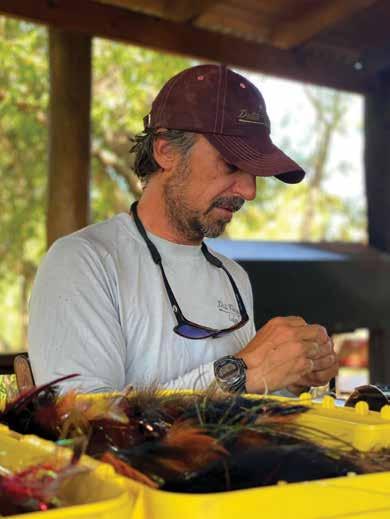

I was in middle school the first time my father took my brother and me fly fishing, a time before fly fishing was mainstream. Fly fishing requires a patient and gentle touch; the angler must connect with the river and learn to mimic insect patterns to entice the fish to bite. A perfectly presented fly pattern will yield an exciting rush as a fish takes the offering, performs an acrobatic dance on the end of the line and eventually wriggles back into the stream upon release. This
3 mph: a term co-authored with my friend Jeff Saad on a 6-day river trip on the Main Salmon River. It encompasses the fact and feeling of life on a river. On average, a river flows at 3 mph. This is also the average pace people walk, and per many scientists, it’s purported that humans are meant to operate at this speed. Life at 3 mph embodies a need to slow down, connect with nature, connect with friends and family, “stop and smell the roses” and separate oneself from the fastpaced world that surrounds us.
125
Left: Noel Pollack ties flies at his Argentina Delta Fishing Lodge. Above: Guide Jose Capparros, right, and angler Cameron Scott landing the prized Goldan Dorado fish at Pira Lodge.
bears a softness that feels more poetic than sport.
Fly fishermen are a community of introverts who nerd out on the science of entomology and are often found in some back room in their home tying complex fly patterns. Successful fishing guides have these things in common: patience, persistence and sunglasses tan lines from hours of staring at the surface of the river. In Argentina I met one of the legendary guides of the Southern Hemisphere, Noel Pollack. A famed dorado angler, Pollak runs the Delta Lodge, nestled in a bend of the river just outside of Buenos Aires. Pollack has been on a quest to perfect the art of fishing for golden dorado for nearly a quarter of a century and is arguably the foremost Yoda-like expert on this prized golden fish.
After a particularly slow day of fishing, Pollack offered some fatherly advice: “Welcome to the dorado world,” he said to one perplexed angler who didn’t land a fish. “Trust me that when it finally happens, it’s so, so special.” Days later our group explored the northern reaches of Argentina with Jose Capparros, a guide trained by Pollack. Capparros took us up remote stretches of rivers flanking the Iberá Marsh, one of the largest wetland complexes in the world. The skills Pollack and Capparros taught our group allowed for magical moments of connection with the golden dorado, the fish of a lifetime. The advice and wisdom imparted to me over the years from anglers like Pollak and Capparros now gets passed along to guests at my river company as we teach them the art of the fly and work to get them their first trout.
The Expedition Seeker: persistence
After years of running the backyard rivers around Colorado, my close group of river guide friends sought a more complex, expedition-style trip. Through a mix of fate and luck, our paths crossed with Pete and Travis Winn, a father/son duo from Grand Junction, Colorado, but transplanted to Lhasa, Tibet. The Winns had spent 10 years of their lives dedicated to historic first descents of remote Himalayan rivers. Travis also had ambitions of working with the Chinese Government to create awareness and protection for these cherished Asian watersheds. We hatched a plan and the Winns helped us organize the first descent of a 200-mile section of the Salween River in the high plateau of Tibet. The logistics of running such first descents is every bit as involved and as complex as climbing peaks like Everest. The chance to run a first descent of a Tibetan river in 2007 within a watershed as large as the Colorado River was truly once in a lifetime. Months of planning, tens of thousands of pounds of gear, a precarious drive over an 18,000-foot mountain pass, and willingly entering an unknown canyon at flood stage set the tone for the expedition. We set up base camp at one of the oldest monasteries in Tibet and lived with 40 monks while we made plans for how to handle the expedition and the historic monsoons that had caused the river to flood.

126
Eric Ladd rows the first descent of the Waimea rapid on the Salween River after following Jason Moore through a Class V rapid.
Photo by Kyle George.
As much as the opportunity to do this first descent was an honor, it was a tremendous responsibility, as the dangers and remoteness of this expedition were real. The largest rapid on the river consisted of 20-foot-plus breaking waves and holes, large enough to engulf a school bus. I ran second on the rapid behind Jason Moore, who grew up rowing as a lifeguard on the Atlantic Coast and applied big water ocean techniques to navigating the Waimea rapid (aptly named after the famous surf break in Hawaii). Moore and I continue to train guides today and apply lessons learned from that historic first descent, which has not been run since.
The people who inhabited the banks of the Salween included Tibetan monks and remote villagers who had never had contact with the Western world. These people lived right beside the Salween but had never seen a floating craft on the river. One can imagine the reactions when five rafts with colorfully dressed rafters and kayakers floated into their village shoreline. We met a yak farmer in his mid-80s who had lived in the canyon his entire life, with no contact with the outside world. As we took over his beach on a much-needed rest day, we shared stories through our interpreter about life’s journeys, including how his children had all departed the canyon, leaving him alone with his yaks and his river. While the technical, big-water descent of the 200 miles was harrowing, the river people we met were the soulful highlights of the expedition.

The Outfitter & Guides: family
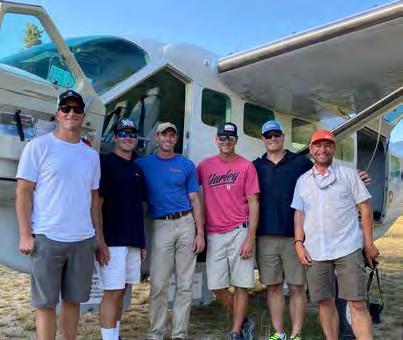
The profession of guiding people on the river is truly a heartfelt career, one which yields more deposits in the soul than the bank. Spending repetitive days floating down a river is a means of connecting with the natural world in an unparalleled way—with the added privilege of sharing this experience with guests.

In 2017 I had the opportunity to join a unique family of river folk when I purchased Boundary Expeditions, an outfitting company on the Middle Fork of the Salmon River. The Middle Fork is a river unlike any other in the Lower 48 and is consistently rated among the top three rivers in the world by National Geographic. Trips on the Middle Fork are unique in that they are fully immersive trips of nearly a week spent in deep wilderness. There are no roads nor cell service but ample amounts of hot springs, gin-clear water, star-filled skies and legendary riverside campsites.
Guides spend more than 80 days a season sleeping outdoors and living on the river’s edge. They not only help transport guests safely across 100 miles of this river but also share magical moments like catching their first native cutthroat trout, soaking in natural hot springs or drinking water straight out of bubbling springs. A personal Middle Fork highlight of mine was spending a week on the river with former First Lady Laura Bush and her close girlfriends. The First Lady was an inspiration on many fronts as she graced the river with her class, dignity, stories and humor. Flanked and watched closely by her Secret Service detail, I navigated the rapids with the added pressure of keeping this national treasure safe.
127
Top: Tibetan Villager and yak herder on Salween River. Photo by Toni Greisbach. Middle: The Stevens Brothers launching river trip with Boundary Expeditions - #axeals. Photo by Seth Dahl.
Bottom: A river family develops lasting lifetime friendships, Sean Glackin, Jason Moore and Troy Paulson on an enjoying a rainy day on the Salmon River.
Another incredible person who became part of my river family was Diana Yupe, a direct descendant of the Lemhi Shoshone Tribe who most recently worked as the Native American interpreter for the Salmon-Challis Forest Service/ Frank Church River of No Return Wilderness Salmon River. Yupe was stationed at a guard post alongside the river, a place our groups would often stop for lunch. On a given trip, Boundary Expedition guests got the opportunity to sit on the bank with Yupe and hear stories about how her tribe settled in this canyon to live among its rich salmon-filled waters and protect and cherish this place. Yupe always concluded her interpretive talk by blessing the rest of our trip with a Native American verse. Sadly, Yupe passed away in the spring of 2023.
A life of river guiding is tough on the body, but the connections made with guests and fellow guides often become lasting, family-quality relationships. The Boundary Expeditions guide family has become a testing ground for all my life, business and river guiding skills. The outfitting business has given me an opportunity to share my love for this life and this place with hundreds of guests and annual trips with three generations of my immediate family, all creating lifelong memories.

The Conservationist: “paying it forward”
My Montana home is built on the banks of a fork of the Gallatin River, now centered in one of the most iconic and fastest growing regions in the country. The Gallatin’s headwaters are in Yellowstone National Park, and it’s a prime example of a river that deserves care and protection. Enter the Gallatin River Task Force, a nonprofit that focuses on ensuring the river’s health and success for future generations, overseen by a board of directors of which I am a member.
Regional groups like the Gallatin River Task Force, Greater Yellowstone Coalition and national powerhouses like American Rivers have staff, efforts and donors dedicated to the preservation of watersheds throughout the country. They’re executing amazing work focused on counterbalancing the pressures brought about by human growth and climate change. For me, after a life spent on rivers, this work has become a tribute to these places that define me and my community.
Several months ago I walked along the National Mall in Washington, D.C. with Scott Bosse, an American Rivers regional director. Bosse and I reflected on his decade-plus effort to get legislation written and passed. It’s called the Montana Headwaters Legacy Act, a bill that would forever protect 20 amazing Montana waterways, including the Gallatin River.
Later I sat in the office of Montana Sen. Steve Daines with the latest version of my river family: seven conservationists banded together in D.C. to lobby for the MHLA.
Coincidentally, the office was decorated with photos of the very rivers we were lobbying to protect. In fact, each of Montana’s four delegates claim to love and cherish the rivers and lands of Montana, making it seem easy and apparent that this bill should fly through the D.C. red tape.

128
Three generations of the Ladd Family celebrating another successful fun of the Middle Fork of the Salmon.
Eric Ladd rowing First Lady Laura Bush through Middle Fork of Salmon. Photo by Seth Dahl.
The MHLA has 80 percent support among Montanans, landowners and state and county officials, as surveyed by the MHLA staff. This legislation is widely supported as a strong piece of legislation that will save these rivers from being “loved to death.” Montana Sen. Jon Tester has especially been a champion of conservation in Montana, and on that same D.C. trip, Montana Rep. Ryan Zinke showed particular interest in the bill’s merits and shared stories about his passion for paddling the great rivers of the Treasure State.

As we walked toward the Lincoln Memorial later that day, we discussed the fate of the MHLA bill. On those famous steps, invoking our passion, we hatched a goal of getting the MHLA bill introduced in 2023, knowing we would need to reignite the voices of the Montanans who support this bill to help get it passed this year.
The Promoter: “The Reverend”
Running in parallel with my river career has been my family’s connection to the movie A River Runs Through It, the film adaptation of a novella, both of which changed southwest Montana forever. So it seems fitting that a key character in the film, The Reverend himself, also known as actor Tom Skerritt, came into my life in 2022 with a mutual desire to create more awareness and protection for rivers. Skerritt’s storied movie career has brought him back to the Gallatin River waters, a river made famous by A River Runs Through It 30 years ago. Skerritt and his wife Julie have dedicated resources and time to creating a movie about river conservation and
Southwest Montana river advocates join a Headwaters Legacy Committee meeting with Rep. Ryan Zinke to discuss river conservation efforts. The Montana Headwaters Legacy Act will protect 385 river miles within the pristine Greater Yellowstone Ecosystem by designating segments of 20 streams as parts of the National Wild and Scenic River System. More information on MHLA can be found at healthygallatinriversmt.org
have teamed up with my company to produce the Wildlands Festival in summer 2023. The latest chapter of my river story now includes a three-day festival, the largest river conservation gathering in the country, with incredible artists like Lord Huron and The Foo Fighters performing in August with proceeds being donated to river nonprofits.
It seems fitting that many of the people I have met through my river career will be at the August concert. The river has brought many people into my life, and I have developed some deep, lasting friendships. On a summer night we will stand united in our respect and love for Montana’s rivers and deep reverence for the incredible watersheds across the globe that have taught us many life lessons. A wise person once told me that to fully protect and appreciate something, you must first fall in love with it.
“Eventually all things merge into one, and a river runs through it” – Norman Maclean
Eric Ladd has spent a lifetime on rivers and is dedicating the rest of his time giving back to them. Ladd is the publisher of Mountain Outlaw.
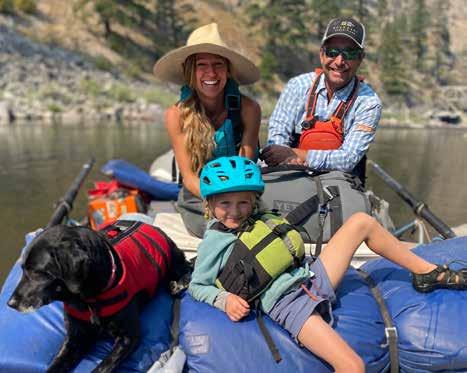 Eric enjoying river trip with wife Kaley, niece Teagan Ladd and faithful river dog, Black “Betty”.
Eric enjoying river trip with wife Kaley, niece Teagan Ladd and faithful river dog, Black “Betty”.







131
 Cheyenne Frontier Days is a rodeo and Western celebration held in Cheyenne, Wyoming since 1897. Mountain Outlaw contributor Matt Crossman, a St.Louis writer, writes humorously about his first experience with Frontier Days in My First Cowboy Hat on p. 142.
Photo by Tom Fries.
Cheyenne Frontier Days is a rodeo and Western celebration held in Cheyenne, Wyoming since 1897. Mountain Outlaw contributor Matt Crossman, a St.Louis writer, writes humorously about his first experience with Frontier Days in My First Cowboy Hat on p. 142.
Photo by Tom Fries.

SOCIETY STATE OF THE NEWS // 135 MY FIRST COWBOY HAT // 142 BIG SKY'S BLACK GOLD // 146


134 A GETAWAY YOU CAN FEEL GOOD ABOUT STAY SOMEWHERE THAT MAKES A DIFFERENCE Leadership in Energy & Environmental Design THE ONLY LEED CERTIFIED HOTEL IN MONTANA 25 EAST MENDENHALL STREET, BOZEMAN, MT 406-582-4972
State of the News

Community journalism is threatened but not extinct.
seasoned Montana journalist offers a prognosis.
By Dennis Swibold
Four decades ago, I drove a sputtering Toyota packed with everything I owned into a small northeast Montana town to take a job reporting for a twice-weekly newspaper in the oil patch. It was mid-winter, I was fresh out of college and my journalism degree from the University of Arizona would follow in the mail months later because I still owed a library fine. It was cold.
As for my qualifications, I could ask questions, take notes, read a police report, cover a basketball game and write an obituary. I knew little about my new home, but the people were friendly, if somewhat suspicious, so I slowly started asking about the town’s history, industry, people and passions that made it tick. Most folks played along.
My method was simple: Confessing my ignorance gave me an excuse to ask every dumb question. It worked well enough. After a few years, I became the Sidney Herald ’s editor, only to jump ship to the Bozeman Daily Chronicle, where I moved quickly from local government to state politics, covering two legislative sessions in Helena in the mid-1980s. That assignment allowed me to learn from some of Montana’s best reporters. Chuck Johnson, known even then as the “dean” of Montana’s statehouse reporters, introduced himself immediately. I joined a long line of young journalists he mentored while he led the Great Falls Tribune ’s influential capitol bureau, which served a vast swath of the state.
By the early 1990s, Lee Enterprises, which owned dailies in Billings, Missoula, Butte, Helena and Hamilton, had enticed Johnson to head the Lee

One
Longtime Montana journalist Dennis Swibold reporting on the 1987 Montana Legislature in Helena, Montana. Photo courtesy Dennis Swibold.
State Bureau, where he led another team of excellent reporters. In the small world of Helena journalists, the Lee State Bureau worked alongside a robust Associated Press Bureau, led by veterans John Kuglin and Bob Anez, who set a blistering pace for the rest of us and kept tabs on the state’s far-flung media. I’m not a big believer in golden ages, but surely this was one for Montana’s newspapers. The field then was nearly 90 papers strong, comprising 11 dailies and dozens of small-town weeklies where news is an intimate and crucial ingredient in the glue that binds such communities together.
Having started there, I have a soft spot for community papers. Years later, I made my devotion to them official by marrying the fast-typing daughter of the publisher, editor and chief ad salesman of the Harlowton Times-Clarion, which still arrives each week at our Missoula home. Scanning through the paper one day, I made a flippant crack about it being a quiet week in Wheatland County, only to be told curtly by my wife that I didn’t know how to read it. She patiently explained that you could only follow small-town drama by connecting dots of news scattered throughout the paper. You had to read it all: the police log, the marriages and divorces, births and deaths, the legal ads, the sports scores, school board minutes and especially the reports of the paper’s social correspondents, who chronicled family reunions, visitors, status updates
on children and former residents, and birthdays—down to blue icing on the cake. It also helped if you were related to half the town and babysat the rest.
Later, from my perch as a professor at the University of Montana School of Journalism, I dove into the state’s newspaper history, built on the bones of scores of long-dead papers. Some existed briefly in towns that have faded from today’s maps. The earliest were often scrappy, full of partisan vitriol and boosterism. By 1918, at the height of the homestead boom, roughly 200 newspapers served Montana’s tiny

population. Today, their names read like found poetry: the Light of the Valley, the Voice of the Range, the Age, the Silverite, Reveille, Liberator, Fair Play, Lookout, Outlook, Hornet, Bee, Post, Rustler and Miner. My favorites for sheer lyricism are Lewistown’s News-Argus, which still boasts that it covers central Montana “like the stars,” and the Vociferator, a short-lived Billings sheet whose slogan also served as its epitaph: “We did not come to Montana for our health.”

By then, the Big Money had rolled in, building railroads, mines, smelters, dams, sawmills and a collection of exceptional daily newspapers that brought the world to Montana while burnishing the reputations of their owners: Copper Kings Marcus Daly, William Andrews Clark and F. Augustus Heinze. Their hiredgun editors wielded their papers like battleships, blasting their rivals and cajoling their readers during the wildly corrupt fights for U.S. Senate seats and a permanent site for the young state’s capital. By 1904, newsboys covering Butte hawked four competing dailies and a changing cast of weeklies, each loyal to its faction or political cause.
Over the next three decades, industrial consolidation brought most of Montana’s significant dailies under the decades-long control of what would become the Anaconda Company. It finally sold the lot in 1959 to a group of loosely affiliated Midwestern publishers who would create Lee Enterprises, then
Media literacy today demands a curious and open mind tinged with the skepticism necessary to fend off squadrons of misinformation. It requires a healthy and varied diet of verified news and the mental bandwidth to accommodate a certain amount of uncertainty. News is nothing if not a process of discovery.
a small newspaper chain, but today one of the nation’s leading providers of news. With that, all the state’s dailies were back in the hands of publishers whose main business was publishing newspapers. Lee’s newspapers served the most significant chunk of the subscribers, followed by the Great Falls Tribune and scores of smaller dailies and weeklies, survivors of their own boom and bust cycles.
At least, that’s how I found it by the 1990s, as the Internet was cresting, bringing waves of unthinkable changes to media. Today, I read, watch and listen to nearly all my news online, subscribing to my local digital “paper” along with national news sites and podcasts. I donate to public media and nonprofit news organizations, skim a couple of social media feeds, thumb through texts and emails, and still sift through an array of magazines in the mail. It’s overwhelming, more than anyone can consume. Having the world’s information at your fingertips is mind-blowing, but it also comes with exhausting amounts of outrage and disinformation.

For many, it’s bewildering. A few years back, I started talking to groups around the state about what was happening to their news. The questions I get are earnest and thoughtful, but at some point, someone’s exasperation boils over. “I just want one place where I can go to get all the facts,” they say. I share the frustration, having grown up in a
time of relatively scarce news offerings, but there’s no going back to the days of Walter Cronkite and “That’s the way it is.” I can’t imagine any journalist today having that many listeners or as much authority.
As for finding all the facts, you can still find some of them on any given day, but pulling together the tiny “t” truth—or knowable truth—of events
is more complicated. Media literacy today demands a curious and open mind tinged with the skepticism necessary to fend off squadrons of misinformation. It requires a healthy and varied diet of verified news and the mental bandwidth to accommodate a certain amount of uncertainty. News is nothing if not a process of discovery.
The fragmentation and economic upheaval that followed the digital revolution have forever changed how news is delivered, altering the business model that supported it for so long. The change is reflected most dramatically in the nation’s newspapers, 2,500 of which have closed since 2005, creating “news deserts” and shrunken staffs in many that remain. The consequences for community and democracy are concerning. “Truth of the matter is, who I elect to the school board affects me much more than who I vote for for president,” news researcher Penelope Muse Abernathy told The New York Times. “That’s why we’ve got to get back to rebuilding local news in these struggling communities.”
Montana has lost only a few small papers over that time, but that doesn’t mean those remaining are without concern. The most imminent crisis for a daily’s survival is in Great Falls, home of the Tribune, owned since 1990 by the Gannett Co., America’s largest newspaper chain. Thirty years ago, dozens of journalists worked for the Trib, and today, that number is down to one

The fragmentation and economic upheaval that followed the digital revolution have forever changed how news is delivered, altering the business model that supported it for so long. The change is reflected most dramatically in the nation’s newspapers, 2,500 of which have closed since 2005, creating “news deserts” and shrunken staffs in many that remain.
Images of historic Montana newspapers courtesy of http://montananewspapers.org
stalwart editor and two reporters.
Cascade County, Montana’s fifth largest population, barely merits a notice from Gannett, which focuses now on its most prominent properties as it struggles to staunch the bleeding of advertising revenue, making it little better than the hedge funds nipping at papers’ heels. You can argue about economic reality, but it’s a lousy way to treat a community that has supported the Trib for more than a century.
To some degree, the challenges facing Gannett face most of the investor-owned media properties in Montana, many of which are scrambling for what’s left over after the tech giants siphon away most of the digital advertising dollars. But the pressures are uneven, and the survival of news organizations hinges on how much debt they carry and their ability to innovate, form partnerships and rethink their business models.
For all its struggles, news remains a primal human need. So it won’t surprise you that I’m bullish on journalism. Its forms will change, but the function is enduring. I see new players on the Montana scene and a renewed spirit of collaboration, so I’m hopeful. For instance, coverage of state government is as good or better than ever, thanks in part to the efforts of the digitalonly Montana Free Press and The Daily Montanan, two nonprofits that helped fill the gap left by The Associated Press’ dwindled presence. Meanwhile, the Lee papers have revamped their state coverage, establishing a strong Montana State News Bureau, though a new round of layoffs back at Lee’s local newspapers raises fresh concerns for local coverage.
Regarding state news, I also see a greater willingness among media organizations to share and welcome credible contributors like the nonprofit Kaiser Health News. Montana’s public media—especially public radio— remains a strong and innovative player in the daily news. And with help from the Montana Newspaper Association, Kaiser, and The Greater Montana Foundation, I’m proud to say a trio of journalism students under the editorship of veteran journalist Courtney Cowgill is providing valuable legislative coverage to a statewide network of dozens of weekly

newspapers and radio stations.
I’m encouraged too by the “hyperlocal” reporting of Jenn Rowell, do-it-all editor of The Electric, who is providing news her Great Falls subscribers can’t find elsewhere. Similar efforts by Martin Kidston’s Missoula Current and others in smaller media-poor communities are filling crucial gaps, often partnering with social media and local civic authorities struggling to get basic information to the residents they serve.
It’s not always sexy stuff, but it’s crucial to providing readers with what Cowgill calls “newstrition.” Nobody in Montana’s news media understands that better than the state’s venerable weeklies,

the best of which describe what they do as a lifestyle built around an ethic of service—not chasing clicks.
Fact-based public service journalism, not angst-ridden diatribes, is what communities need to last long term. The boneyards of Montana journalism are filled with partisan publications that never got that message.
Dennis Swibold is a professor at the University of Montana School of Journalism and a former editor of the Bozeman Daily Chronicle and the twice-weekly Sidney Herald. He is the author of Copper Chorus: Mining, Politics, and the Montana Press, 1889-1959.
YOU DREAM. WE BUILD.
Inspired by the dynamic landscape of the Rocky Mountain West, we bring the visions of owners, architects and craftsmen together to create exceptional handcrafted custom homes.


Teton Heritage Builders integrates the quintessential elements of the regional palette –stone, timber, log, glass and steel – to craft high-quality homes that reflect the character of their distinctive surroundings. At the intersection of rugged wilderness, rustic aesthetics and timeless elegance, building unique homes with a deep connection to place is our passion.
BIG SKY | JACKSON
Visit tetonheritagebuilders.com to start building your dream.

139

140


My first cowboy hat
Words by Matt Crossman | Illustration by Madeline Thunder
Dust dances in the rodeo arena in front of me as a parade of livestock marches toward the chutes. Behind me, kids in the bleachers stuff themselves with cotton candy and Western-clad adults swig beer. I stare intently at the bulls and the men atop them, co-stars in this portion of that unequaled celebration that is Cheyenne Frontier Days.
As one cowboy after another gets bucked, I have an uneasy feeling that everyone is staring at me. Or more to the point, staring at my hat. My cowboy hat. It’s the first one I’ve ever owned, and this is the first day I’ve ever worn it. As I lean against the railing, it feels like I’m standing under a giant neon sign that says POSEUR with an arrow pointed toward my head garment.
I had long planned to take advantage of my media pass and go behind the scenes at the rodeo, but to do so I needed a cowboy hat. I mean that literally: the Professional Rodeo Cowboys Association requires anyone who will be anywhere
they might end up on TV to wear Western clothing. That means a Western shirt, jeans, cowboy boots, and yes—a cowboy hat. This was not my first rodeo, but it was the first time I’d encountered the dress code. I had jeans on; my shirt was sufficiently Western to pass the eye test; and apparently nobody noticed my blue Saucony running shoes. But my naked head was a glaring infraction that needed to be covered. So before the rodeo, Andi Jaspersen, the extraordinarily patient Visit Cheyenne representative assigned to make my trip one to remember, shuffled me over to The Wrangler, a cowboy hat store in downtown Cheyenne, so I could get fitted for my very first cowboy hat.
I’ve lived in the Midwest, South and East and had never been to—nor even heard of—a cowboy hat store. As it turns out, this is a significant moment in a man’s life, especially a man who’s never owned and barely worn a cowboy hat. I walked up and down the aisle, looking for the perfect lid, something that

said: I don’t look ridiculous in this at all; in fact I feel completely comfortable with it on.
Not a single one said anything like that.
I asked a salesman for help. I told him I wanted a hat that would keep the sun off my face and neck. I learned later I had asked for a cowboy hat that did exactly what cowboy hats were invented to do. Next up: going to the glove store to ask if they have anything that will keep my hands warm.
I smushed a few hats onto my head. The one sized 7 5/8ths felt right.
“How do I know if it fits?” I asked.
“Go like this,” the salesman said, plucking the brim with his finger. I plucked it. It didn’t budge. I guess it fit. Another employee steamed my selection, then bent it to fit it to my face. I thought the whole process might be a con, and I suspect they might still be laughing about how the dope from St. Louis fell for the steaming bit. But I went along with it. The salesman placed the hat gently on my head, adjusted it just so and declared me ready for my debut.
It only took one peek at my reflection for me to sorely disagree. I looked in the mirror … and saw a fraud.
Y’all out West are friendly as can be—and terrible liars.

•
This year’s Cheyenne Frontier Days will be the 127th. It will bring in approximately $40 million in revenue spent by roughly half a million visitors, and just about all of them will be wearing cowboy hats.
I learned from talking to cowboys and cowgirls in Cheyenne that a cowboy hat symbolizes a hard-earned outlook on life, a devotion to rugged individualism. The best cowboy hat is a perfectly fitted (and immaculately steamed, allegedly) declaration that you can stand on your own two feet and look good doing it. A cowboy hat connotes confidence but not arrogance, humility but not acquiescence, a calm patience and understanding that things will work out for the best—and you’ll figure it out if they don’t.
“Everybody that’s wearing these hats are doing an homage to a lifestyle that actually made this part of the
country what it is today,” said Mike Kassel, associate director and curator of collections at the Cheyenne Frontier Days Old West Museum, one of many places to which I wore my new hat.
He’s right about the homage, and the reason I felt unworthy of my hat is I have nothing to do with that lifestyle. I mean, I can ride a horse so long as it doesn’t run. Or trot. Really I prefer it to not move at all.
At the rodeo one glorious afternoon, I sat next to Cheyenne Mayor Patrick Collins. On this outing, he donned one of his three cowboy hats. This one was made of straw (like mine) because no self-respecting cowboy wears anything but straw outside at a rodeo in the summer (or so I’m told).
“When I see cowboys, I think really highly of that species of people,” Collins said. “They’re the hardest working, straightest-shooting kind of guys. To be considered in that category, for me, would be an honor.”
Collins looked like he was born in his hat, so I was shocked to learn he too was a newbie to cowboy hats, even though he’s lived in Cheyenne since the 1970s. When he finally bought one a few years ago, he went through an extensive fitting process for a hat made of beaver. When he put it on, he had the same reaction I did: I feel like I’m in a costume. “But I can’t tell you how much I look forward to doing it now,” he said. “It just feels right.”
Yee-haw! Maybe there was hope I would eventually grow into mine, too. But that afternoon, I still felt like a teenager with peach fuzz who thinks he needs to shave. In this region that so values authenticity, surely everyone saw right through me. I wanted to take it off. I kept wearing it only because Jespersen and others told me I looked fine.
As I mentioned: Y’all out West are friendly as can be and terrible liars.
As it turns out, my own process of fitting into the cowboy hat mirrored Cheyenne’s. Western gear wasn’t always de rigeur at Frontier Days. For the first 20 years or so, locals wore “normal” clothes to the festival, according to Kassel. “Even some of the cowboys would be wearing shirts, ties and blazers,” he said. “You wouldn’t think you’d see someone in a nice Windsor
knot getting on top of a bucking bronc and having a good time. But it did happen.”
During the late 1910s and early 1920s, Wyoming went into a depression a decade before the rest of the country. Looking for a way to lure tourists (and their money) to Cheyenne, city leaders embraced the popularity of movie Westerns. They put out a call to locals to dress like they were going to appear on the big screen. “It became really popular,” Kassel said.
Flash forward more than 100 years, and cowboy hats are the unofficial uniform of Frontier Days.
•
I love to travel because I get stretched and pulled. I learn from the culture wherever I go. I study how people live, love and work. When I return home, I’m stronger, like a cowboy hat that never loses its shape no matter how many horses trample it.
The days I spent in Cheyenne observing cowboys and cowgirls and talking to them about their hats, I was reminded that the true spirit of the cowboy, while symbolized by the hat, far transcends any attire. Those days reminded me that hard work brings joy in and of itself. They reminded me to celebrate early mornings, hard days and memorable nights. And they reminded me of the value of chivalry and honor, of telling hard truths, and of getting back on the horse no matter how many times you fall off.
With these lessons retained under my new garment, I kept the hat on. After wearing it to the rodeo, to the Old-Fashioned Melodrama at the Historic Atlas Theater, for steak at the Wyoming Rib & Chop House and downtown to the biggest pancake breakfast I’ve ever seen, I started to feel comfortable. A few days in, I forgot it was there; the hat became part of me.
I am western, I am free, I am a cowboy! I thought. I suppose I could’ve pulled that off, too, if I didn’t bang it into the car door every time I tried to get in.
Matt Crossman is a St. Louis-based freelance writer. He covers NASCAR, travel, adventure and, apparently, cowboy hats.

X Equestrian Property Specialist. Cortney Andersen, Realtor/Broker | Engel & Völkers 406-599-1990 | CortneyAndersen.com
Unwind and Exhale at

Retreat to our mountain escape where you’ll find heightened serenity among elegant alpine-inspired design. Soothe the mind, body and spirit in our 11,000 square-foot sanctuary and indulge in sophisticated amenities including an indoor lap pool, relaxation lounges, heated plunge pools, steam rooms and a full-service Salon Montage. Customized therapies include our Elements of Wellness rituals, Valmont skincare facials and romantic journeys just for two.
Open daily, visit us at Montage Big Sky. To book a treatment, call (406) 993-8368.




145 MontageHotels.com/BigSky | 995 Settlement Trail | Big Sky, Montana
Spa Montage.
Alow roof of clouds obscured Lone Mountain on the gray April day I followed Peter Bedell into a warehouse-like building at the Big Sky Water and Sewer District’s wastewater treatment plant. The smell as we stepped inside struck me. Instead of the nasal assault you’d expect of a place that processes human waste, I was met with an earthy aroma, like a mossy forest after a rain.
Bedell, one of the district’s certified wastewater operators, had started our tour of wastewater processing at the headworks building where raw sewage enters the plant. He then showed me the pair of giant batch reactors that separate the liquids from the solids, followed by the maze of pipes and filters that treat the effluent before pumping it out to a holding pond. But what I was really there for was this: the final stop on the tour, where the solids are alchemized into a fertile resource.
Bedell led me to an 8-foot-tall pile of the end result: compost. To my untrained eye, it looked like dirt—or soil, more precisely, with its dark hue and a texture indicating organic composition rather than mineral.
“That’s the finished product,” he said, scooping up a bare handful. “Smell it.”
Tentatively, I leaned forward and took a whiff. There was no doubt this material was the source of the building’s earthy aroma. Without knowing it, you’d never guess the loamy material Bedell proffered had been human feces mere weeks ago.
Why Compost Human Sh*t?
Although composting food waste has become a popular way for folks to participate in the sustainability movement over the past decade in southwest Montana, municipal composting of human excreta in the United States is a far less acknowledged trend.
Regardless of its mainstream invisibility, “biosolids composting,” as those in the wastewater industry call it, is becoming an increasingly attractive alternative to long-used waste disposal methods.
While you simply flush your waste down the toilet and likely don’t think about it again, every wastewater treatment plant in the country must decide what to do with the biosolids that remain after the treatment process.
One option is to truck the municipal sludge to a landfill. But this means a shorter lifespan for the landfill, higher costs for the wastewater district due to tipping fees, and the production of methane, a potent greenhouse gas created when organic matter decomposes without oxygen—not an ideal solution.
Another option for biosolids disposal involves spraying them in slurry form on farm fields to add important nutrients like nitrogen, potassium and phosphorus to the crops. But according to industry expert Steve Diddy, this too is complicated, requiring land on which to apply, costly permits, careful monitoring and a longer growing season than Montana has to offer.
In contrast to landfilling or land applying municipal sludge, composting allows wastewater management facilities to create a sanitized, microbially vibrant and nutrient-rich product they can sell back to their communities.
Suddenly, human feces goes from waste to valuable input. What was previously an untouchable end is now a bountiful beginning. Biosolids composting: a circular economy operating right under our noses.

Spinning Straw into Gold
Composting can be as simple as a backyard pile of food scraps and dried leaves, or as high-tech as insulated, temperature monitoring, auto-aerating containers that precisely optimize the environment for beneficial microbes to thrive. With the right balance of inputs and proper moisture, the former method might take a year to create the rich, fertile material that is compost. The latter—which describes Big Sky’s municipal composting system—takes a matter of weeks.
Whether occurring at a simple at-home scale or an industrial one, a few things must be true to qualify the process as composting: bacteria do the work of heating up the mass and
146
By Bay Stephens
Photo: vecteezy.com
breaking it down (killing pathogens); the process takes place in the presence of oxygen; and humans manage it.
“Compost, like agriculture, is a human creation,” writes compost guru Joseph Jenkins in his book, The Humanure Handbook. “You will not find it in nature any more than you will find a corn field.”
Once raw materials are combined, the process involves three phases: mesophilic, thermophilic and curing.

In the mesophilic phase, bacteria that thrive at moderate temperatures begin consuming organic matter, combining carbon and oxygen molecules to form carbon dioxide, water and heat.
As these bacteria munch, they multiply and raise the temperature of the pile to a point where a different class of heat-loving bacteria take over. These thermophilic bacteria continue to break down organic material, upping the temperature as high as 185 degrees Fahrenheit, though usually topping out closer to 158. If held above 140 degrees for three consecutive days, this natural biological activity reduces the number of disease-causing bacteria to undetectable levels, the EPA’s version of zero.
The cooling or curing phase ensues. Beneficial bacteria, protozoa and fungi migrate back into the pile, further decomposing organic matter and eliminating parasites.
If a pile traverses these three phases, the result is a material rich with organic nutrients, beneficial microbial life, desirable agricultural properties and virtually no disease-causing organisms. Thanks to the marvelous labor of these microbes, a fetid heap of waste is transformed into the fertile matter composters call “black gold.”
Black Gold

From enriching soil to saving money to remediating pollution to retaining water, compost offers a host of benefits. For starters, compost holds a whopping nine to 20 times its weight in water. This means soil amended with compost not only holds more water, but it holds that water for longer,
empowering plants with greater drought resistance.
And when tested against synthetic fertilizer, compost was shown to furnish the same or greater vegetable yields than NPK (fertilizer made with nitrogen, phosphorous and potassium). The big difference, though, is that fertilizing soil with compost instead of synthesized fertilizer builds soil year over year, rather than slowly depleting it.
In other words, compost builds resilience into agriculture.
Composting is also one of the most effective ways to bind up or break down contaminants, according to Dr. Sally Brown, a research associate professor at the University of Washington specializing in land remediation and biosolids reuse.
This remedial quality of the process renders composting especially apt for biosolids recycling because more than just human waste goes down the drain. Biosolids contain varying levels of heavy metals, toxic chemicals, and per- and polyfluoroalkyl substances (PFAS). But the alchemy of composting binds up these contaminants in such a way that they are generally less available for humans.
“A lot of the best ways to remediate soils and biosolids is actually through biological activity, so composting,” said Karl Johnson, owner of Yes Compost in Bozeman.

While biosolids composting is quite commonplace, it’s still gaining steam. Livingston, Montana’s water reclamation facility uses the same hightech, containerized composting system as Big Sky, selling their compost in bulk to residents. In the western reaches of the state, Missoula’s wastewater treatment plant does the same.
The city of Bozeman collaborates with the nearby Logan Landfill so its biosolids are composted at the landfill, then used to cover completed sections.
Gallatin Solid Waste District Manager Jim Simon said this effort diverts 15,000 tons of organic matter from the landfill every year by composting biosolids
onsite. That’s equivalent to a month’s worth of waste.
Further north in Kalispell, Montana, biosolids have been trucked to Olney, Montana, since 1993, where they’re transformed into Glacier Gold compost, a product sold in at least seven states.
In many cases, biosolids composting kills at least two birds with one stone. In the case of Glacier Gold, the practice allows the logging operation in Olney to put a mountain of sawdust and wood chips to good use, rather than burn it. And Kalispell has saved untold acres of landfill space.
“We’ve taken two problems on this planet and created a positive,” said Joe Warner, a long-time Glacier Gold employee.
Selling their compost in bulk for $25 a cubic yard—about half a pickup-bed load—Big Sky Water and Sewer District has no problem getting rid of it. And those who overcome the initial “ick” factor of using composted biosolids tend to have rave reviews.
Bay Stephens is a former Outlaw staff writer and editor. He currently lives in Colorado where he builds bike trails in the summer, ski patrols in the winter, and nurtures his curiosity with great books, audio and film.
147
Above right: At this stage in the composting process at the Big Sky County Water and Sewer District, the batch reactors (pictured) presses liquid out of the biosolids to prepare it for the mixer, where it will be combined with sawdust and wood chips. Photo by Bay Stephens. Right: Wastewater operator Peter Bedell sticks a shovel into a finished pile of compost at the Big Sky County Water and Sewer District. Photo by Bay Stephens.
BESPOKE LIVING IN DOWNTOWN BOZEMAN


FEATURED RESIDENCE 203 3B, 2BTH | 2,307 SQFT
Wildlands is located in Bozeman’s vibrant Northeast neighborhood and consists of 12 high-end residences only four blocks from downtown and 10 minutes from Yellowstone International Airport.





With a mix of Scandinavian-modern architecture and industrial elements, the finishes at Wildlands are the highest of quality, including Poliform cabinetry, 11-foot ceilings, wide plank American white oak floors, 8-foot window bays and an outdoor deck. With a private rooftop deck boasting breathtaking views, Wildlands offers an unmatched living experience in Bozeman, MT.
WWW.WILDLANDSBOZEMAN.COM
149 406.995.2404 | EJ@OUTLAW.REALTY





150 WWW.OUTLAW.REALTY | 406.995.2404 YOUR TEAM OF EXPERTS SERVING SOUTHWEST MONTANA FOR OVER 25 YEARS VIEWOURPROPERT Y COLECTION HERE
HUCKLEBERRY TUFF RANCH BIG SKY, MT
224 PALE MORNING SPUR, 1B BIG SKY, MT
LEGACY, THROUGH LIFESTYLE AND CONNECTION
192 AUDUBON WAY BOZEMAN, MT
PREVENTION IS KEY.
The health of the Gallatin depends on you. Learn more at CleanDrainDryMT.com




Clean your gear and watercraft. Remove mud, water, and vegetation after every trip. Use a brush and water, there is no need for chemicals.

Drain water from your boat and equipment at your access point. Pull the drain plug. Use a sponge for items that can’t be drained.
Dry your equipment thoroughly. The longer you allow waders and other equipment to dry out between trips, the better.


151 ARTISAN STRUCTURAL LOG AND TIMBER FRAMING whEre
fĦRm mEEtS fĨnCTIĦn
THE LANGUAGE OF BELAY

152
Conrad Anker climbs in the Gallatin Canyon on May 13, 2023. Manoah Ainuu belays him from below.
For Conrad Anker, climbing has much to teach us about community

153
Words By Bella Butler | Photos by Jake Burchmore
RRain pelts the windshield of Conrad Anker’s white Chevy Silverado as he speeds toward the entrance of the Gallatin Canyon south of Bozeman, Montana. The wipers are working overtime, but the view of the castlelike cliffs jutting out from steep treed mountainsides is as runny as the watercolor paintings on his desk at home, where we’ve just left. Manoah Ainuu, Anker’s climbing partner for the day, sits shotgun.
The truck continues southbound toward the destination, a relatively secret climbing area Anker and his friends have been developing for going on six seasons, but Anker’s becoming anxious.
“In baseball, they do call the game on account of rain,” he says. Even for someone like Anker, who insists he “has to climb three days a week,” fervor must yield to weather.
Ainuu doesn’t show any signs of apprehension; instead selecting Mac Miller songs to play through the truck’s stereo. In contrast, Anker ponders alternative ways to spend the day. He wishes he’d brought his drill. If he can’t climb, he muses, this time could’ve been spent setting new routes on his latest project, dubbed “The Retirement Wall.” Calling this retirement might seem like a joke, and it kind of is. Developing new crags, climbing more days than not, co-authoring books, advocating for climate and social justice, obliging constant interview requests, fulfilling the duties of a sponsored athlete, and maintaining his role as a committed father and husband is a far cry from retirement, but relative to decades as one of the most accomplished professional climbers and alpinists, this third act of life is performed at a slower tempo for 60-year-old Anker.
Anker’s accepted the fact that he won’t be climbing today, but a few minutes after entering the canyon, the dark clouds brighten with diffused sunlight, and the rain ceases. The weather yields back. Out the window, local revered climbs
come in and out of view, among them some developed by Anker. Much of his career is remembered for feats like the first ascent of the Shark’s Fin on India’s nearly 22,000-foot Meru; the first ascent of the Continental Drift route on El Capitan; the first ascent of the east face of Vinson Massif in Antarctica; and the first ascent of Badlands on the southeast face of Torre Egger in Patagonia. He’s summited Everest three times, each expedition significant in its own right: the first summit he discovered the body of climber George Mallory; the second he free climbed the second step—the highest free climb in the world; and the third he completed without supplemental oxygen. And yet, this southwest Montana canyon, with its limestone buttresses and glittering granite gneiss towers, is as much a defining backdrop of his life as the Himalaya or Yosemite or the Arctic. This place is his home; it’s where he started visiting in the mid-90s to climb with his late climbing partner and best friend, Alex Lowe, who was killed in an avalanche in 1999 on an expedition he and Anker were on together. It’s where he’s lived since 2001, raising three sons with his wife, Jennifer Lowe-Anker. As evidenced in the metal anchors adorning the rocks in surrounding canyons, he’s left a mark on this place. And it, too, has left a mark on him.
The Silverado comes to a halt at a wide and unsuspecting turnout. The climbing’s been deemed back on, and Anker eagerly drops the tailgate and loads himself up with gear. The 55-liter pack is a feather weight compared to what he’s hauled on big expeditions, but it still looks like a hefty load against his wiry frame. Anker shows signs of his age: a thinning mess of blonde hair on his head; horizontal wrinkles on his forehead, perhaps from a lifetime of looking up. But his appearance gives him away as an athlete. He’s strong in the lean way that climbers are, and his eyes reflect the paradox of the alpinist: intense joy weighted by loss.
Like any of us, Anker’s world view is largely informed by his religion. But he doesn’t believe in any sort of God or afterlife; he believes in gravity. And just as gravity is an objective force, he talks about things in a matter-of-fact sort of way: our mortality is inescapable; our desires are intrinsic; our fate is dirt. But when it comes to human society, he doesn’t accept all that is. He talks exuberantly about politics, denouncing what he sees as a seeping culture of hate and inequity. He laments climate inaction. But he offers prescriptions of hope, one
154

155
Anker poses in the Gallatin Canyon after a day of climbing in an area he's been developing for six seasons.


156
being community. Simply put, he says, community is caring for others. It’s shared passion. It’s held wisdom. It’s common language. For him, community is climbing. And he thinks climbing can save us. Or at the least, climbing can teach us about community. And maybe that can save us.
“The beauty of when we get out climbing is that it’s changing the paradigm of how humans communicate with other humans,” he says. “[In] all experiential outdoor activity, the rewards are intrinsic: a view, or feeling good about doing a climb. You don’t have anything. I mean, you can collect rocks and things, but it’s usually the intrinsic and you seek that reward. And in the process of doing that, the manner in which you communicate with people is non-confrontational. It’s supportive and community-based.”
Anker and Ainuu begin ascending a boulder field, and the unceasing hum of highway traffic stays with us, even as we move away from it. Above the boulder field, the trail turns to dirt, and we zigzag short, tight switchbacks
Anker calls Nepali switchbacks—and he would know. In addition to a generous handful of alpine expeditions in the Himalaya, in 2003 Anker and his wife founded the Khumbu Climbing Center in a remote area on the way up to Everest Basecamp. The climbing center provides skills and knowledge to Nepali climbers and high-altitude laborers to arm them with more tools to stay safe doing some of the world’s most dangerous work.
The switchbacks are steep but well-trodden. In addition to setting the routes on the rock, developing a climbing area includes infrastructure—building accessible trails and clearing out belay areas. While Anker and his crew haven’t shared the area yet with the public, it’s on forest service land. Different areas have different rules about developing climbing areas and bolting rock, and he considers himself lucky to be able to do so in the Gallatin Canyon, an opportunity he credits to years of building good relationships and open communication with forest service rangers. That, and “having a lot of brownie points in the climbing community,” Ainuu adds.
Anker turns the corner at the top of a saddle and leads the group into a small canyon that glows an ethereal green in post-storm humidity and softened sunlight. The traffic hum is replaced by the rush of a creek cascading over a mossy cliff. Anker and Ainuu set up below the waterfall, stepping into their harnesses, counting draws and roping up.
Anker climbs first. He takes a deep breath, wipes the bottoms of his shoes on the insides of his calves and pulls himself up on the first of many bulging holds. The waterfall makes it hard to hear much, but they don’t need words. Anker clips into the first bolt and looks down at Ainuu over his left shoulder and nods. Ainuu nods back and extends Anker some slack. Anker pulls the rope up and clips it into the draw.
Community in any form acts as a sort of lexicon for a particular language, Anker asserts. In climbing, this language is belay. This language is trust.
Climbing is often a dance between grit and grace, but on this route, Anker ascends fluidly. It’s cliché, but I think to myself how watching Conrad Anker climb is like watching Beethoven play Für Elise or Michael Jordan shoot a jump shot. There’s something different about the greats. Their talent is an expression of a nearness between them and the thing. Anker doesn’t just climb. He’s in relationship with climbing.
He completes the route, the rope attached to the wall in a lightning-bolt pattern. Ainuu lowers him, and when Anker reaches the ground, he folds his hands in prayer and bows to his climbing partner.

This language is gratitude.
It’s Ainuu’s turn. Before he starts, Anker offers beta. “All the holds are positive,” he says. “You just gotta get scrunchie to ‘em.”
This language is teaching.
Ainuu climbs. With his toes on a thin ledge, he clips the fifth bolt, reaches to a knob of rock above and hoists himself up, his hips tight to the wall. “Yeah, Manoah!” Anker calls, stretching out the end of Ainuu’s name like a sportscaster might. Ainuu reaches the top and threads the rope through. “Awoooooo!” Anker howls like a wolf.
This language is celebration.
Anker lowers Ainuu, and his face is soft, content, proud of the boy who calls him uncle.
This language is love.
Climbing courted Anker when he was young. He was exposed to the outdoors early, enjoying annual pack trips with his family into the Sierra Nevada, but his connection to rock and ice formed in his teen years. “At age 14, I had this epiphany and that was it, everything I'm gonna do is to go climbing and
157
Above left: Anker climbs Mount Meru in India. Along with Jimmy Chin and Renan Ozturk, Anker completed the first ascent of Meru's Shark Fin in 2011. Photo by Jimmy Chin. Left: Ainuu, left, and Anker approach a climb in the Gallatin Canyon.
Ainuu, 28, climbs in the Gallatin Canyon. Like Anker, Ainuu is a sponsored North Face athlete.

158

“THE BEAUTY OF WHEN WE GET OUT CLIMBING IS THAT IT'S CHANGING THE PARADIGM OF HOW HUMANS COMMUNICATE WITH OTHER HUMANS.” – CONRAD ANKER
159
Anker poses for a portrait atop Retirement Wall in the Gallatin Canyon.
spend time outdoors,” he says.
Fast forward to 1987, when Anker along with climbing partners Robert Ingle, James Garrett and Seth Shaw took off in a ’72 Ford Econoline on an expedition to the Kichatna Spires in Alaska. The trip was funded by a $400 American Alpine Club grant for young climbers. That was back in the day, he says, before the sponsorships and films and bona fide career.
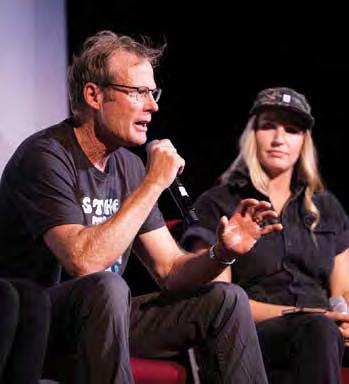
“It was when you were happy to get a raincoat and a sleeping bag and a tent,” he laughs. “You’re still living on top ramen, living the dream.”
Things aren’t the same—not only for Anker, but for climbing in general. “It was vastly different 30 years ago,” he says. “Free Solo hadn’t changed the world of what climbing was, and these landmark achievements—Lynn Hill freeing The Nose [on El Capitan]—still hadn’t happened that brought climbing into the public awareness.”
Indeed, Jimmy Chin and Elizabeth Chai Vasarhelyi’s film documenting climber Alex Honnold’s free solo of the face of Yosemite’s El Capitan hoisted climbing out of the depths of dirtbag relegation and into the spotlight when it won the Academy Award for Best Documentary Feature in 2018; and in 2020, sport climbing debuted in the Olympics. Unlike when Anker found it, today climbing is in the mainstream.
“Now it’s like, ‘Oh, I saw a Red Bull advertisement on YouTube, I’m going to the climbing gym, and then you climb 5.10 your first day out because it’s a bucket haul,” Anker says. “But back in the day it was like backpacking, and brown 1-inch webbing on all the carabiners, and this community of like, I’m going to teach you how to belay because you literally have to have someone show you the ropes.”
As with any populous facing rapid growth, the climbing community faces a choice: subscribe to the gatekeeping ethos
that often tinges outdoor recreation, or hold the door open. Anker’s opting for the latter, and he’s got the sway to pull the community with him. It’s a stance he’s taking in his own town.
Twenty minutes from his house near downtown Bozeman is Hyalite Canyon. Hyalite is the most heavily visited recreation site in Montana and somewhat of a climbing mecca, especially during the winter when climbers from near and far flock to the nearly 150 ice and mixed routes in a mere 3-square-mile area. Here, Anker reigns supreme.
Every climbing area has a steward, or a sort of steward, Anker says. Hyalite is just one of many places Anker fills this role. He knows that label comes with a responsibility to determine the tone of a place—to set the bar for community.
“On the trade routes in town, let’s make them safe, let’s make them accessible, make them welcoming,” he says. Hyalite sees 40,000 visitors a winter, he says. By welcoming new people, we’re not destroying any construct of ‘wilderness.’”
Anker met Ainuu at Spire, Bozeman’s local climbing gym, something like seven years ago, after which Anker joined Ainuu and his friends in Hyalite to climb at an area called Practice Rock. After that, Ainuu says Anker played a role in getting him into ice climbing. That first season, Ainuu says he went to Hyalite 40 or 50 times and was hooked. Today, he joins Anker as a North Face-sponsored athlete. Last year, the now-28-year-old climbed Mount Everest with a team called Full Circle, the first all-Black team to summit Everest. The seven-person cohort, plus eight Nepali guides, nearly doubled the previous total of 10 Black people to summit the world’s highest peak.
Ainuu moved from Washington to Montana in 2013 to study geology at Montana State University. Born in Harbor City, California, Ainuu spent the first few years of his life in Los Angeles. When he was 9, his parents moved him and his
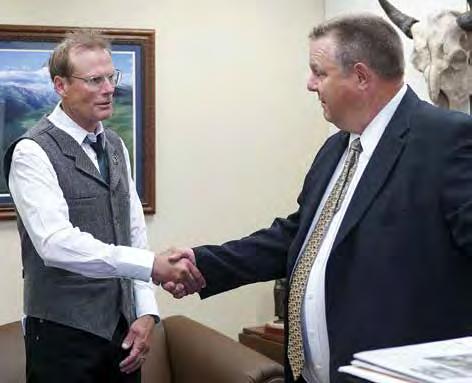
160
Above left: Anker shakes hands with Sen. Jon Tester in Washington D.C. Tester represents Montana, Anker's home state, as a Democrat in the U.S. Senate. Photo by Leigh Vogel. Above: Anker speaks on stage in Bozeman next to fellow Protect Our Winters athlete Amie Engerbretson at a Stoke the Vote event in 2022. Photo by Jake Burchmore.
sister to Spokane, where he was introduced to skiing and some climbing, but it wasn’t really until he moved to Bozeman that he became invested in climbing.

Anker is nearly 30 years Ainuu’s senior, but it doesn’t really make a difference when they’re climbing. After years now of sharing a rope, Ainuu considers Anker a mentor.
“[Conrad] is one of the most … famous climbers, but he’s always taking new people out climbing, and pushing not just the sport, but our community, and also politics. He’s using his platform to make a change,” Ainuu says. “… I share a lot of the same views, and climbing is a cool way to experience empathy, I think, because the thing is, we could be so different, but if we climb together, we’re doing the same thing. And it’s all good.” Community is not stagnant in time, Anker suggests, but rather generationally expansive. People are vessels of wisdom, and community is the container in which it’s shared.

“In any community, there’s a collective of people, from those with wisdom and experience to those that are young and that are getting into it,” Anker says. “And so all of them serve a point in time and so when I was mentored, starting with my dad’s buddies and my dad, and then I had a mentor that was 14 years older than me, they helped me out. Now I’m mentoring other people and I’ve been doing that for as many people as I can.”
One mentor Anker has discussed in myriad interviews is Terry “Mugs” Stump, an acclaimed climber whom Anker credits as his inspiration for climbing Mount Meru, an ascent that not only was captured in an award-winning documentary, but one that Anker has described as the culmination of all he had accomplished as an alpinist. Stump died when he fell into a crevasse while descending the South Buttress of Denali in 1992.

As much as partnership is a pillar upholding the climbing
community, loss is its counterbalancing contra. Again, Anker compels the religion of gravity in which death is doctrine. Loss is a part of the climbing community; in fact, he says it’s what makes it significant.
“That is why climbing is so special … it’s because we die. And that cost makes it so real,” he says. When he talks about this, Anker closes his eyes, and it’s as if he leaves the room. He takes deep breaths until he’s ready to return. There’s a shift in philosophy when you discuss death at such a scale.
“We have this one life to live,” he says. “There is no afterlife. We’re ruled by the laws of the universe here, by gravity. We struggle with gravity as a way to worship gravity and eventually gravity is going to win and … our carbon is going to be recycled back into this earth. And when that happens, great, and you lived in the moment, but at this point, [at this] age, I’m far more accepting of it.”
He accepts it, and he also has his own ways of honoring it. Anker’s named a number of routes in Montana, as well as all over the world, for people he’s lost. Here at the Retirement Wall, he and Ainuu developed a route they call Yeti Cowboy, named after late local climber Travis Swanson, who in 2019 died in a climbing accident on Mount Cowen in the Absaroka Range. When Anker climbs these routes, it transforms the community’s paradigm of loss to one of celebration. Each move on the rock is like a dedicated line of poetry, the route itself an elegy. We don’t remember these climbers for how they died; we remember them for what they loved.
Above the waterfall sanctuary, a vast wall invites Ainuu and Anker for their last climb of the day. These routes are long, many with more than one pitch of continues jugs and ledges.
161
Above: Anker shows off a sign in Moab, Utah, that reads: "I'm pledging to protect the places we love by speaking up." Photo by Aaron Blatt. Above right: Anker sits beside Jeremy Jones, professional snowboarder and founder of POW, at a POW leadership summit in Nevada. Photo by Holly Shankland.
Anker rests on a rock and gobbles a granola bar.
So much of a day out climbing looks like this: the moments in between pulling on rock spent talking, eating, laughing, remembering. To an outsider, climbing can appear a solitary act. But it's far from that.
Anker, who even late in life is pulled in so many directions, seems ever present in each moment he inhabits. Tomorrow, he’ll sit in front of a camera for another interview before celebrating Mother’s Day with his wife and sons. Then he’ll board a plane to Alaska for more filming, in between Zoom calls for a nonfiction writing project which he’s giddy about (the project, not the Zoom calls). He jokes about his endless list of to-dos, but there’s no question that he’s here with us, in the Gallatin Canyon, completely. It’s what he loves about climbing.
“There's something about climbing because it activates the very oldest part of our brainstem and uses the front part of it— you know, this is autonomic function,” he says. “But then we use the prefrontal which is cameras and cars and TikTok and Republican obstructionists and all the other crap that we have to deal with. But when you go climbing all of a sudden that's out of there. You have to be in the moment.”
Anker’s spent much time in this ever-present space, clinging to the side of mountains most of us will only ever see in his films. But even this sport, that demands alertness and complete focus in the moment, has something to teach us about foresight.
“Our generation, where we are now, we need to think about not doing harm to future generations … and I think climbing is that way because it's a long-term goal that you don't always get, and that teaches you to appreciate the now but also to prepare for the future,” Anker says.
Anker speaks about climbing as a sort of holy book for community, but his recent work on the athlete alliance for environmental nonprofit Protect Our Winters (POW) and related advocacy work has him translating its lessons beyond the crag.
“Not everyone is gonna go out rock climbing and do things like that, [but] we need to work together towards that common goal, which is decency, solving things for the future and investing in the future …” he says.
Anker is a leading member of POW’s athlete alliance, with notable stories about mobilizing entire live audiences to engage in political calls to action as proof.
“Conrad is an inspirational spokesperson on the importance of climate advocacy and civic engagement,” said POW Executive Director Mario Molina. “He is a draw for outdoor community members to POW events; he has access and influence with elected officials and decision-makers at the local, state and federal levels. He is bold in his positions when he knows them to be right, which is catalytic in moving our community towards action.”
Equally as illustrative of Anker’s community work is his resume with The North Face, one of the outdoor industry’s leading brands. Anker started working for the company 40 years ago as an employee and 36 years ago as a sponsored athlete, 26 of those years serving as the brand’s athlete team captain. After what he describes as a self-reckoning with his privilege as a white male, he’s involved himself in Diversity,
Equity and Inclusion work with The North Face. Some of this is done through Memphis Rox, a nonprofit climbing gym in Memphis of which Anker is on the board whose mission is to “bring rehabilitation, healing and a renewed sense of hope to challenged communities by providing a climbing facility and programs that foster relationships across cultural, racial, ethnic and socio-economic backgrounds,” according to the organization.
In 2020, Black Ice, a film Anker said he came up with, screened across the country and showed the story of a group of aspiring ice climbers from Memphis Rox journeying to Montana where they were mentored by Anker, Ainuu and Fred Campbell. Anker says he’s connected The North Face with these projects as a sponsor.
Anker is in his age of advocacy, fighting for community that extends beyond rock walls and frozen waterfalls. He calls it “good trouble,” a nod to U.S. Congressman and civil rights activist John Lewis, of whom he has a 3-foot-by-5-foot portrait of hanging in his office.
Good trouble seems appropriate. He gets lit up when he talks about the societal infractions that ail him: violent capitalism, a lack of accountability for those in power and a penchant for immediate gratification. During our interview at his home, he becomes riled, turning his gaze directly into the camera as he condemns recent action in the Montana Legislature that saw transgender Rep. Zooey Zephyr banned from the House Chamber for breaking decorum when speaking against bills she argued would harm trans people and their community.
“Damn you elected officials in Montana that are driving on the wrong side of the road and you know who you are,” he says. “You know what the f*** you're doing. Stop playing chicken with national debt; taking the belay out while we’re climbing, tying knots in each other's rope.”
His anger is earnest, primal even, and in these spells of passion, he embodies the spirit of saboteurs for justice the likes Edward Abbey’s fictional George Hayduke from The Monkey Wrench Gang. One of the book’s quotes hangs over his head like a halo: “There comes a time in a man's life when he has to pull up stakes. Has to light out. Has to stop straddling, and start cutting, fence.”
Passionate as he is, Anker isn’t cutting any fences these days. He’s leading campaigns to get people to the polls; he’s writing op-eds; he’s lobbying in Washington D.C. It’s his medium of change, his outlet for unrest. But the fight lives in him like a fire; he demands more.
The week before we met, Anker was toiling over an op-ed he was writing for Bomb Snow magazine. The topic: climate optimism. He scoffs a bit when he says these words together, like they’re sticky from being glued together. Maybe he doesn’t think of himself as a fountain of faith, but seeing him out on the rock, speaking belay, his movement congruent with land, with self, with partner, I bask in that ethereal green light and the mist of the waterfall and feel its promise.
This language is hope.
162
Bella Butler is the Managing Editor of Mountain Outlaw magazine.
“NOT EVERYONE IS GONNA GO OUT ROCK CLIMBING AND DO THINGS LIKE THAT, [BUT] WE NEED TO WORK TOGETHER TOWARDS THAT COMMON GOAL, WHICH IS DECENCY, SOLVING THINGS FOR THE FUTURE AND INVESTING IN THE FUTURE.”

– CONRAD ANKER
Anker climbs on the Retirement Wall in Gallatin Canyon.
406-581-4904

Flexible space for recreational vehicle storage, automobile collections, luxury garage suite, store inventory or supplies, man-cave, creative space, small business space, warehousing, shipping, project space, home away from home, etc.


FOR SALE | SUMMER 2023
14’ x 14’ garage door


1500 - 3000 sf units with private restrooms
Insulated and heated lowmaintenance metal building
Only 5 minutes from the Arrival
Terminal at Bozeman Yellowstone International Airport
For business or personal use, limited only by your imagination.


JERECO JERECO STU DIOS 45 RPM STEREO Bozeman MT Lighting - AV INSTALL Sound - DESIGN
NEW WAREHOUSES/STORAGE UNITS CLOSE TO THE AIRPORT
BOZEMAN YELLOWSTONE INTERNATIONAL AIRPORT JACKRABBIT LANE
24UNITS
6UNITS
BOWENCONSTRUCTION.NET FRONTAGEROAD






165 © 2023 BuzzBallz, LLC, Carrollton, TX. Please Enjoy Responsibly. Mountain Standard Team @ Compass GENEROUSLY PRESENTS thursdays Victor City Park Enjoy Community Supported Music Stay & Play in Teton Valley! Visit tetonvalleyfoundation.org for 2023 dates. ©LINDA M. SWOPE © LINDA M. SWOPE ©LINDA M. SWOPE
Personalized mortgage options to fit your financial strategy


Customized mortgage options include:
• Residential one to four units, fixed, adjustable or interest only mortgage options

• Mortgage priority process, products and scheduling to meet your loan closing date
• Primary, second home, condominium, co-op and investment one to four unit properties
• Residential single close construction, lot loan, renovation & expansion options
• Conforming, jumbo and super jumbo loan size availability
• Lending in all states (some loan types are limited to specific states)
166
terms are subject to change without notice. Visit usbank.com to learn more about U.S. Bank products and services. Mortgage and Home Equity Products are offered through U.S. Bank National Association. Deposit Products are offered through U.S. Bank National Association. Member FDIC. Loan approval is subject to credit approval and program guidelines. Not all loan programs are available in all states for all loan amounts. Interest rates and program
Gina Marshall Private Wealth Mortgage
gina.marshall@usbank.com
Banker 406-522-3293 office 406-600-8699 cell
NMLS#: 489006
May 29 – September 3, 2023

Da Vinci The Exhibition is a hands-on examination of da Vinci’s life, research, and art. Visitors will learn about da Vinci’s complex beginnings and lifetime achievements through his discoveries in art, engineering, flight, hydraulics, music, light, and more. The exhibit features more than 60 fully built, life-size inventions, more than 15 fine art studies, and dozens of stunning displays.
Da Vinci The Exhibition was developed by Aurea Exhibitions and produced by Imagine Exhibitions, Inc.

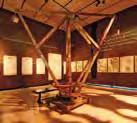





LEAD SPONSOR
Chris McCloud and Stephanie Dickson Charitable Fund

museumoftherockies.org | 406.994.2251 | 600 W. Kagy Blvd.
A BENEFIT FOR RIVER CONSERVATION


BIG



SATURDAY, AUG. 5
SUNDAY, AUG. 6
LORD HURON
LORD HURON
JAMES MCMURTRY
JAMES MCMURTRY
REGINA FERGUSON
REGINA FERGUSON
FOO FIGHTERS
FOO FIGHTERS

THE BREEDERS
THE BREEDERS
TAIPEI HOUSTON
TAIPEI HOUSTON
FRIDAY, AUG. 4
HOOKED ON THE GALLATIN CHARITY DINNER
HOOKED ON THE GALLATIN CHARITY DINNER
SPEAKER PANEL WITH TOM SKERRITT & FRIENDS
SPEAKER PANEL WITH TOM SKERRITT & FRIENDS
COMEDY BY ORLANDO LEYBA & FORREST SHAW
COMEDY BY ORLANDO LEYBA & FORREST SHAW
wildlandsfestival.com
is dedicated to raising funds for preservation of riversa portion of all ticket sales benefit American Rivers & Gallatin River Task Force
SKY, MONTANAAUGUST 4-6 Wildlands Festival
LAST LIGHT
On April 23, 2023, aurora borealis lights painted the sky above the Greater Yellowstone Ecosystem. The purple and green waves fractured the dark night sky, touching everywhere from the asphalt streets of Bozeman to the springtime glacier lilies in Yellowstone National Park. These northern lights are a reminder that in this wild landscape, awe is the connective tissue that joins our area’s humans, wildlife and land in community. In celebration of this notion, we offer a passage from writer Kathleen Dean Moore to close this issue.

–The Editors
“A sense of wonder that allows us to see life as a beautiful mystery forces us to see life as something to which we owe respect and care. If this is the way the world is: extraordinary, surprising, beautiful, singular, mysterious and meaningful; then this is how I ought to act in that world: with respect and celebration, with care, and with full acceptance of the responsibilities that come with my role as a human being privileged to be a part of that community of living things. Wonder is the missing premise that can transform what-is into a moral conviction about how one ought to act in that world.” –Kathleen
Dean Moore, The Truth of Barnacles
Northern
169
lights are mirrored in a Yellowstone National Park hot spring on April 23, 2023. Photo: Jacob W. Frank/NPS




lohssconstruction.com Specializing in new construction and custom remodels Big Sky, MT | (406) 581-1870 | jarviscustombuilders.com




171


923 N. 7TH AVE BOZEMAN, MT | 406.587.5423 | GV.FURNITURE Furniture | Rugs | Art | Accessories | Window Treatments | Lighting | Outdoor Open doors to timelessly beautiful exteriors, designed to inspire.








 San Francisco World Spirits Competition 2022
©2023 American Freedom Distillery. All rights reserved.
San Francisco World Spirits Competition 2022
©2023 American Freedom Distillery. All rights reserved.












































































































































 Jeremy Lurgio and his family trekked to the historic Medicine Point Lookout in the Bitterroot Mountains two years in a row during the lookout’s opening summer week. The photo essay on page 60 juxtaposes the family’s two adventures through drastically different landscapes due to the fickle nature of Montana mountain weather.
Jeremy Lurgio and his family trekked to the historic Medicine Point Lookout in the Bitterroot Mountains two years in a row during the lookout’s opening summer week. The photo essay on page 60 juxtaposes the family’s two adventures through drastically different landscapes due to the fickle nature of Montana mountain weather.
 Words
Words







 Top: Amelia trudges through deep snow in a final push to the 14-foot by 14-foot Medicine Point Lookout, which is perched on a 10-foot-tall tower at the top of Medicine Point at 8,409 feet. Bottom: Lachlan Lurgio looks out toward a smoky sunset as he hikes to the historic lookout, which has been restored to reflect a lookout of the 1940s.
Top: Amelia trudges through deep snow in a final push to the 14-foot by 14-foot Medicine Point Lookout, which is perched on a 10-foot-tall tower at the top of Medicine Point at 8,409 feet. Bottom: Lachlan Lurgio looks out toward a smoky sunset as he hikes to the historic lookout, which has been restored to reflect a lookout of the 1940s.


 Top: After a wet, cold climb to Medicine Point, Lachlan, left, and his sister, Amelia, curl up in a sleeping bag together, happy for the shelter and warmth at the lookout. Bottom: A year later, Lachlan, left, and Amelia, play a game of Pass the Pigs after a sunny summer hike to the lookout. The lookout provides a vast 360-degree view of the surrounding mountains and wilderness.
Top: After a wet, cold climb to Medicine Point, Lachlan, left, and his sister, Amelia, curl up in a sleeping bag together, happy for the shelter and warmth at the lookout. Bottom: A year later, Lachlan, left, and Amelia, play a game of Pass the Pigs after a sunny summer hike to the lookout. The lookout provides a vast 360-degree view of the surrounding mountains and wilderness.





















 Horses stand at the ready during a spring branding event. The epitome of community, sixth-generation Montanan Maria Lovely writes about the tradition of brandings in Lending a Hand on p. 86.
Horses stand at the ready during a spring branding event. The epitome of community, sixth-generation Montanan Maria Lovely writes about the tradition of brandings in Lending a Hand on p. 86.

 By Toby Thompson
By Toby Thompson








 The view of Amphitheater Mountain from Soda Butte in Yellowstone National Park. Ernest Hemingway Collection, John F Kennedy Presidential Library and Museum, Boston.
Top: Ernest Hemingway with hunting trophies from 1932. Ernest Hemingway Collection, John F Kennedy Presidential Library and Museum, Boston. Middle: Hemingway’s second wife, Pauline, leans against a cabin at the L Bar T Ranch in Wyoming circa 1932. Below: Hemingway with his loot of fish at Nordquist's Ranch in Wyoming. Ernest Hemingway Collection, John F Kennedy Presidential Library and Museum, Boston.
The view of Amphitheater Mountain from Soda Butte in Yellowstone National Park. Ernest Hemingway Collection, John F Kennedy Presidential Library and Museum, Boston.
Top: Ernest Hemingway with hunting trophies from 1932. Ernest Hemingway Collection, John F Kennedy Presidential Library and Museum, Boston. Middle: Hemingway’s second wife, Pauline, leans against a cabin at the L Bar T Ranch in Wyoming circa 1932. Below: Hemingway with his loot of fish at Nordquist's Ranch in Wyoming. Ernest Hemingway Collection, John F Kennedy Presidential Library and Museum, Boston.





















 By Jack Reaney
By Jack Reaney






 Left: Pat Williams teaching an elementary class in Butte, Montana.
Photo courtesy of Williams family.
Middle: Carol and Pat campaign in 1978. Photo courtesy of Williams family.
Right: Pat and Carol pose for a portrait for ACLU Montana. Photo courtesy of Williams family.
Left: Pat Williams teaching an elementary class in Butte, Montana.
Photo courtesy of Williams family.
Middle: Carol and Pat campaign in 1978. Photo courtesy of Williams family.
Right: Pat and Carol pose for a portrait for ACLU Montana. Photo courtesy of Williams family.




















 By Benjamin Alva Polley
By Benjamin Alva Polley

 A grizzly bear crosses the road in Yellowstone National Park.
Photo by Jim Peaco/NPS
A grizzly bear crosses the road in Yellowstone National Park.
Photo by Jim Peaco/NPS
 A rancher examines a dead calf killed by a predator on Andrew Bardwell’s ranch near Augusta, Montana.
Photo Courtesy Andrew Bardwell.
A rancher examines a dead calf killed by a predator on Andrew Bardwell’s ranch near Augusta, Montana.
Photo Courtesy Andrew Bardwell.










 Anna Middleton rides on a Big Sky trail.
Anna Middleton rides on a Big Sky trail.


















 Travis Winn leads a first descent of the Salween River in Tibet in 2007. In the distance the landslide was the mark of a large rapid later named "Waimea".
Travis Winn leads a first descent of the Salween River in Tibet in 2007. In the distance the landslide was the mark of a large rapid later named "Waimea".
 By Eric Ladd
By Eric Ladd











 Eric enjoying river trip with wife Kaley, niece Teagan Ladd and faithful river dog, Black “Betty”.
Eric enjoying river trip with wife Kaley, niece Teagan Ladd and faithful river dog, Black “Betty”.



 Cheyenne Frontier Days is a rodeo and Western celebration held in Cheyenne, Wyoming since 1897. Mountain Outlaw contributor Matt Crossman, a St.Louis writer, writes humorously about his first experience with Frontier Days in My First Cowboy Hat on p. 142.
Photo by Tom Fries.
Cheyenne Frontier Days is a rodeo and Western celebration held in Cheyenne, Wyoming since 1897. Mountain Outlaw contributor Matt Crossman, a St.Louis writer, writes humorously about his first experience with Frontier Days in My First Cowboy Hat on p. 142.
Photo by Tom Fries.
































































































